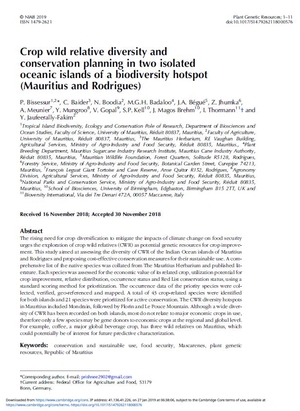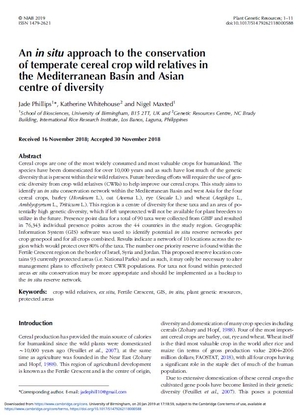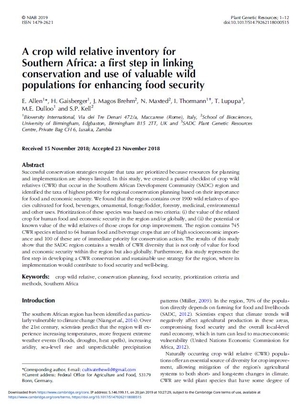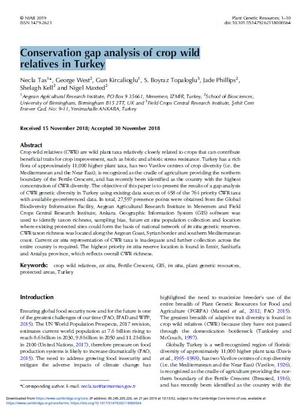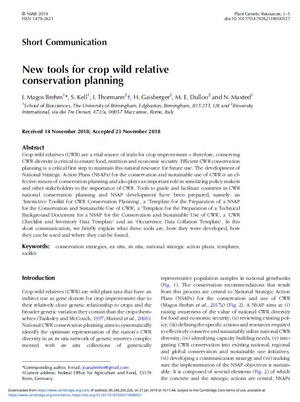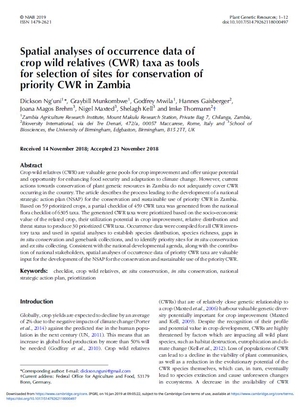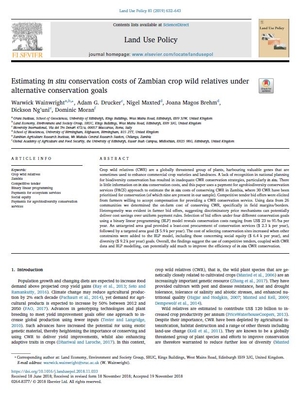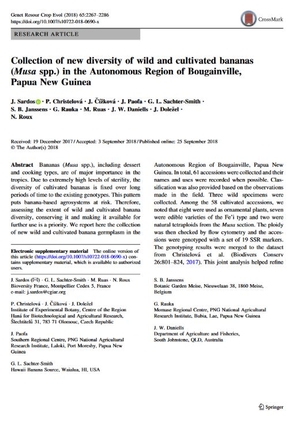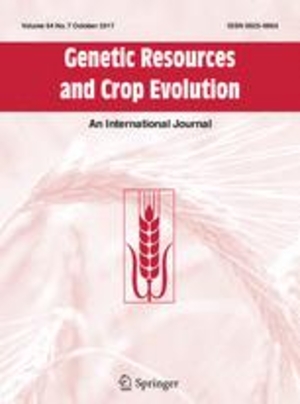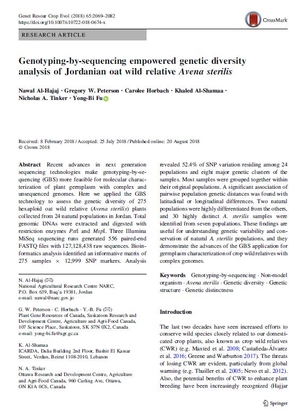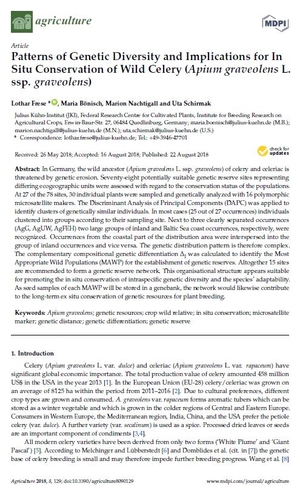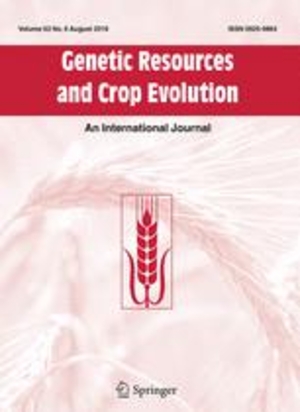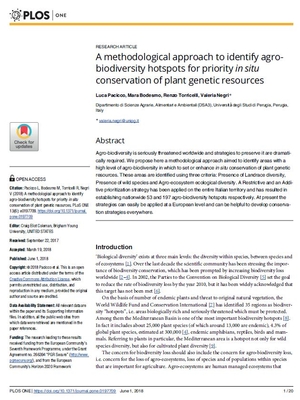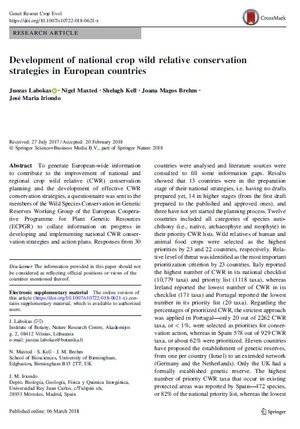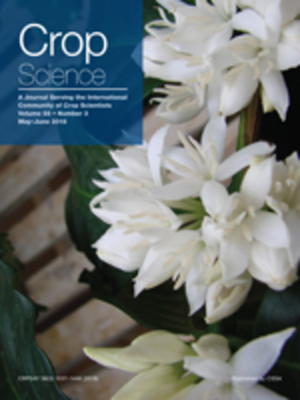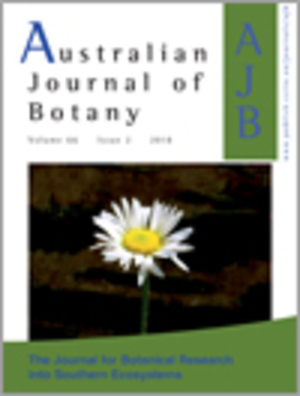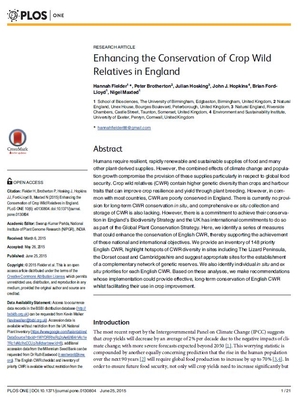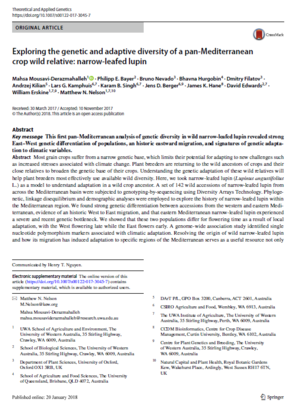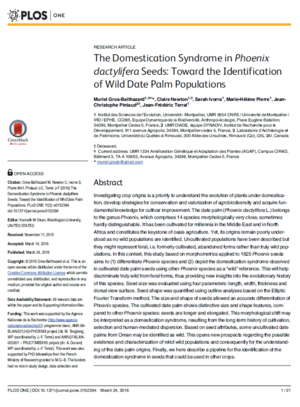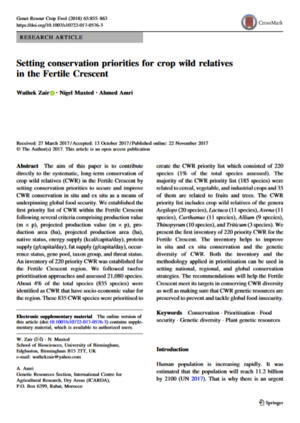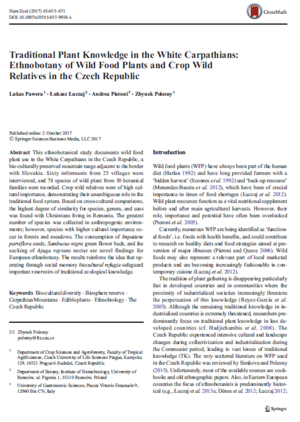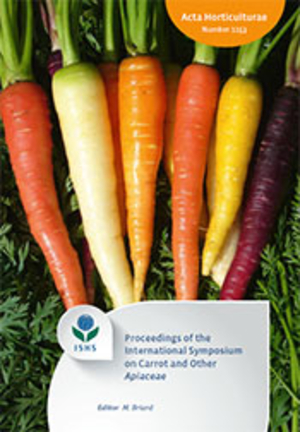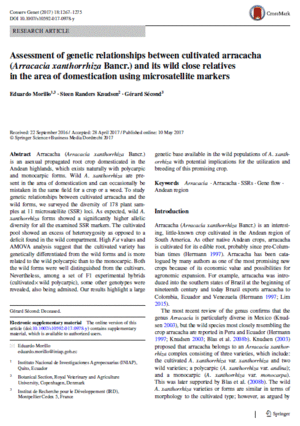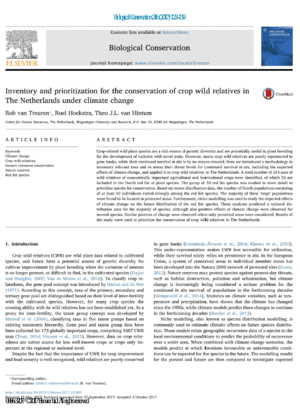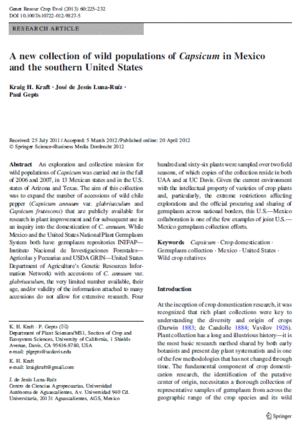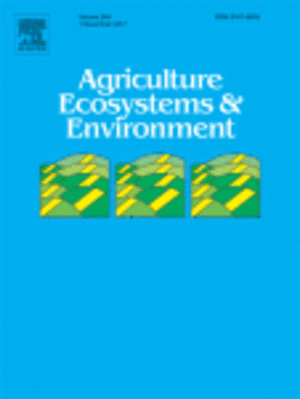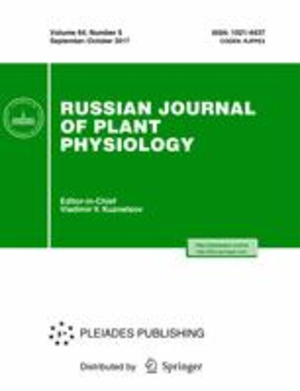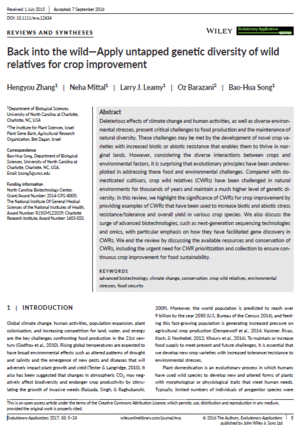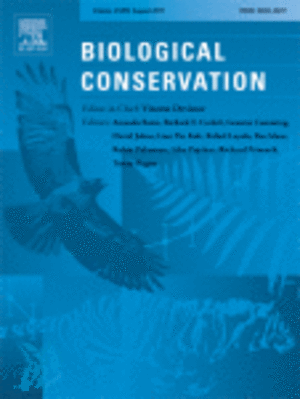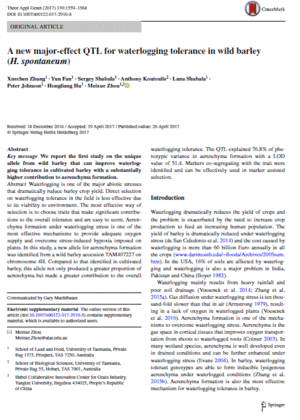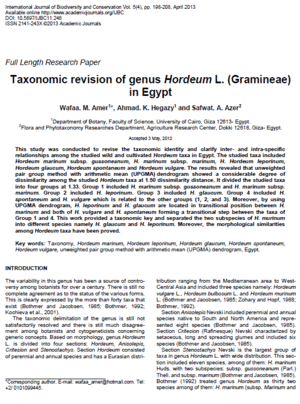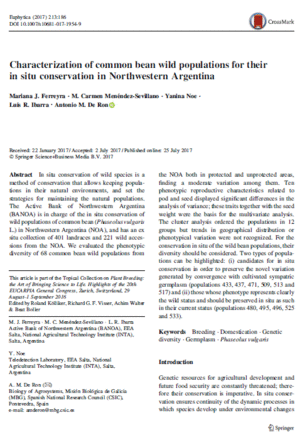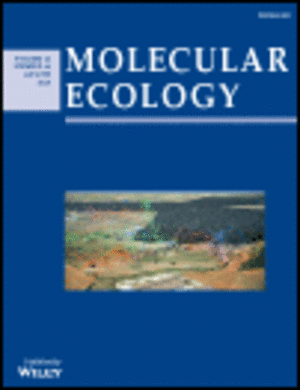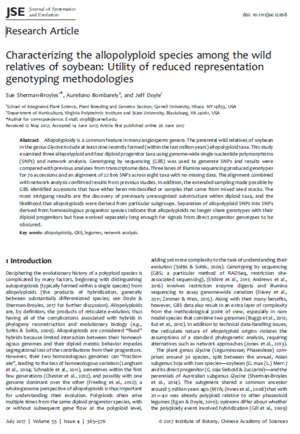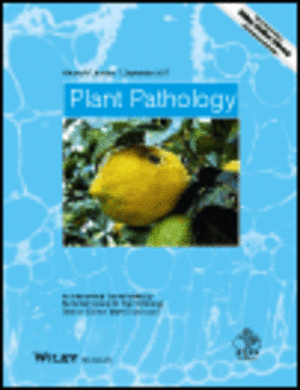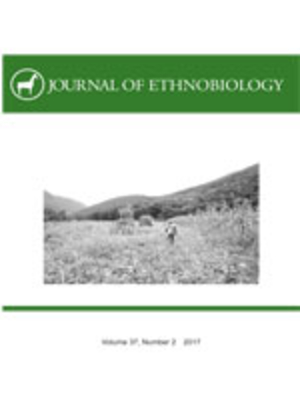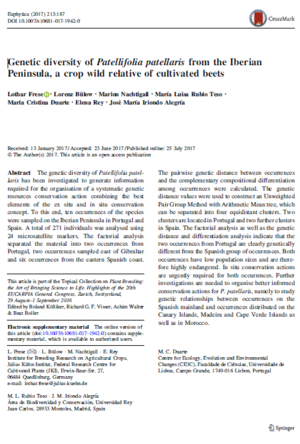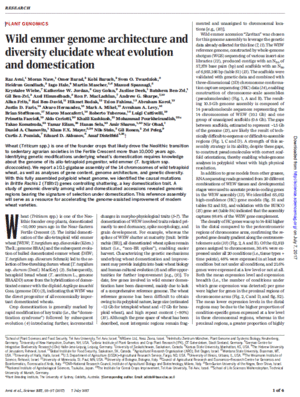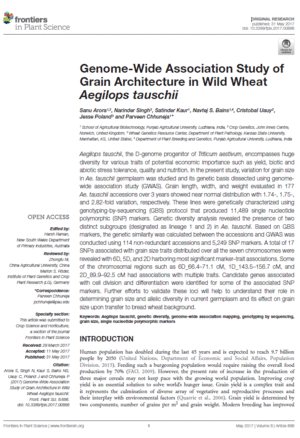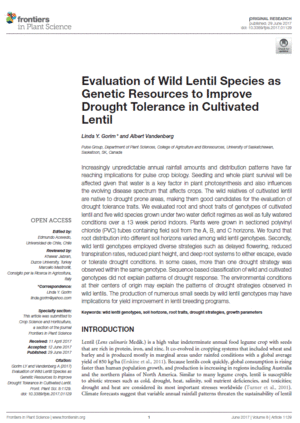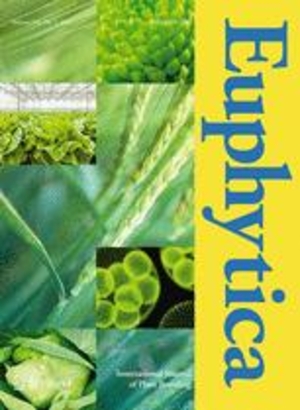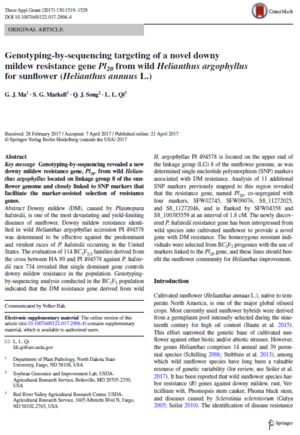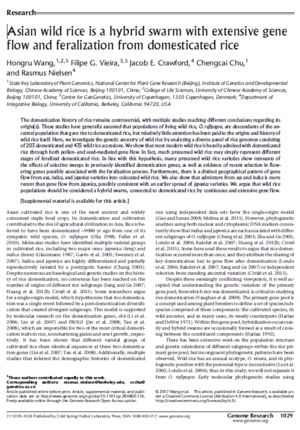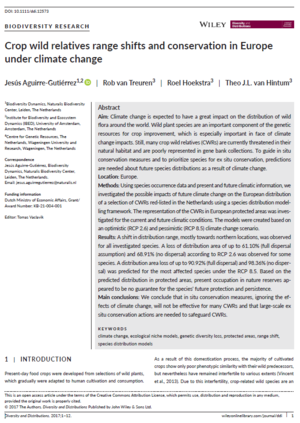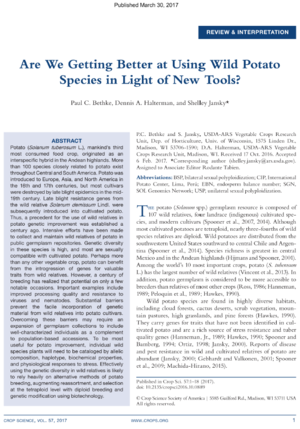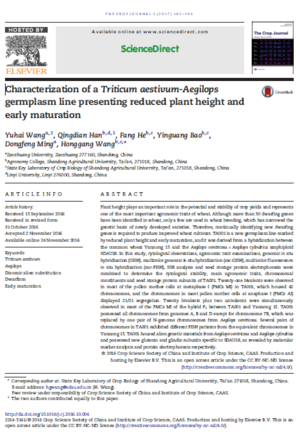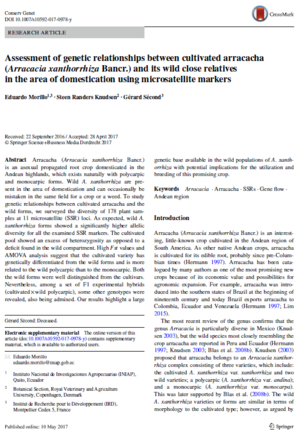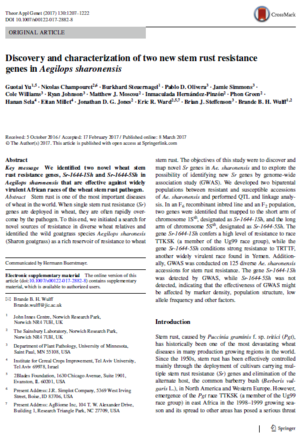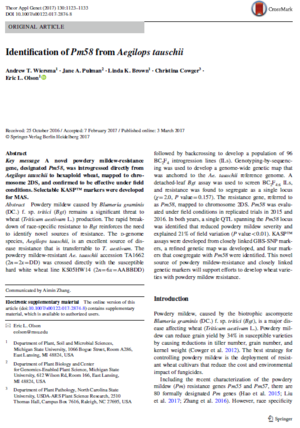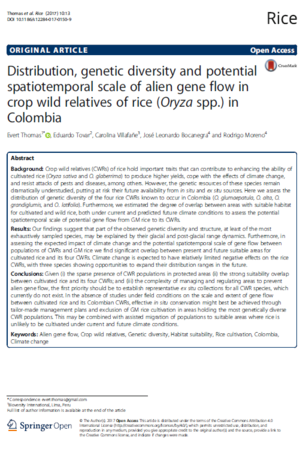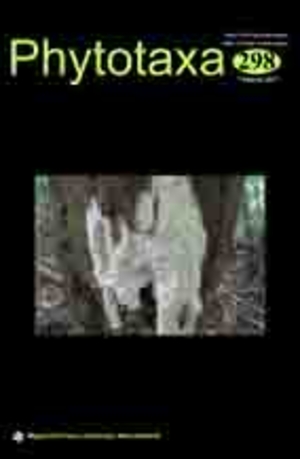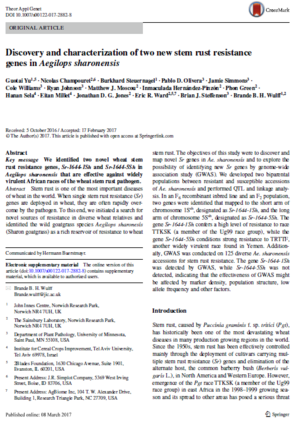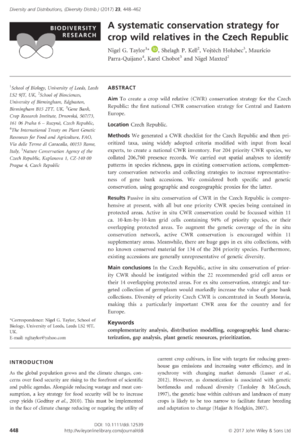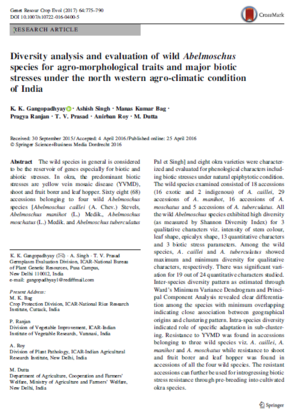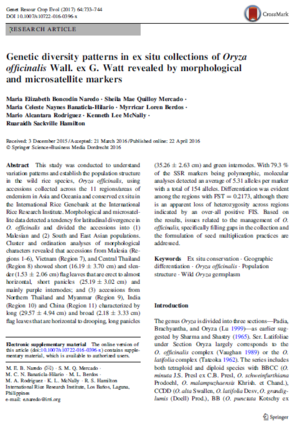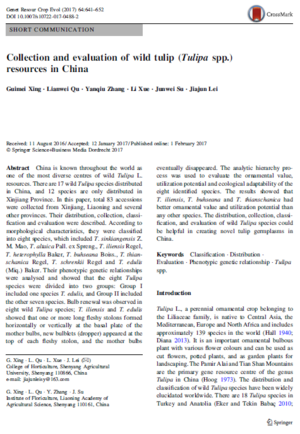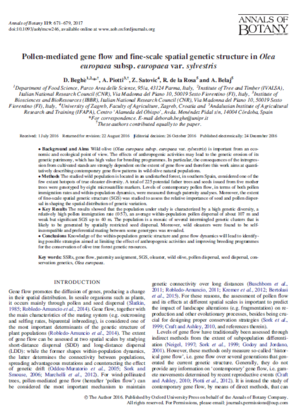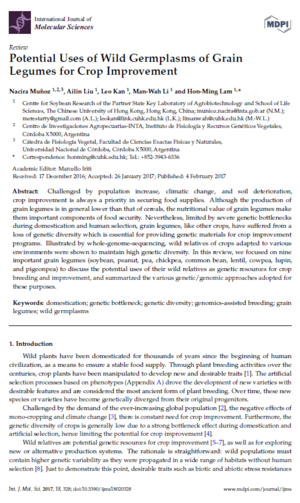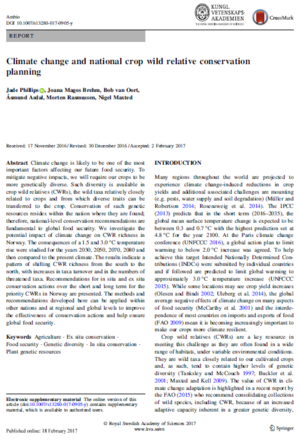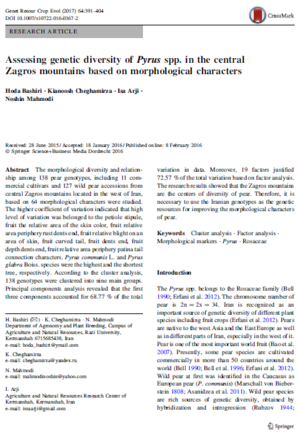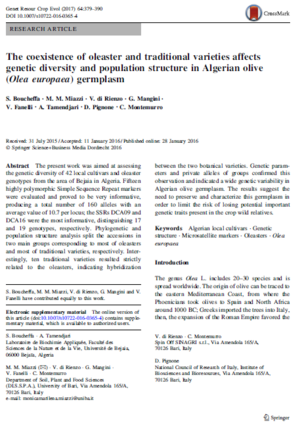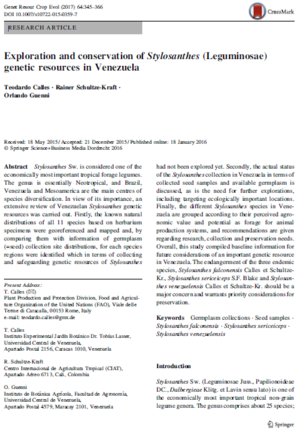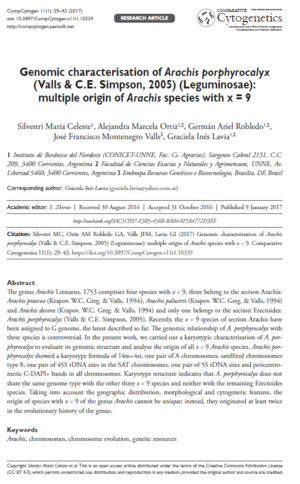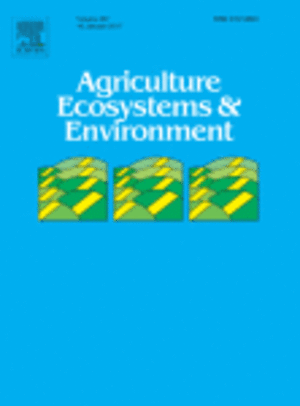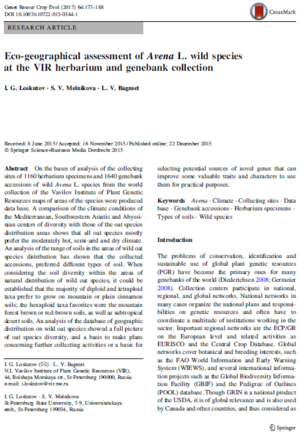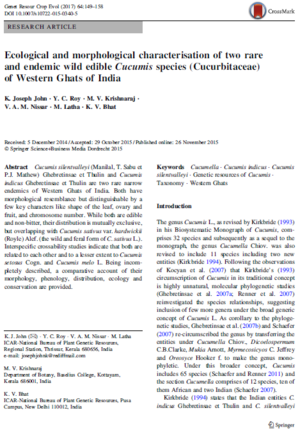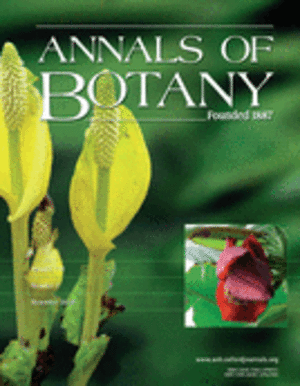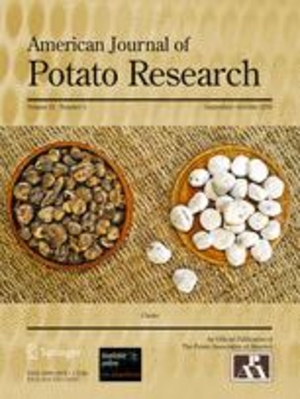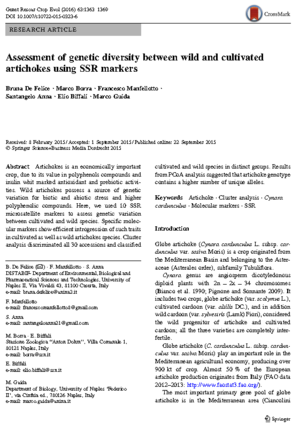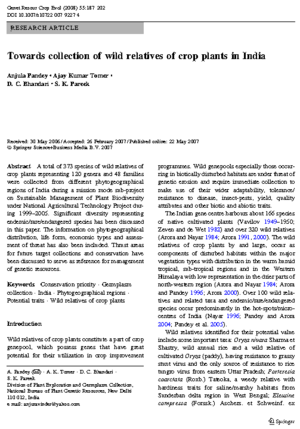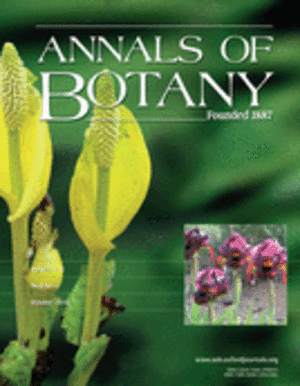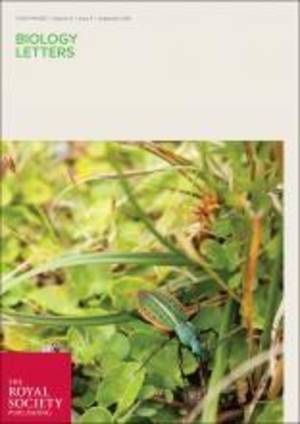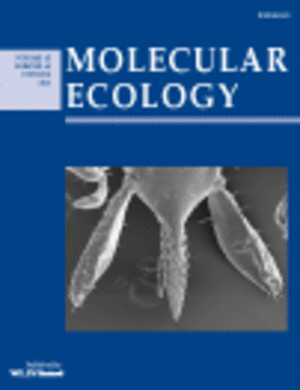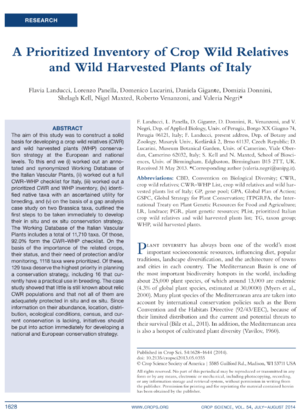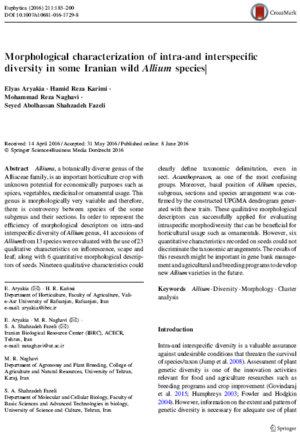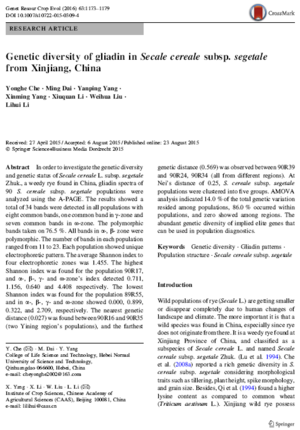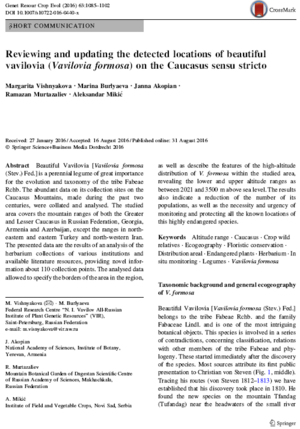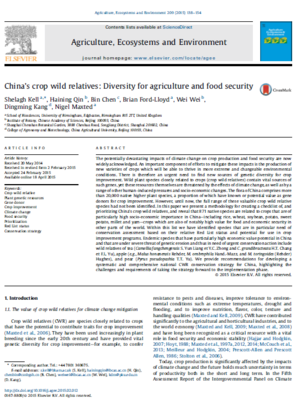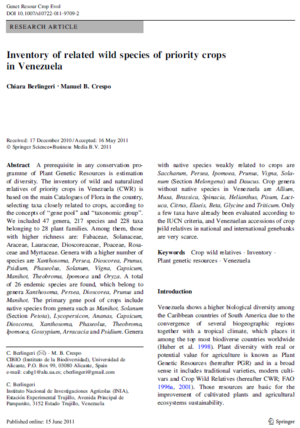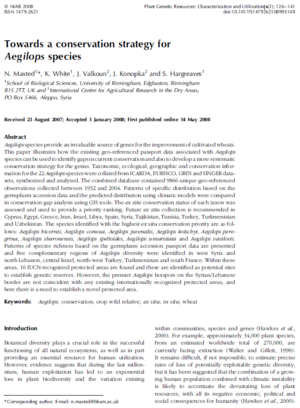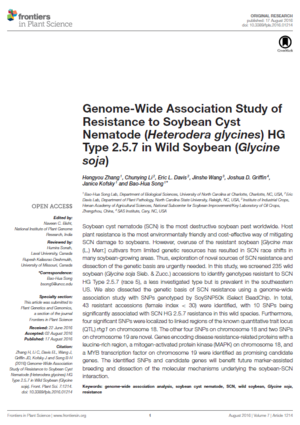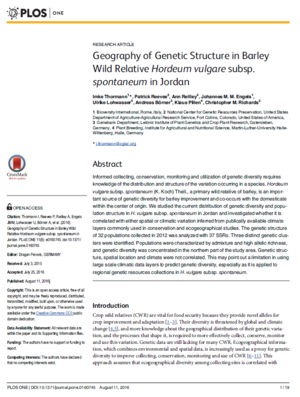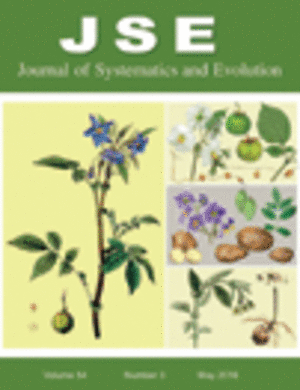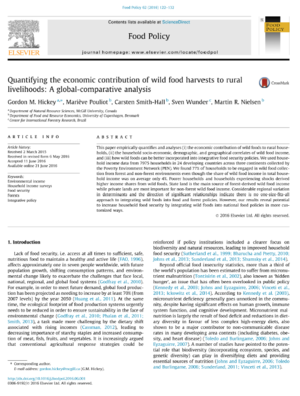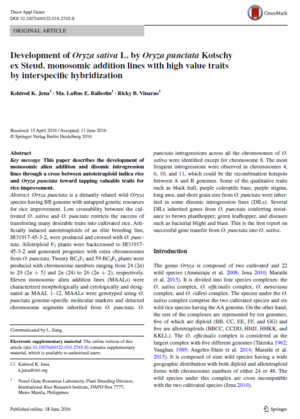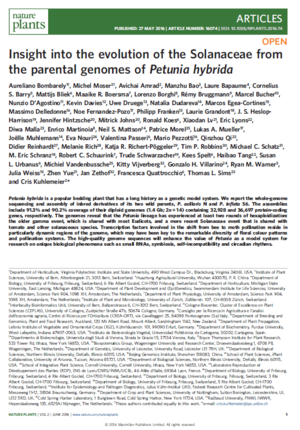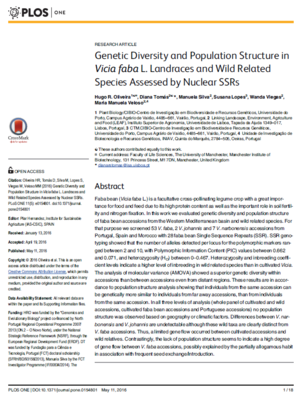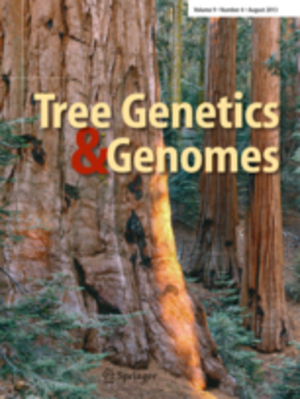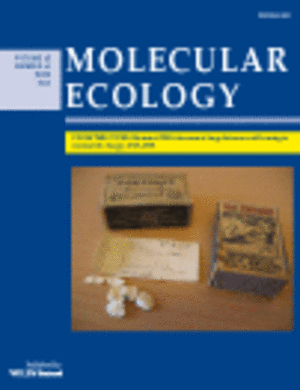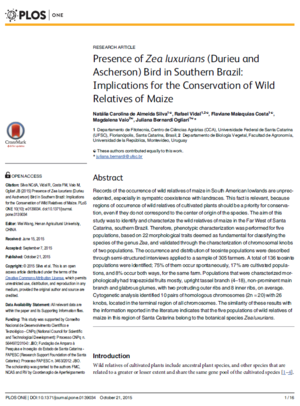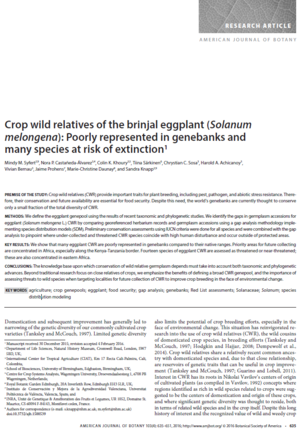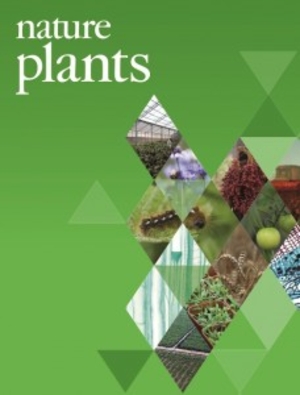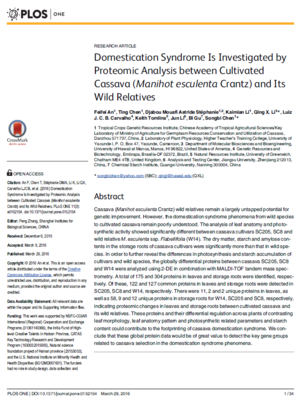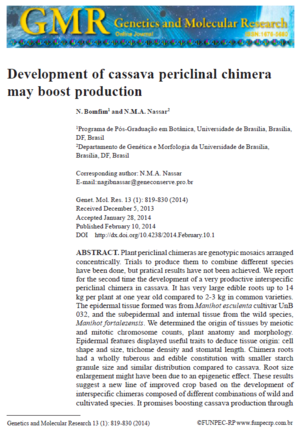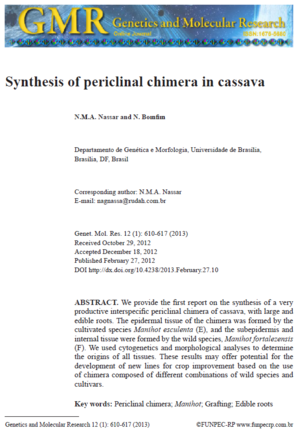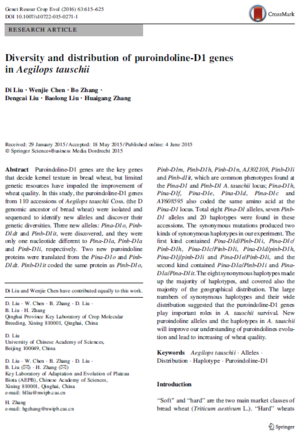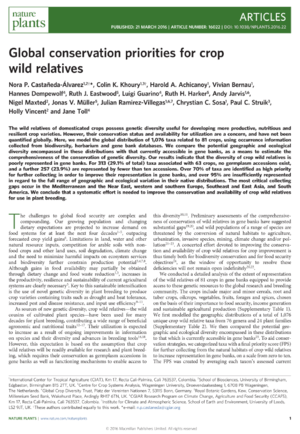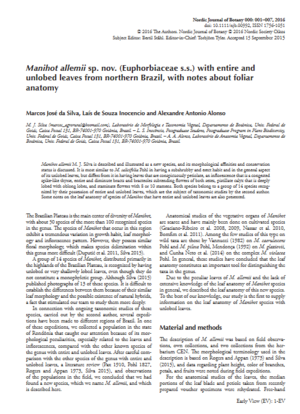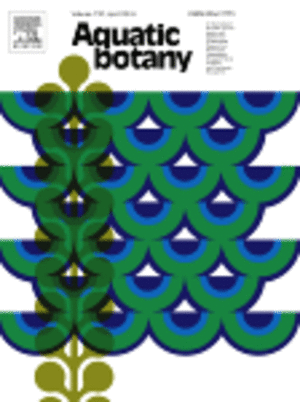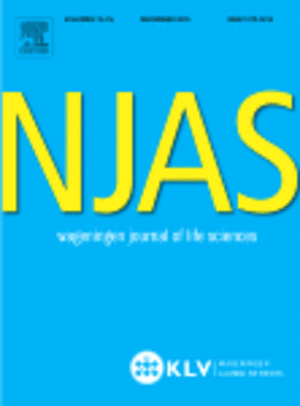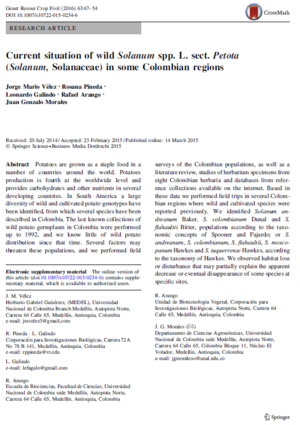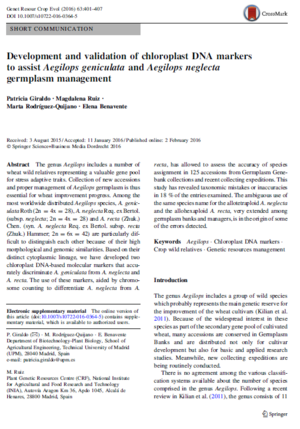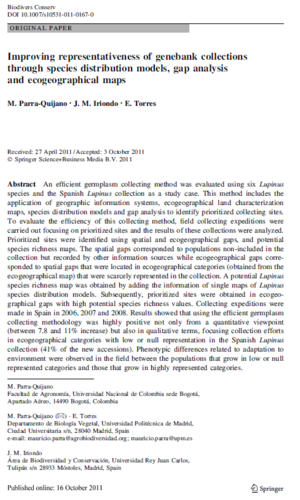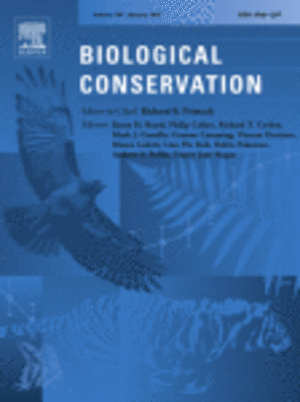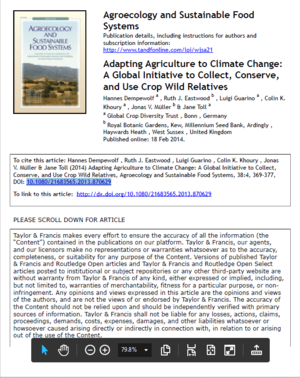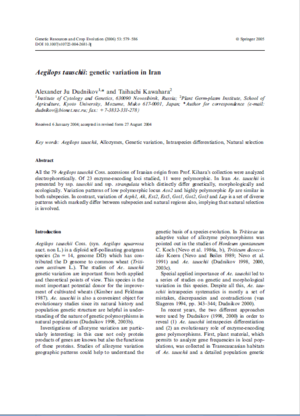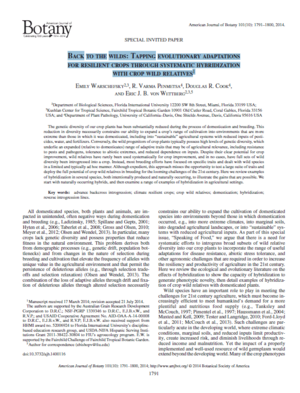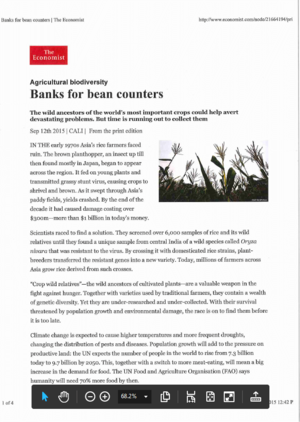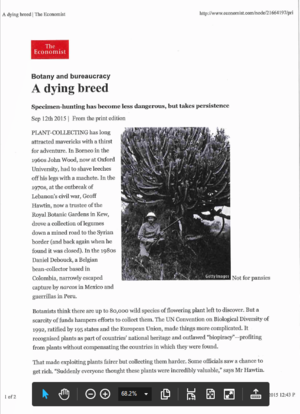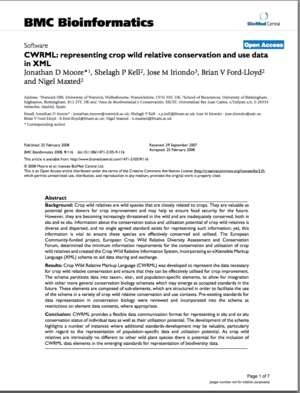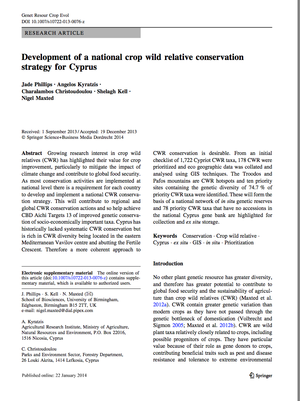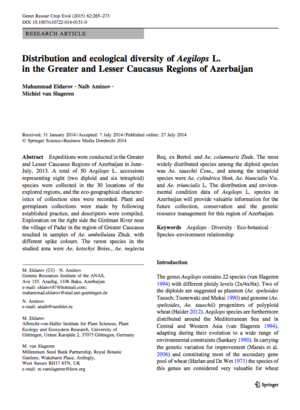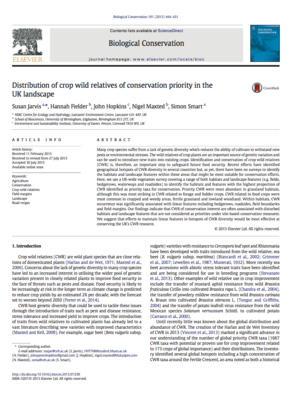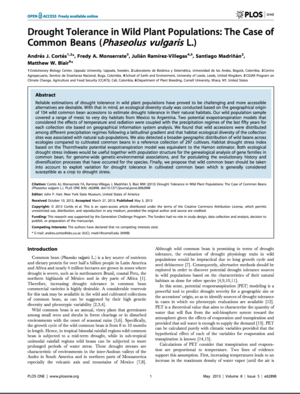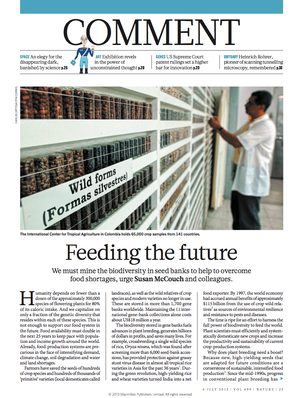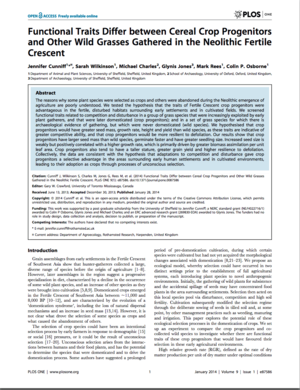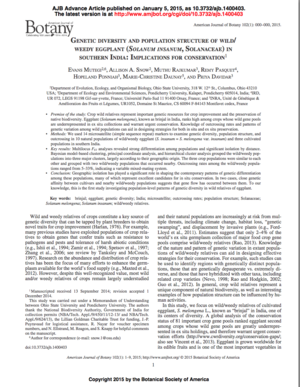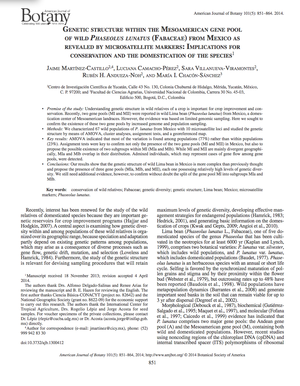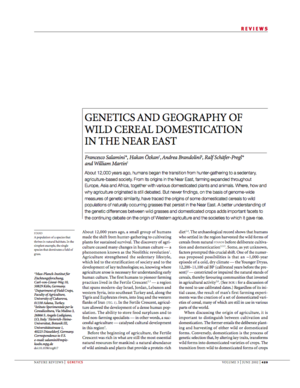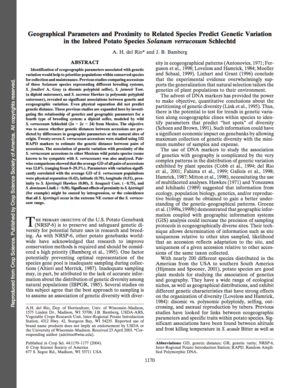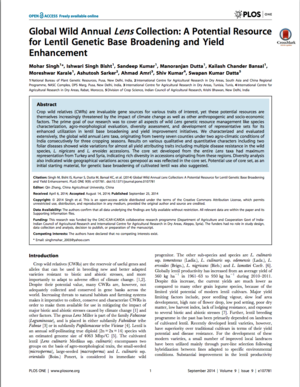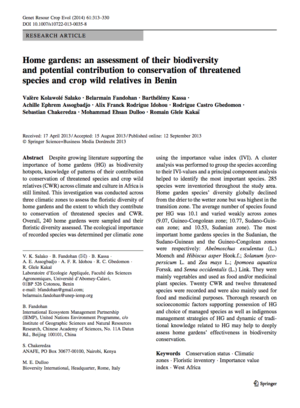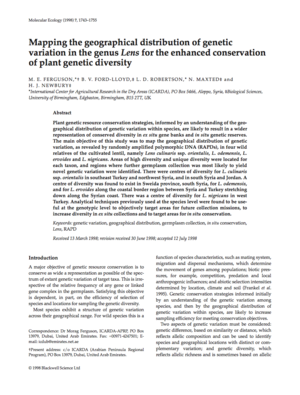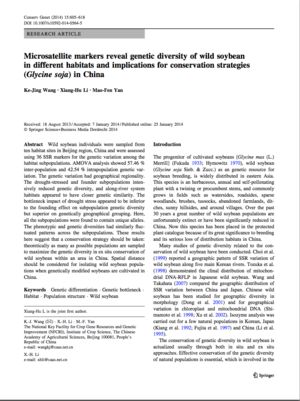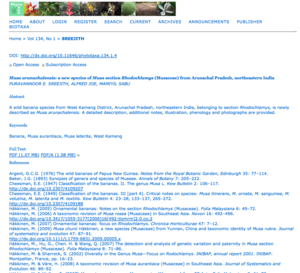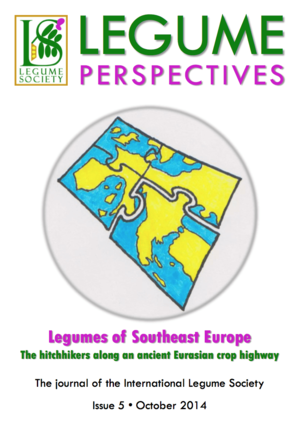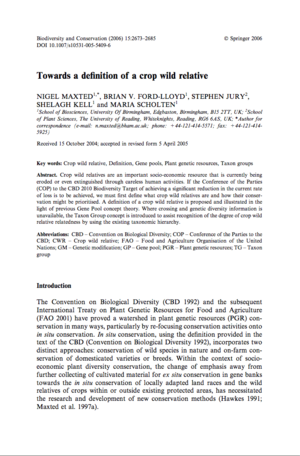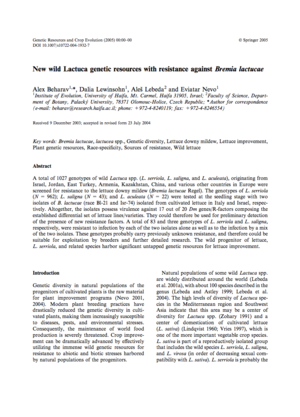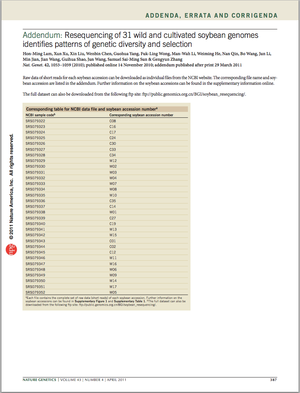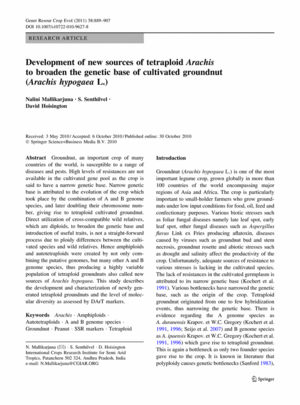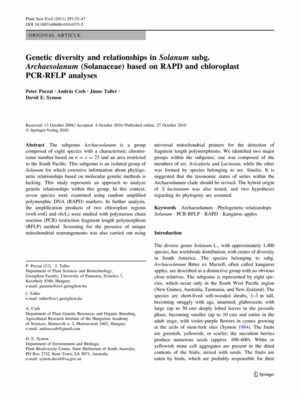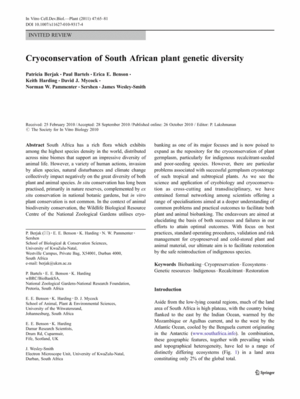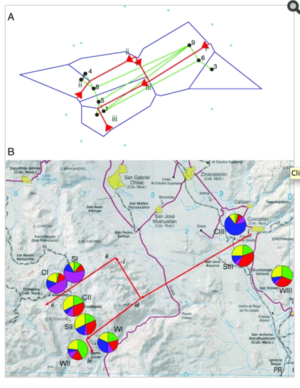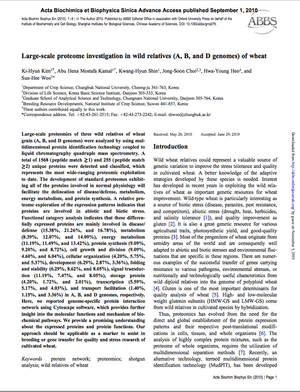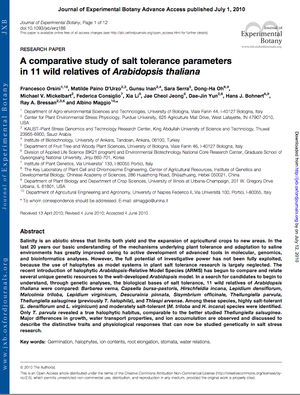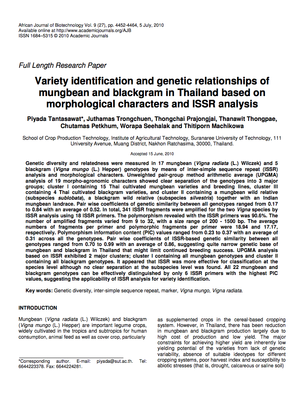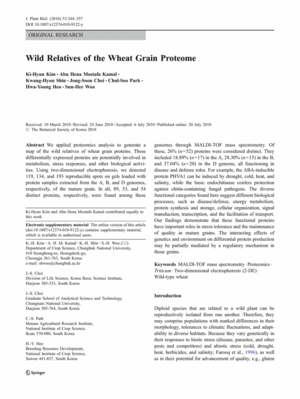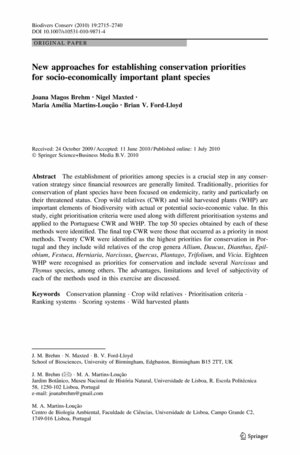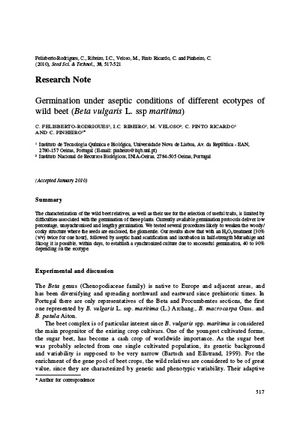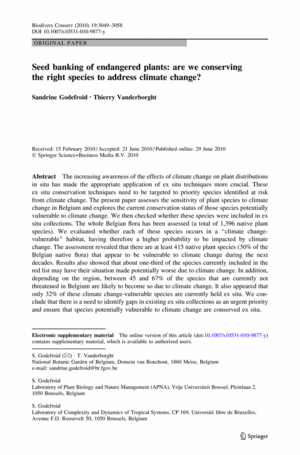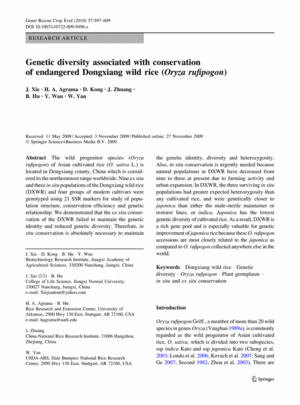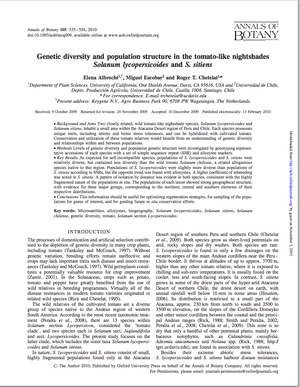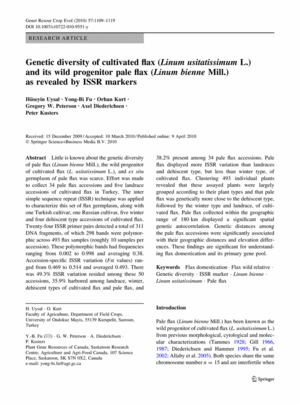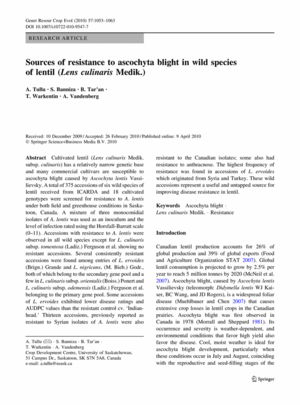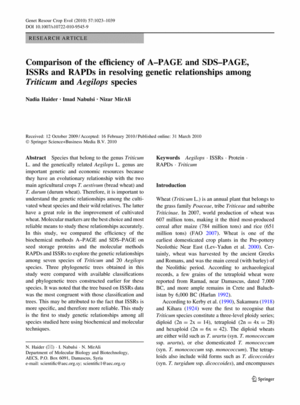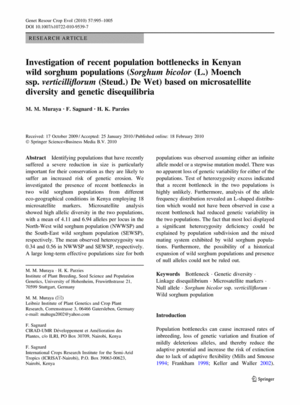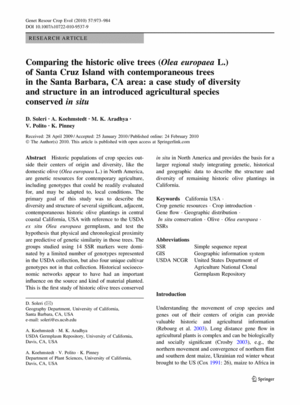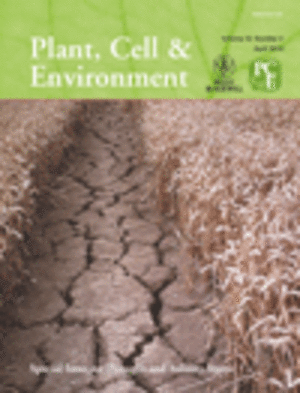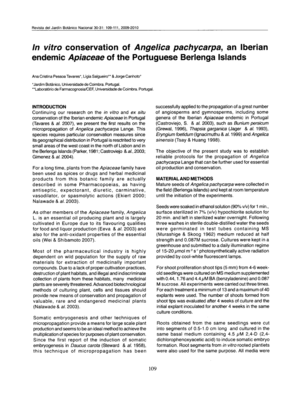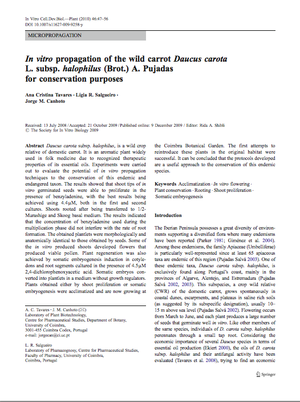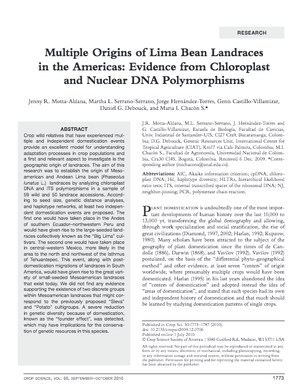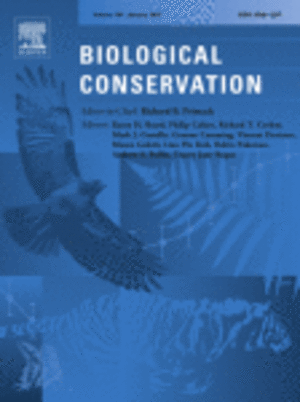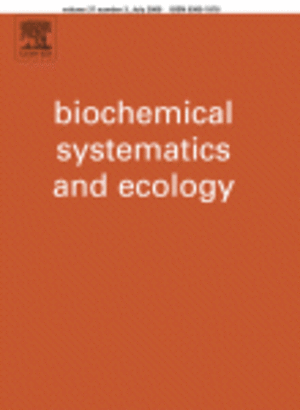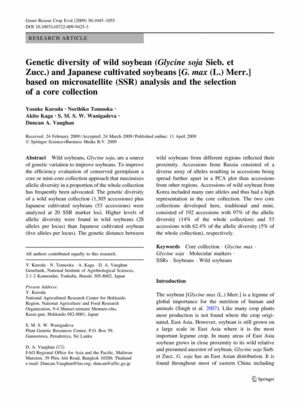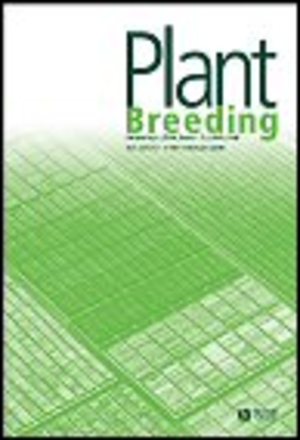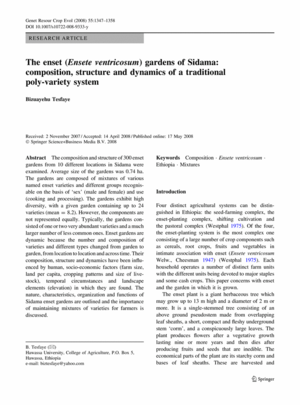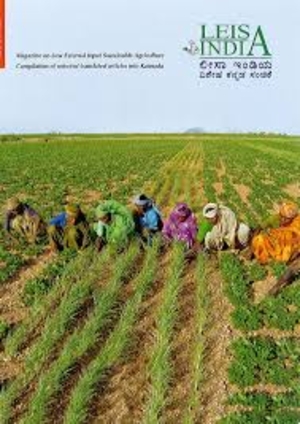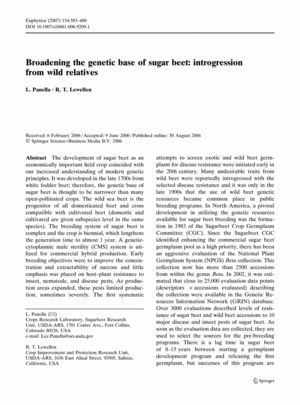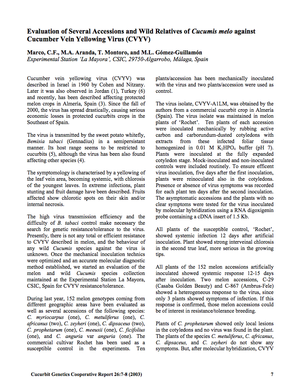Papers
| 2019 |
Authors: Bissessur, P., et al. Publication Year: 2019 |
| 2019 |
Authors: Phillips, J., et al. Publication Year: 2019 |
| 2019 |
Authors: Allen, E., et al. Publication Year: 2019 |
| 2019 |
Conservation gap analysis of crop wild relatives in Turkey Authors: Tas, N., et al. Publication Year: 2019 |
| 2019 |
New tools for crop wild relative conservation planning Authors: Magos Brehm, J., et al. Publication Year: 2019 |
| 2019 |
Authors: Ng'uni, D., et al. Publication Year: 2019 |
| 2019 |
Priority areas for the in situ conservation of crop wild relatives in South Africa Authors: Holness, S., et al. Publication Year: 2019 |
| 2018 |
Wheat's wild relatives vary in their response to nitrogen and ozone Authors: Brewster, C., et al. Publication Year: 2018 |
| 2018 |
Authors: Wainwright, W., et al. Publication Year: 2018 |
| 2018 |
Authors: Sardos, J., et al. Publication Year: 2018 |
| 2018 |
Crop wild relatives in Andaman and Nicobar Islands, India Authors: Sharma, T.V.R.S., et al. Publication Year: 2018 |
| 2018 |
Investigation and taxonomy of wild Fragaria resources in Tibet, China Authors: Guo, R., et al. Publication Year: 2018 |
| 2018 |
Authors: Al-Hajaj, N., et al. Publication Year: 2018 |
| 2018 |
Authors: Frese, L., et al. Publication Year: 2018 |
| 2018 |
National inventory and prioritization of crop wild relatives in Spain Authors: Rubio Teso, M.L., et. al. Publication Year: 2018 |
| 2018 |
Authors: Pacicco, L., et al. Publication Year: 2018 |
| 2018 |
Development of national crop wild relative conservation strategies in European countries Authors: Labokas, J., et al. Publication Year: 2018 |
| 2018 |
A crop wild relative inventory for Mexico Authors: Contreras-Toledo, A.R., et al. Publication Year: 2018 |
| 2017 |
Priorities for enhancing the ex situ conservation and use of Australian crop wild relatives Authors: Norton, S.L., et al. Publication Year: 2017 |
| 2015 |
Enhancing the Conservation of Crop Wild Relatives in England Authors: Fielder, H., et al. Publication Year: 2015 |
| 2018 |
Authors: Jin, X., et al. Publication Year: 2018 |
| 2018 |
Authors: Ellstrand, N. Publication Year: 2018 |
| 2018 |
Bio-fortification potential of global wild annual lentil core collection Authors: Kumar, S., et al. Publication Year: 2018 |
| 2018 |
Authors: Misra, R.C., et al. Publication Year: 2018 |
| 2018 |
Authors: Talip, M., et al. Publication Year: 2018 |
| 2018 |
Authors: Bassil, N., et al. Publication Year: 2018 |
| 2018 |
Authors: Dudnikov, A.J. Publication Year: 2018 |
| 2018 |
Authors: Nataraj, V., et al. Publication Year: 2018 |
| 2018 |
Authors: Okoshi, M., et al. Publication Year: 2018 |
| 2018 |
High-temperature drying of seeds of wild Oryza species intended for long-term storage Authors: Timple, S.E., and Hay, F.R. Publication Year: 2018 |
| 2018 |
Authors: Mousavi-Derazmahalleh, M., et al. Publication Year: 2018 |
| 2018 |
Authors: Gros-Balthazard, M., et al. Publication Year: 2018 |
| 2018 |
Setting conservation priorities for crop wild relatives in the Fertile Crescent Authors: Zair, W., et al. Publication Year: 2018 |
| 2017 |
Authors: Pawera, L., et al. Publication Year: 2017 |
| 2017 |
Authors: Kakizaki, A., et al. Publication Year: 2017 |
| 2017 |
Genetic diversity and taxonomic aspects of wild carrot in France Authors: Geoffriau, E., et al. Publication Year: 2017 |
| 2017 |
Landscape genetic structure of Olea europaea subsp. cuspidata in Ethiopian highland forest fragments Authors: Kassa, A., et al. Publication Year: 2017 |
| 2017 |
Authors: Morillo, E., et al. Publication Year: 2017 |
| 2017 |
Authors: van Treuren, R., et al. Publication Year: 2017 |
| 2013 |
Authors: Knapp, S., et al. Publication Year: 2013 |
| 2013 |
A new collection of wild populations of Capsicum in Mexico and the southern United States Authors: Kraft, K.H., et al. Publication Year: 2013 |
| 2017 |
Prebreeding Using Wild Species for Genetic Enhancement of Grain Legumes at ICRISAT Authors: Sharma, S. Publication Year: 2017 |
| 2017 |
Authors: Volk, G.M., et al. Publication Year: 2017 |
| 2017 |
Authors: Presotto, A., et al. Publication Year: 2017 |
| 2017 |
Authors: Singh, R.K., et al. Publication Year: 2017 |
| 2017 |
Back into the wild—Apply untapped genetic diversity of wild relatives for crop improvement Authors: Zhang, H., et al. Publication Year: 2017 |
| 2017 |
Authors: Bellon, M.R., et al. Publication Year: 2017 |
| 2017 |
Authors: Rana, K., et al. Publication Year: 2017 |
| 2017 |
Authors: Aboukhalid, K., et al. Publication Year: 2017 |
| 2017 |
A new major-effect QTL for waterlogging tolerance in wild barley (H. spontaneum) Authors: Zang, X., et al. Publication Year: 2017 |
| 2013 |
Taxonomic revision of genus Hordeum L. (Gramineae) in Egypt Authors: Amer, W.M., et al. Publication Year: 2013 |
| 2017 |
Authors: Ferreyra, M.J., et al. Publication Year: 2017 |
| 2017 |
Connecting genomic patterns of local adaptation and niche suitability in teosintes Authors: Aguirre-Liguori, J.A., et al. Publication Year: 2017 |
| 2017 |
Authors: Sherman-Broyles, S., et al. Publication Year: 2017 |
| 2017 |
Authors: Taylor, A., et al. Publication Year: 2017 |
| 2017 |
Solanum jamesii: Evidence for Cultivation of Wild Potato Tubers by Ancestral Puebloan Groups Authors: Kinder, D.H., et al. Publication Year: 2017 |
| 2017 |
Authors: Frese, L., et al. Publication Year: 2017 |
| 2017 |
Authors: Garcia, R.M., et al. Publication Year: 2017 |
| 2017 |
Wild emmer genome architecture and diversity elucidate wheat evolution and domestication Authors: Avni, R., et al. Publication Year: 2017 |
| 2017 |
Genome-Wide Association Study of Grain Architecture in Wild Wheat Aegilops tauschii Authors: Arora, S., et al. Publication Year: 2017 |
| 2017 |
Authors: Gorim, L.Y. and Vandenberg, A. Publication Year: 2017 |
| 2017 |
Authors: Idohou, R., et al. Publication Year: 2017 |
| 2017 |
Conserving seeds of useful wild plants in Mexico: main issues and recommendations Authors: Rodríguez-Arévalo, I., et al. Publication Year: 2017 |
| 2017 |
Authors: Prohens, J., et al. Publication Year: 2017 |
| 2017 |
Authors: Leal-Bertioli, S.C.M., et al. Publication Year: 2017 |
| 2017 |
Authors: Zaytseva, O.O., et al. Publication Year: 2017 |
| 2017 |
Wild emmer genome architecture and diversity elucidate wheat evolution and domestication Authors: Avni, R., et al. Publication Year: 2017 |
| 2017 |
Authors: Rakha, M., et al. Publication Year: 2017 |
| 2017 |
Genetic diversity in tolerance of wild Avena species to aluminium (Al) Authors: Loskutov, I.G., et al. Publication Year: 2017 |
| 2017 |
Authors: Kalia, B., et al. Publication Year: 2017 |
| 2017 |
Relationship between spike morphology and habitat of four Aegilops species of section Sitopsis Authors: Ohta, A., et al. Publication Year: 2017 |
| 2017 |
Authors: Ma, G.J., et al. Publication Year: 2017 |
| 2017 |
Asian wild rice is a hybrid swarm with extensive gene flow and feralization from domesticated rice Authors: Wang, H., et al. Publication Year: 2017 |
| 2017 |
Authors: Capistrano-Gossmann, G.G., et al. Publication Year: 2017 |
| 2017 |
Crop wild relatives range shifts and conservation in Europe under climate change Authors: Aguirre-Gutiérrez, J., et al. Publication Year: 2017 |
| 2017 |
Wading Into the Gene Pool: Progress and Constraints Using Wild Species Authors: Greene, S.L. and Warburton, M.L. Publication Year: 2017 |
| 2017 |
Are We Getting Better at Using Wild Potato Species in Light of New Tools? Authors: Bethke, P.C., et al. Publication Year: 2017 |
| 2017 |
Setting conservation priorities for Argentina's pseudocereal crop wild relatives Authors: Curti, R.N., et al. Publication Year: 2017 |
| 2017 |
Authors: Wang, Y., et al. Publication Year: 2017 |
| 2017 |
Crop wild relative conservation: Wild yams are not that wild Authors: Scarcelli, N., et al. Publication Year: 2017 |
| 2017 |
Authors: Morillo, E., et al. Publication Year: 2017 |
| 2017 |
Discovery and characterization of two new stem rust resistance genes in Aegilops sharonensis Authors: Yu, G., et al. Publication Year: 2017 |
| 2017 |
Identification of Pm58 from Aegilops tauschii Authors: Wiersma, T., et al. Publication Year: 2017 |
| 2017 |
The use of crop wild relatives in maize and sunflower breeding Authors: Warburton, M.L., et al. Publication Year: 2017 |
| 2017 |
Authors: Lala, S., et al. Publication Year: 2017 |
| 2017 |
Authors: Satkova, P., et al. Publication Year: 2017 |
| 2017 |
Authors: Thomas, E., et al. Publication Year: 2017 |
| 2017 |
Fine mapping of RYMV3: a new resistance gene to Rice yellow mottle virus from Oryza glaberrima Authors: Pidon, H., et al. Publication Year: 2017 |
| 2017 |
A new species of Aframomum (Zingiberaceae) from D.R. Congo Authors: Fischer, E., et al. Publication Year: 2017 |
| 2017 |
Discovery and characterization of two new stem rust resistance genes in Aegilops sharonensis Authors: Yu, G., et al. Publication Year: 2017 |
| 2017 |
A systematic conservation strategy for crop wild relatives in the Czech Republic Authors: Taylor, N.G., et al. Publication Year: 2017 |
| 2017 |
Authors: Gangopadhyay, K.K., et al. Publication Year: 2017 |
| 2017 |
Authors: Naredo, M.E.B., et al. Publication Year: 2017 |
| 2017 |
Collection and evaluation of wild tulip (Tulipa spp.) resources in China Authors: Xing, G., et al. Publication Year: 2017 |
| 2017 |
Authors: Beghe, D., et al. Publication Year: 2017 |
| 2017 |
Past and Future Use of Wild Relatives in Crop Breeding Authors: Dempewolf, H., et al. Publication Year: 2017 |
| 2017 |
Potential Uses of Wild Germplasms of Grain Legumes for Crop Improvement Authors: Munoz, N., et al. Publication Year: 2017 |
| 2017 |
Climate change and national crop wild relative conservation planning Authors: Phillips, J., et al. Publication Year: 2017 |
| 2017 |
Authors: Chin, J.H., et al. Publication Year: 2017 |
| 2017 |
Authors: Bashiri, H., et al. Publication Year: 2017 |
| 2017 |
Authors: Boucheffa, S., et al. Publication Year: 2017 |
| 2017 |
Exploration and conservation of Stylosanthes (Leguminosae) genetic resources in Venezuela Authors: Calles, T., et al. Publication Year: 2017 |
| 2017 |
Authors: Cadima Fuentes, X., et al. Publication Year: 2017 |
| 2017 |
Authors: Hazarika, T.K., et al. Publication Year: 2017 |
| 2017 |
Authors: Rakha, M., et al. Publication Year: 2017 |
| 2017 |
Authors: Wei, Z., et al. Publication Year: 2017 |
| 2017 |
Authors: Celeste, S.M., et al. Publication Year: 2017 |
| 2017 |
Conserving wild Arabica coffee: Emerging threats and opportunities Authors: Aerts, R., et al. Publication Year: 2017 |
| 2017 |
Eco-geographical assessment of Avena L. wild species at the VIR herbarium and genebank collection Authors: Loskutov, I.G., et al. Publication Year: 2017 |
| 2017 |
Authors: John, K.J., et al. Publication Year: 2017 |
| 2017 |
Authors: Cunniff, J., et al. Publication Year: 2017 |
| 2013 |
Drought tolerance in modern and wild wheat Authors: Budak, H., et al. Publication Year: 2013 |
| 2016 |
Authors: Chávez-Pesqueira, M., et al. Publication Year: 2016 |
| 2016 |
Sequencing of Australian wild rice genomes reveals ancestral relationships with domesticated rice Authors: Brozynska, M., et al. Publication Year: 2016 |
| 2016 |
Core Collections of Potato (Solanum) Species Native to the USA Authors: Bamberg, J., et al. Publication Year: 2016 |
| 2016 |
Assessment of genetic diversity between wild and cultivated artichokes using SSR markers Authors: De Felice, B., et al. Publication Year: 2016 |
| 2008 |
Towards collection of wild relatives of crop plants in India Authors: Pandey, A., et al. Publication Year: 2008 |
| 2016 |
Authors: Mina-Vargas, A.M., et al. Publication Year: 2016 |
| 2016 |
Authors: Clark, L.V., et al. Publication Year: 2016 |
| 2016 |
Climate change is projected to outpace rates of niche change in grasses Authors: Cang, F.A., et al. Publication Year: 2016 |
| 2016 |
Corporate Author: Decroocq, S., et al. Publication Year: 2016 |
| 2014 |
A Prioritized Inventory of Crop Wild Relatives and Wild Harvested Plants of Italy Authors: Landucci, F., et al. Publication Year: 2014 |
| 2016 |
Authors: Aryakia, E., et al. Publication Year: 2016 |
| 2016 |
The challenges of maintaining a collection of wild sunflower (Helianthus) species Authors: Atlagic, J. and Terzic, S. Publication Year: 2016 |
| 2016 |
Genetic diversity of gliadin in Secale cereale subsp. segetale from Xinjiang, China Authors: Che, Y., et al. Publication Year: 2016 |
| 2016 |
Authors: Vishnyakova, M., et al. Publication Year: 2016 |
| 2016 |
Authors: Thormann, I., et al. Publication Year: 2016 |
| 2015 |
China’s crop wild relatives: Diversity for agriculture and food security Authors: Kell, S., et al. Publication Year: 2015 |
| 2008 |
A problem of the rich: Prioritizing local plant genetic resources for ex situ conservation in Israel Authors: Barazani, O., et al. Publication Year: 2008 |
| 2012 |
Inventory of related wild species of priority crops in Venezuela Authors: Berlingeri, C., and Crespo, M.B. Publication Year: 2012 |
| 2008 |
Towards a conservation strategy for Aegilops species Authors: Maxted, N., et al. Publication Year: 2008 |
| 2016 |
Authors: Zhang, H., et al. Publication Year: 2016 |
| 2016 |
Prospects of the use of wild relatives for pea breeding Authors: Kosterin, O.E. Publication Year: 2016 |
| 2016 |
In situ and ex situ diversity analysis of priority crop wild relatives in Norway Authors: Phillips, J., et al. Publication Year: 2016 |
| 2016 |
Geography of Genetic Structure in Barley Wild Relative Hordeum vulgare subsp. spontaneum in Jordan Authors: Thormann, I., et al. Publication Year: 2016 |
| 2016 |
Authors: Wei, L., et al. Publication Year: 2016 |
| 2016 |
Authors: Mihoub, I., et al. Publication Year: 2016 |
| 2016 |
Authors: Gordon, M.H., et al. Publication Year: 2016 |
| 2016 |
Authors: Jena, K.K., et al. Publication Year: 2016 |
| 2016 |
Insight into the evolution of the Solanaceae from the parental genomes of Petunia hybrida Authors: Bombarely, A., et al. Publication Year: 2016 |
| 2016 |
Authors: Oliveira, H., et al. Publication Year: 2016 |
| 2016 |
Authors: Meng, J., et al. Publication Year: 2016 |
| 2016 |
Adaptation to low temperatures in the wild tomato species Solanum chilense Authors: Nosenko, T., et al. Publication Year: 2016 |
| 2016 |
Genomics of crop wild relatives: expanding the gene pool for crop improvement Authors: Brozynska, M., et al. Publication Year: 2016 |
| 2015 |
Authors: Silva, N.C.dA., et al. Publication Year: 2015 |
| 2015 |
Authors: Gao, Y., et al. Publication Year: 2015 |
| 2016 |
Authors: Syfert, M.M., et al. Publication Year: 2016 |
| 2015 |
Elicitin recognition confers enhanced resistance to Phytophthora infestans in potato Authors: Du, J., et al. Publication Year: 2015 |
| 2016 |
Authors: Bertioli, D.J., et al. Publication Year: 2016 |
| 2016 |
Authors: An, F., et al. Publication Year: 2016 |
| 2014 |
Development of cassava periclinal chimera may boost production Authors: Bomfim, N. and Nassar, N.M.A. Publication Year: 2014 |
| 2013 |
Synthesis of periclinal chimera in cassava Authors: Nassar, N.M.A. and Bomfim, N. Publication Year: 2013 |
| 2016 |
Authors: Dossett, M. and Finn, C.E. Publication Year: 2016 |
| 2016 |
Salt tolerance in wild relatives of adzuki bean, Vigna angularis (Willd.) Ohwi et Ohashi Authors: Yoshida, Y., et al. Publication Year: 2016 |
| 2016 |
Authors: Zhang, D., et al. Publication Year: 2016 |
| 2016 |
Diversity and distribution of puroindoline-D1 genes in Aegilops tauschii Authors: Liu, D., et al. Publication Year: 2016 |
| 2016 |
Global conservation priorities for crop wild relatives Authors: Castañeda-Álvarez, N.P., et al. Publication Year: 2016 |
| 2016 |
Authors: Gao L.-Z. and Gao, C.-W. Publication Year: 2016 |
| 2016 |
Authors: da Silva, M.J., et al. Publication Year: 2016 |
| 2016 |
Novel Genetic Resources in the Genus Vigna Unveiled from Gene Bank Accessions Authors: Takahashi, Y., et al. Publication Year: 2016 |
| 2015 |
Authors: Pan, C., et al. Publication Year: 2015 |
| 2016 |
Diversity of wild yams (Dioscorea spp., Dioscoreaceae) collected in continental Africa Authors: Magwe-Tindo, J., et al. Publication Year: 2016 |
| 2016 |
Authors: Wilson, W.D., et al. Publication Year: 2016 |
| 2016 |
Authors: Cruz-Garcia, G.S., et al. Publication Year: 2016 |
| 2016 |
Potatoes are grown as a staple food in a number of countries around the world. Potatoes production is fourth at the worldwide level and provides carbohydrates and other nutrients in several developing countries. In South America a large diversity of wild and cultivated potato genotypes have been identified, from which several species have been described in Colombia. The last known collections of wild potato germplasm in Colombia were performed up to 1992, and we know little of wild potato distribution since that time. Several factors may threaten these populations, and we performed field surveys of the Colombian populations, as well as a literature review, studies of herbarium specimens from eight Colombian herbaria and databases from reference collections available on the internet. Based in these data we performed field trips in several Colombian regions where wild and cultivated species were reported previously. We identified Solanum andreanum Baker, S. colombianum Dunal and S. flahaultii Bitter, populations according to the taxonomic concepts of Spooner and Fajardo; or S. andreanum, S. colombianum, S. flahaultii, S. moscopanum Hawkes and S. tuquerrense Hawkes, according to the taxonomy of Hawkes. We observed habitat loss or disturbance that may partially explain the apparent decrease or eventual disappearance of some species at specific sites.
Authors: Velez, J.M., et al. Publication Year: 2016 |
| 2016 |
Authors: Giraldo, P., et al. Publication Year: 2016 |
| 2012 |
Information on plant adaptation can be very useful in agrobiodiversity studies. Ecogeographical land characterization (ELC) maps constitute a new tool in this direction with great potential. To assess the usefulness of this approach, an ELC map of Spain was created through multivariate methods. Its performance to characterize plant habitat preferences was compared with existing ecological regions and land cover maps. Collecting sites and seed weight from eight plant species were used to test the ELC map. Categories from each map were assigned to accessions using collecting sites. Chi-square tests were applied to test if category frequency distributions for each species followed a distribution proportional to the relative frequency of categories in each map. The tests found significant differences in the eight species studied. Thus, Bonferroni confidence intervals (BCI) classified categories from maps in preferred, neutral or avoided habitats. Seed weight was used as a proxy for plant adaptation. Comparison between observed and expected ranking of BCI and quartile classes in terms of seed weight means, and GLM and post-hoc tests carried out to test the effect of these classes upon seed weight showed consistently better results for the ELC map. Species results and applications of ecogeographic maps in plant genetic resources conservation are discussed.
Authors: Parra-Quijano, M. et al. Publication Year: 2012 |
| 2012 |
The present paper reviews the use of ecogeographical studies in the efficient conservation and utilization of plant genetic resources. While the use of genotypic information in agrobiodiversity studies has experienced a rapid boost during the last two decades, the use of environmental information on the collecting sites of the conserved germplasm (i.e., ecogeographical characterization) has gained importance in a more gradual way. Today we know that ecogeographical characterization reveals the adaptive range of species conserved and shows the most important environmental factors or variables for adaptation. Progress in ecogeographical characterization has been helped by the development and popularization of geographic information systems (GIS) software applications and environmental data arranged in layers compatible with such applications. GIS are useful to manage and analyze georeferenced data, such as passport collection data and environmental variables. Thus, GIS have become the best tool to perform ecogeographical analyses. Other related tools such as species distribution models or gap analysis can be easily integrated in ecogeographical analysis, offering improved results. As a result, GIS, related tools and ecogeographical analysis can be useful in a wide range of applications in the collection, conservation, characterization, documentation and utilization of plant genetic resources.
Authors: Parra-Quijano, M. et al. Publication Year: 2012 |
| 2012 |
An efficient germplasm collecting method was evaluated using six Lupinus species and the Spanish Lupinus collection as a study case. This method includes the application of geographic information systems, ecogeographical land characterization maps, species distribution models and gap analysis to identify prioritized collecting sites. To evaluate the efficiency of this collecting method, field collecting expeditions were carried out focusing on prioritized sites and the results of these collections were analyzed. Prioritized sites were identified using spatial and ecogeographical gaps, and potential species richness maps. The spatial gaps corresponded to populations non-included in the collection but recorded by other information sources while ecogeographical gaps corresponded to spatial gaps that were located in ecogeographical categories (obtained from the ecogeographical map) that were scarcely represented in the collection. A potential Lupinus species richness map was obtained by adding the information of single maps of Lupinus species distribution models. Subsequently, prioritized sites were obtained in ecogeographical gaps with high potential species richness values. Collecting expeditions were made in Spain in 2006, 2007 and 2008. Results showed that using the efficient germplasm collecting methodology was highly positive not only from a quantitative viewpoint (between 7.8 and 11% increase) but also in qualitative terms, focusing collection efforts in ecogeographical categories with low or null representation in the Spanish Lupinus collection (41% of the new accessions). Phenotypic differences related to adaptation to environment were observed in the field between the populations that grow in low or null represented categories and those that grow in highly represented categories.
Authors: Parra-Quijano, M. et al. Publication Year: 2012 |
| 2011 |
Strategies for the Development of Core Collections Based on Ecogeographical Data
Ecogeographical data complement genotypic and phenotypic information on plant genetic resources and provide an alternative characterization when resources are scarce. Ecogeographical core collections can be created by directly characterizing georeferenced collecting sites or by assigning them categories from ecogeographical land characterization maps (CEM). Our objective was to determine the suitability of core collections based solely on ecogeographical data and the most appropriate combination of grouping and allocation methods in representativeness and simplicity. Using six Lupinus species as case studies and peninsular Spain and the Balearic Islands as workspace, we evaluated 16 ecogeographical core collections obtained by applying different grouping and allocation methods. Six core collection strategies met existing standard representativeness criteria and performed better than random selection of accessions. The Ward-Modified Location Model (Ward-MLM) and two-step clustering (TSC) with proportional allocation strategy (P) produced the most representative core collections. Grouping according to CEM with P allocation also produced a highly representative core collection but through a simpler procedure. In conclusion, ecogeographical data can be used to create representative core collections with similar strategies to those used with genotypic or phenotypic data or simpler ones such as CEM, which is easy to apply and update.
Authors: Parra-Quijano, M. et al Publication Year: 2011 |
| 2008 |
Gap analysis: a tool for complementary genetic conservation assessment
Aim: Gap analysis is a well-established conservation technique that identifies areas in which selected elements of biodiversity are represented and through comparison with existing in situ protected area networks identifies habitats or ecosystems that need additional protection. We aim to demonstrate that gap analysis may be extended to encompass both in situ and ex situ genetic diversity conservation strategies.
Location: Global, with exemplar case study from sub-Saharan Africa.
Methods: An extended methodology of gap analysis is proposed that involves the following steps: (1) circumscription of target taxon and target area; (2) assessment of natural diversity through a review of intrinsic taxonomic, genetic and ecogeographical diversity combined with threat assessment; (3) assessment of current complementary in situ and ex situ conservation strategies; and (4) reformulation of the conservation strategy through analysis of the differences between the pattern of natural, intrinsic diversity and the elements of that diversity already effectively represented by existing in situ and ex situ conservation actions.
Results: To illustrate the gap analysis approach proposed, the methodology was applied to the conservation of African Vigna species (cowpea Vigna unguiculata (L.) Walp. and its wild relatives) and indicated: (1) genetic reserves should be established at the southern tip of Lake Tanganyika, the coastal area of Sierra Leone and between Lake Victoria and the other Great Lakes, and (2) 14 taxa and several countries should be targeted for further seed collection.
Main conclusions: The robust nature of the extended methodology for gap analysis has been demonstrated and indicates that its scope as an effective conservation tool may be expanded to fully address the need for a more comprehensive and complementary conservation strategy that encompasses both in situ and ex situ applications. However, it should be stressed that the methodology is applicable for any form of biodiversity (wild or cultivated), where the conservation of genetic diversity is the prime goal.
Authors: Maxted, N. et al. Publication Year: 2008 |
| 2011 |
Evaluation and validation of ecogeographical core collections using phenotypic data
This study evaluated the phenotypic representativeness of core collections generated independently with ecogeographical data or with morphological data. The Spanish Phaseolus vulgaris L. collection was the target germplasm collection, and one map of ecogeographical categories and 15 morphological variables were used to create core collections. Three ecogeographical and 12 morphological core collections were produced combining different grouping methods (categories from ecogeographical land characterization map [CEM], two-step clustering [TSC], Ward–modified location model clustering [WM], and unweighted pair-group method using arithmetic average [UPGMA]) and allocation strategies (constant [C], proportional [P], logarithmic [L], and Gower's distance [D]). An additional morphological core collection was created using a modified least distance stepwise sampling (LDSSm) method. Core collections were evaluated with morphological data using parameters for qualitative and quantitative variables that were summarized in a new synthetic evaluation parameter (SEP). Synthetic evaluation parameter results showed that the ecogeographical core collections had high phenotypic representativeness, similar to that of morphological core collections generated by the combination of WM and TSC grouping methods and P allocation strategy. A graphical evaluation of core collections supported these results. In conclusion, ecogeographical information was confirmed as a good alternative or complement to other types of data to create reliable and representative core collections.
Authors: Parra-Quijano, M. et al. Publication Year: 2011 |
| 2015 |
Crop wild relatives (CWR) play a key role in providing genetic diversity for crop adaptation and improvement and their in situ conservation is the most appropriate action to safeguard them, as it allows new diversity to be generated. Knowledge about contemporary evolutionary processes, adaptive responses to climate change, and trends in genetic diversity status should support the identification of target populations for in situ management and monitoring actions. Generating this knowledge requires monitoring and assessing diversity at various time points. Analyses of past trends have been particularly limited for CWR due to patchy, scarce availability of historical data and seed material, which would constitute a historical baseline for comparison with contemporary populations. Past germplasm collecting missions and their associated documentation can contribute to filling this gap. We analysed as a potential resource the Bioversity Collecting Database, which includes sample-level records for over 200,000 landrace and CWR samples mainly collected between 1975 and 1995. 27% of the samples collected are wild species, of which 73% are georeferenced. The database links original sample passport data with collecting reports and with accession numbers from the genebanks conserving the collected material, which allows the seeds collected to be tracked. This data resource was used to implement a study on temporal variation in wild barley. Wild barley (Hordeum vulgare subsp. spontaneum), originally collected in 1981 and stored in genebanks, was re-collected from historical sites in Jordan. Most original accessions from the 1981 mission were traced in genebanks and phenotypic and molecular marker data compared between the 1981 and 2012 collections.
Authors: Thormann, I. and Dulloo, M.E. Publication Year: 2015 |
| 2015 |
Authors: Martynov, S.P., et al. Publication Year: 2015 |
| 2015 |
ABSTRACT: Habitat fragmentation is a leading threat to biodiversity, with extinction rates increasing as anthropogenic alteration of the environment increases. Crop to wild hybridisation is a threat to biodiversity resulting from native vegetation being replaced with agriculture and crops. Remnant populations of Australia's vulnerable subtropical rainforest tree Macadamia tetraphylla are potentially threatened by hybridisation with M. integrifolia orchard crops. Leaf samples were taken from ten crop-wild population sites across the distribution of M. tetraphylla in New South Wales, Australia. Microsatellite markers were used to investigate the presence of marker alleles from cultivars in wild populations, and genetic diversity within and among wild M. tetraphylla populations. Despite the small size of the wild M. tetraphylla populations, relatively high genetic diversity and low inbreeding were observed. This study found that M. integrifolia orchard trees pollinated wild M. tetraphylla trees, and that orchard seeds dispersed into wild populations, providing the first evidence of crop-wild gene flow in macadamia. Pollen flow between relatively close wild populations maintains genetic diversity, reduces inbreeding, and also enables gene flow from nearby M. integrifolia orchards. The potential for crop to wild gene flow and hybridisation risks the integrity and persistence of wild populations.
Authors: O'Conner, K. et al. Publication Year: 2015 |
| 2003 |
A Decade of Collecting and Research on Wild Potatoes of the Southwest USA
Potato is an important world crop with an abundant diversity of wild relatives for research and breeding. About 200 tuber-bearingSolarium relatives of the cultivated potato are distributed from southern Chile to the southwest USA. Only five of these have been reported in the USA, and only two exist with certainty (S. fendleri andS. jamesii). This paper reviews the procedures and outcome of 12 expeditions by the authors to the Southwest USA from 1992 to 2001 that resulted in 132 new germplasm accessions. Previously published information allowed successful collection from many documented sites, and many new sites were discovered and sampled. Incomplete or inaccurate records were improved and refined, making it possible for others to easily find these sites. When assessed for genetic diversity, re-collections from the same site were found to be nearly as genetically different as samples from different sites, and genetic differences between sites could not be linked with any ecogeographic parameter, even physical distance of separation. In conclusion, wild potato germplasm from the USA and associated knowledge was greatly expanded, but reaching the goal of obtaining and keeping the most complete sample possible of the genetic diversity will involve additional collecting and continued research on the reproductive behavior of these plants.
Authors: Bamberg, J. et al. Publication Year: 2003 |
| 2015 |
Crop wild relatives (CWR) are a rich source of genetic diversity for crop improvement. Combining ecogeographic and phylogenetic techniques can inform both conservation and breeding. Geographic occurrence, bioclimatic, and biophysical data were used to predict species distributions, range overlap and niche occupancy in 36 taxa closely related to sunflower (Helianthus annuus L.). Taxa lacking comprehensive ex situ conservation were identified. The predicted distributions for 36 Helianthus taxa identified substantial range overlap, range asymmetry and niche conservatism. Specific taxa (e.g., Helianthus deblis Nutt., Helianthus anomalus Blake, and Helianthus divaricatus L.) were identified as targets for traits of interest, particularly for abiotic stress tolerance, and adaptation to extreme soil properties. The combination of techniques demonstrates the potential for publicly available ecogeographic and phylogenetic data to facilitate the identification of possible sources of abiotic stress traits for plant breeding programs. Much of the primary genepool (wild H. annuus) occurs in extreme environments indicating that introgression of targeted traits may be relatively straightforward. Sister taxa in Helianthus have greater range overlap than more distantly related taxa within the genus. This adds to a growing body of literature suggesting that in plants (unlike some animal groups), geographic isolation may not be necessary for speciation.
Authors: Kantar, M. et al. Publication Year: 2015 |
| 2010 |
ABSTRACT: High temperatures over 32–36 °C at anthesis induce spikelet sterility in rice. The use of a germplasm with an early-morning flowering (EMF) trait has been hypothesized as a way of avoiding this problem. In this study, the effect of the EMF trait on avoiding high temperature-induced sterility at anthesis by flowering at a cooler temperature in the early morning was evaluated.
Authors: Ishimar, T. et al. Publication Year: 2010 |
| 2010 |
In light of the growing concern over the potentially devastating impacts on biodiversity and food security of climate change and the massively growing world population, taking action to conserve crop wild relatives (CWR), is no longer an option — it is a priority. Crop wild relatives are species closely related to crops, including their progenitors, many of which have the potential to contribute beneficial traits to crops, such as pest or disease resistance, yield improvement or stability. They are a critical component of plant genetic resources for food and agriculture (PGRFA), have already made major contributions to crop production and are vital for future food security; their systematic conservation in ways that ensure their continuing availability for use is therefore imperative. This is a complex, interdisciplinary, global issue that has been addressed by various national and international initiatives. Drawing on the lessons learnt from these initiatives we can now propose a global approach to CWR conservation, the key elements of which are: (1) estimating global CWR numbers, (2) assessment of the global importance of CWR diversity, (3) current conservation status, (4) threats to CWR diversity, (5) systematic approaches to CWR conservation, (6) CWR informatics, and (7) enhancing the use of CWR diversity.
Authors: Maxted, N. et al. Publication Year: 2010 |
| 2015 |
A novel gene responsible for erect panicle from Oryza glumaepatula
ABSTRACT: The varieties with erect panicles used in rice breeding have led to a significant increase in rice yield. But the molecular mechanism of erect panicle remains elusive. Oryza glumaepatula, with the erect panicle phenotype, is an excellent gene pool to improve Asian cultivated rice O. sativa. In this study, a backcross introgression line was derived with Dianjingyou 1, a japonica cultivar, as the recurrent parent and an accession of O. glumaepatula as the donor parent. Using BC5F2 population, a novel gene responsible for erect panicle, EP4, was mapped within a 1.5 cM region flanked by SSR markers RM253 and RM19623 on the short arm of chromosome 6, at genetic distances of 0.4 and 1.1 cM, respectively. These results are useful for marker-assisted selection of erect panicles and for further cloning of the EP4 gene, which will contribute to the dissection of the molecular mechanism underlying erect panicles in rice.
Authors: Zhang, Y. et al. Publication Year: 2015 |
| 2013 |
A prioritized crop wild relative inventory to help underpin global food security Authors: Vincent, H., et al. Publication Year: 2013 |
| 2011 |
ABSTRACT: Over much of the world, the growing season of 2050 will probably be warmer than the hottest of recent years, with more variable rainfall. If we continue to grow the same crops in the same way, climate change will contribute to yield declines in many places3. With potentially less food to feed more people, we have no choice but to adapt agriculture to the new conditions.
Authors: Guarino, L. and Lobell, D. Publication Year: 2011 |
| 2014 |
ABSTRACT: The main objective of the“Adapting Agriculture to Climate Change” project is to collect and protect the genetic diversity of a portfolio of plants with the characteristics required for adapting the world's most important food crops to climate change. The initiative also aims to make available this diversity in a form that plant breeders can readily use to produce varieties adapted to the new climatic conditions that farmers, particularly in the developing world, are already encountering. Such adaptation is a key component of securing the world's future food production. This paper serves to inform interested researchers of this important initiative and encourage collaboration under its umbrella.
Authors: Dempewolf, H. et al. Publication Year: 2014 |
| 2005 |
ABSTRACT: For breeding programs of the tetraploid potato (Solanum tuberosum), both wild and cultivated diploid relatives are valuable sources of genetic diversity. While both types of germplasm are used in breeding programs, there are several advantages to using wild relatives. Diploid relatives are typically crossed with haploids (2n = 2x = 24) from tetraploid S. tuberosum to improve daylength adaptation. Most haploids are male sterile, so they are typically used as female parents. Cultivated diploids, such as members of the Phureja Group, produce male sterile hybrids when crossed as females to haploids; wild relatives, such as S. tarijense, often produce male fertile hybrids. Tuber yield following crosses of haploids to cultivated or wild relatives is often high. However, cultivated relatives generally produce hybrids with a high set of small tubers; hybrids from wild relatives are variable, but many are similar to cultivars in tuber size and set. While tubers of hybrids from cultivated relatives are typically rough, with deep eyes and raised internodes, those from wild relatives are often smooth. Tuber dormancy in hybrids with cultivated relatives is generally short, while that in hybrids with wild species is longer, allowing for storage over winter. Finally, resistance to several major diseases and stresses has been found in wild species and their hybrids with S. tuberosum haploids. The desirable traits in hybrids are transmitted to tetraploids via unilateral sexual polyploidization (4x × 2x or 2x × 4x crosses in which the diploid parent produces 2n gametes). Wild Solanum species are recommended for use in potato breeding programs as sources of genetic diversity that can be adapted easily following hybridization with S. tuberosum haploids.
Authors: Jansky, S. and Peloquin, S. Publication Year: 2005 |
| 2006 |
Aegilops tauschii: genetic variation in Iran Authors: Dudnikov, A.J. and Kawahara, T. Publication Year: 2006 |
| 2014 |
Allelic diversity between and within three wild annual Cicer species
ABSTRACT: Most wild Cicer species have narrow eco-geographic amplitude. Likewise, domesticated chickpea suffers from severe adaptive limitations due to its unique evolutionary history. The wild progenitor may offer only limited adaptive allelic variation for improving the chickpea crop. Therefore, there is a need to explore allelic diversity between and within annual Cicer sp. that span diverse natural habitats. Here we characterized the allelic diversity between and within wild populations of C. pinnatifidum, C. judaicum and C. cuneatum spanning most of their documented native range in Turkey, Israel and Ethiopia. Eco-geographical analysis resulted in clear separation between the collection sites of C. cuneatum in east Africa and the other two east Mediterranean species. Analysis of molecular variance shows that only 18 % of the allelic variation accounts for differences between the three species, while 34 % was contributed from difference between populations. Interestingly, most (48 %) of the allelic variation was detected among accessions within populations. PCoA analysis confirmed the independent taxonomic and indeed the genetic integrity of the two east Mediterranean sister species C. pinnatifidum and C. judaicum. Conservation of large rich populations seems a more effective strategy than the preservation of small thin populations of annual Cicer sp. Given the relatively narrow geographic range of most annual Cicer sp., accessing germplasm lines from ecologically distinct habitats emerges as the most promising strategy for the identification of useful adaptive allelic variation.
Authors: Peleg, Z. et al. Publication Year: 2014 |
| 2013 |
An Inventory of Crop Wild Relatives of the United States
ABSTRACT: The use of crop wild relatives (CWRs) in breeding is likely to continue to intensify as utilization techniques improve and crop adaptation to climate change becomes more pressing. Significant gaps remain in the conservation of these genetic resources. As a first step toward a national strategy for the conservation of CWRs, we present an inventory of taxa occurring in the United States, with suggested prioritization of species based on potential value in crop improvement. We listed 4600 taxa from 985 genera and 194 plant families, including CWRs of potential value via breeding as well as wild species of direct use for food, forage, medicine, herb, ornamental, and/or environmental restoration purposes. United States CWRs are related to a broad range of important food, forage and feed, medicinal, ornamental, and industrial crops. Some potentially valuable species are threatened in the wild, including relatives of sunflower (Helianthus annuus L.), walnut (Juglans regia L.), pepo squash (Cucurbita pepo L.), wild rice (Zizania L.), raspberry (Rubus idaeus L.), and plum (Prunus salicinaLindl.),
and few accessions of such taxa are currently conserved ex situ. We prioritize 821 taxa from 69 genera primarily related to major food crops, particularly the approximately 285 native taxa from 30 genera that are most closely related to such crops. Both the urgent collection for ex situ conservation and the management of such taxa in protected areas are warranted, necessitating partnerships between concerned organizations, aligned with regional and global initiatives to conserve and provide access to CWR diversity.
Authors: Khoury, K. et al. Publication Year: 2013 |
| 2003 |
ABSTRACT: The MEDUSA Network (Identification, Conservation and Use of Wild Plants in the Mediterranean Region) is concerned with gathering information on all the native plants of the Mediterranean region that are useful to man. The objectives of the Network are (a) the identification of native and naturalised plants of the Mediterranean Region, according to their uses (b) the creation of a Regional Information System that with information on plant nomenclature, chemistry, habitat description, uses, conservation, including references to literature sources and (c) the evaluation of the conservation status and of the potential utilisation in agriculture of these plants as alternative minor crops. The eventual aim of the Network is to propose methods for the economic and social development of rural areas of the Mediterranean Region, using ecologically-based management systems that will ensure the sustainable use and conservation of plant resources of the area. These plant genetic resources are of actual or potential importance to agriculture, various industries and human health, and consequently will improve the quality of life. The particular goal of the Network is the exploration of possibilities for the sustainable utilisation of such resources as alternative crops for the diversification of agricultural production for improved product quality. Furthermore, the information collected in the MEDUSA database will provide the basis for projects aimed at protecting the valuable cultural heritage represented by these plants and ensuring their survival via ‘conservation through use.’
Authors: Skoula, M. et al. Publication Year: 2003 |
| 2002 |
Authors: Gao, L., et al. Publication Year: 2002 |
| 2014 |
Authors: Warschefsky, E., et al. Publication Year: 2014 |
| 2015 |
Agricultural biodiversity: Banks for bean counters
ABSTRACT: IN THE early 1970s Asia’s rice farmers faced ruin. The brown planthopper, an insect up till then found mostly in Japan, began to appear across the region. It fed on young plants and transmitted grassy stunt virus, causing crops to shrivel and brown. As it swept through Asia’s paddy fields, yields crashed. By the end of the decade it had caused damage costing over $300m—more than $1 billion in today’s money.
Publication Year: 2015 |
| 2015 |
ABSTRACT: PLANT-COLLECTING has long attracted mavericks with a thirst for adventure. In Borneo in the 1960s John Wood, now at Oxford University, had to shave leeches off his legs with a machete. In the 1970s, at the outbreak of Lebanon’s civil war, Geoff Hawtin, now a trustee of the Royal Botanic Gardens in Kew, drove a collection of legumes down a mined road to the Syrian border (and back again when he found it was closed). In the 1980s Daniel Debouck, a Belgian bean-collector based in Colombia, narrowly escaped capture by narcos in Mexico and guerrillas in Peru.
Publication Year: 2015 |
| 2010 |
Adapting agriculture to climate change: The role of crop wild relatives
ABSTRACT: This Statement summarizes the results of the third in a series of consultations between
agricultural scientists (in particular those interested in the conservation and use of crop
diversity in plant improvement) and climate scientists on how to adapt agriculture to climate
change. The first meeting, also held at Bellagio (3-7 September 2007), looked at the
Conservation and Use of Global Crop Genetic Resources in the Face of Climate Change. It
identified three major challenges facing the adaptation process: collecting crop diversity
before it disappears, using it to breed better adapted crops, and informing key players of the
increased need for the conservation and effective use of crop genetic resources in the face of
climate change.
Authors: Guarino, L. et al. Publication Year: 2010 |
| 2015 |
Biodiversity inhibits parasites: Broad evidence for the dilution effect
ABSTRACT:The dilution effect hypothesis suggests that diverse ecological communities limit disease spread via several mechanisms. Therefore, biodiversity losses could worsen epidemics that harm humans and wildlife. However, there is contentious debate over whether the hypothesis applies broadly, especially for parasites that infect humans. We address this fundamental question with a formal meta-analysis of >200 assessments relating biodiversity to disease in >60 host–parasite systems. We find overwhelming evidence of dilution, which is independent of host density, study design, and type and specialization of parasites. A second analysis identified similar effects of diversity in plant–herbivore systems. Thus, biodiversity generally decreases parasitism and herbivory. Consequently, human-induced declines in biodiversity could increase human and wildlife diseases and decrease crop and forest production.
Authors: Civitello, D. et al. Publication Year: 2015 |
| 2003 |
Biogeography of Wild Arachis: Assessing Conservation Status and Setting Future Priorities Authors: Jarvis, A., et al. Publication Year: 2003 |
| 2008 |
Challenges of In Situ Conservation of Crop Wild Relatives
ABSTRACT: Crop wild relatives (CWRs) will gain in importance as changing climates put both traditional and advanced cultivars under increasing stress, leading to a need for plant breeding to produce new varieties able to grow under the new climate regimes. Traditionally, the approach to the conservation of CWRs has been ex situ – the collection and maintenance of seed accessions in national, regional, and international germplasm banks, supplemented by field genebanks for species with recalcitrant seeds. More recently the need to maintain CWRs in their natural habitats (in situ) has been advocated. This is very different from on-farm conservation of traditional land races and is a complex multidisciplinary process. Particular problems that have to be addressed include the adoption of a workable definition of what is a CWR, application of priority-determining mechanisms because of the large number of candidate species of CWRs, assessment of the effectiveness of conservation approaches, the relative costs of in situ and ex situ approaches, integration of CWR in situ conservation into national programmes, and the challenges posed by global change. CWRs may be conserved in both protected and non-protected areas. Presence in the former is no guarantee of their survival and in most cases some degree of management intervention is required. Experience derived from recent EU- and GEF-funded CWR conservation initiatives will be drawn upon.
Authors: Heywood, V.H. Publication Year: 2008 |
| 2009 |
Kibale Forest Wild Coffee: Challenges to Market-Based Conservation in Africa
ABSTRACT: Declining rural security and pressures to reduce public-sector expenditures in the late 1990s spurred efforts to develop alternative funding models for Uganda's Kibale National Park (KNP). The Wild Coffee Project, established in 1999 with support from the U.S. Agency for International Development, the World Bank, and the Ford Foundation, sought to develop a market for wild coffee that had been harvested traditionally from areas within today's KNP. The Kibale Forest Foundation, a U.S.-based nonprofit organization, was created to legalize harvests, obtain third-party wild and organic certification, and coordinate management between KNP, the coffee industry, and local communities. Although the project was successful in legalizing, harvesting, and processing the world's first certified wild and organic coffee, efforts to gain entry into the international marketplace failed. Chief among the lessons learned from this project is that for many wild-grown products, the value of “the story”—in both human and conservation terms—is likely to far exceed actual product values. This value differential should be captured through high-value niche markets to avoid low commodity pricing and subsequent pressures to improve financial returns through over harvesting. In addition, local producers should hold significant assets in whatever brands are developed, creating a shared-equity approach that serves social responsibility goals, fosters project sustainability, and ensures a steady stream of positive stories for use in marketing to build brand value. Shared equity—in this case ownership interest in the intellectual property embodied in the brand—provides a second incentive beyond transactional profits that can only be realized if resource conservation is maintained.
Authors: Lilieholm, R. and Weatherly, P. Publication Year: 2009 |
| 2013 |
ABSTRACT: Crop wild relatives are an increasingly important source of plant genetic resources for plant breeders. Several studies have estimated the effects of climate change on the distribution of crop wild relatives, using species distribution models. In this approach, two important aspects, i.e. species' dispersal capacity and founder effects, are currently not taken into account. Neglecting these aspects can lead to an underestimation of the climate change-induced threat to the size of the species range and the conservation of range-wide levels of genetic diversity. This paper presents two recommendations for the interpretation of the results obtained with these models. The integration of process-based simulation models and statistical species distribution models will facilitate the inclusion of dispersal processes and founder effects in future assessments of the resilience of plant genetic resources under climate change.
Authors: Cobben, M. et al. Publication Year: 2013 |
| 2001 |
Authors: Sun, C.Q., et al. Publication Year: 2001 |
| 2013 |
Complex Patterns of Local Adaptation in Teosinte
ABSTRACT: Populations of widely distributed species encounter and must adapt to local environmental conditions. However, comprehensive characterization of the genetic basis of adaptation is demanding, requiring genome wide genotype data, multiple sampled populations, and an understanding of population structure and potential selection pressures. Here, we used SNP genotyping and data on numerous environmental variables to describe the genetic basis of local adaptation in 21 populations of teosinte, the wild ancestor of maize. We found complex hierarchical genetic structure created by altitude, dispersal events and admixture among subspecies that complicated identification of locally beneficial alleles. Patterns of linkage disequilibrium revealed four large inversion polymorphisms showing clinal patterns of frequency. Population differentiation and environmental correlations suggest that both inversions and intergenic polymorphisms are involved in local adaptation.
Authors: Pyhäjärvi, T. et al. Publication Year: 2013 |
| 2007 |
Conservation and sustainable use of crop wild relatives
ABSTRACT: Conservation of crop wild relatives (CWRs) is a complex interdisciplinary process that is being addressed by various national and international initiatives, including two Global Environment Facility projects (‘In situ Conservation of Crop Wild Relatives through Enhanced Information Management and Field Application’ and ‘Design, Testing and Evaluation of Best Practices for in situ Conservation of Economically Important Wild Species’), the European Community-funded project ‘European Crop Wild Relative Diversity Assessment and Conservation Forum (PGR Forum)’ and the European ‘In situ and On Farm Network’. The key issues that have arisen are: (1) the definition of what constitutes a CWR, (2) the need for national and regional information systems and a global system, (3) development and application of priority-determining mechanisms, (4) the incorporation of the conservation of CWRs into existing national, regional and international PGR programmes, (5) assessment of the effectiveness of conservation actions, (6) awareness of the importance of CWRs in agricultural development at local, national and international levels both for the scientific and lay communities and (7) policy development and legal framework. The above issues are illustrated by work on the conservation of a group of legumes known as grasspea chicklings, vetchlings, and horticultural ornamental peas (Lathyrus spp.) in their European and Mediterranean centre of diversity.
Authors: Heywood, V. et al. Publication Year: 2007 |
| 1993 |
Conservation of allelic richness in wild crop relatives is aided by assessment of genetic markers
ABSTRACT: Wild crop relatives are an important source of genetic variation for improving domesticated species. Given limited resources, methods for maximizing the genetic diversity of collections of wild relatives are needed to help spread protection over a larger number of populations and species. Simulations were conducted to investigate the optimal strategy of sampling materials from populations of wild relatives, with the objective of maximizing the number of alleles (allelic richness) in collections of fixed size. Two methods, based on assessing populations for variation at marker loci (e.g., allozymes, restriction fragment length polymorphisms), were developed and compared with several methods that are not dependent on markers. Marker-assisted methods yielded higher overall allelic richness in the simulated collections, and they were particularly effective in conserving geographically localized alleles, the class of alleles that is most subject to loss.
Authors: Schoen, D.J and Brown, A.H. Publication Year: 1993 |
| 2003 |
ABSTRACT: Conservation priorities for Prunus africana, a tree species found across Afromontane regions, which is of great commercial interest internationally and of local value for rural communities, were defined with the aid of spatial analyses applied to a set of georeferenced molecular marker data (chloroplast and nuclear microsatellites) from 32 populations in 9 African countries. Two approaches for the selection of priority populations for conservation were used, differing in the way they optimize representation of intra-specific diversity of P. africana across a minimum number of populations. The first method (S1) was aimed at maximizing genetic diversity of the conservation units and their distinctiveness with regard to climatic conditions, the second method (S2) at optimizing representativeness of the genetic diversity found throughout the species’ range. Populations in East African countries (especially Kenya and Tanzania) were found to be of great conservation value, as suggested by previous findings. These populations are complemented by those in Madagascar and Cameroon. The combination of the two methods for prioritization led to the identification of a set of 6 priority populations. The potential distribution of P. africana was then modeled based on a dataset of 1,500 georeferenced observations. This enabled an assessment of whether the priority populations identified are exposed to threats from agricultural expansion and climate change, and whether they are located within the boundaries of protected areas. The range of the species has been affected by past climate change and the modeled distribution of P. africana indicates that the species is likely to be negatively affected in future, with an expected decrease in distribution by 2050. Based on these insights, further research at the regional and national scale is recommended, in order to strengthen P. africana conservation efforts.
Authors: Vinceti, B. et al. Publication Year: 2003 |
| 0 |
Conserving the genetic resources of crop wild relatives in European Protected Areas
ABSTRACT: European native plant diversity is currently suffering erosion and extinction and thus, it is crucial to improve conservation strategies to maintain this essential resource. If unchecked, this genetic erosion and species extinction will cause unnecessary and irreversible harm to the economy and social well being of Europe. Much plant biodiversity is undoubtedly found in the existing 9654 European protected areas that cover 1,066,358 km2, but clearly targeted and active conservation of priority plant species is required within these protected areas. To help ensure more efficient long-term sustainable conservation, a novel approach to the in situ conservation of European plants, notably crop wild relatives, is suggested. The purpose of this approach is to know what plant genetic resources (PGR) we have, where they are located and to assess whether the current network of protected areas includes a representative sample of European PGR diversity. The generation of in situ conservation and management plans for PGR populations in existing protected areas can significantly improve the present conservation status. Additionally, the identification of gaps of certain PGR in current protected areas can provide the basis for the designation of new complementary PGR in situ reserves.
Authors: Maxted, N. |
| 2006 |
ABSTRACT: The Gossypium hirsutum gene pool from Mexico is one of the primary sources for improvement of most of the Acala and Upland cotton growing in the world today. Mexico is also the center of diversity of the Gossypium genus with 11 of the 13 known diploid Gossypium species of the Western Hemisphere endemic to its boundaries. In 2002 and 2003, the current status of these important genetic resources was surveyed, and germplasm was collected in the western states of Mexico. Information was collected to verify current status and circumscription of the endemic Gossypium species. Sixty years after the first in-depth studies of Gossypium in Mexico, increasing human population, modernization and urbanization have severely reduced the survival of G. hirsutum landraces. Representatives of cotton landraces evidently survive only as curiosities in garden plots or dooryards, or as occasional feral plants. Populations of seven known species, G. aridum, G. barbadense, G. gossypioides, G. hirsutum, G. laxum, G. lobatum, and G. schwendimanii, and one undescribed wild diploid Gossypium taxon were located during the survey. In situ conservation of some of these species is threatened. Samples of the collected germplasm were deposited in the Cotton Collection of the US National Plant Germplasm System where they will be available to scientists worldwide for research, breeding, and education. Additionally, a Gossypium species nursery is being established by the Mexican government for the preservation, and as a working legacy, of this resource. Knowledge of the diversity and, consequently, utilization of the genetic resources in these species cannot be fully realized in situ under current conditions.
Authors: Ulloa, M. et al. Publication Year: 2006 |
| 2007 |
Creation and use of a national inventory of crop wild relatives Authors: Maxted, N. et al. Publication Year: 2007 |
| 2015 |
Crop wild relatives as genetic resources – the case of the European wild grape
ABSTRACT: Vitis vinifera L. ssp. sylvestris (Gmelin) Hegi, the European Wild Grape and ancestor of cultivated grapevine varieties (V. vinifera L. ssp. vinifera) is the sole wild grapevine species existing in Europe. This important crop wild relative (CWR) species is almost extinct, and persists only in residual habitats. Since these habitats are close to vineyards, this CWR species is endangered by hybridisation with its descendant crop and naturalised rootstocks that originate from viticulture. For this reason, we addressed two questions: To what extent have the remaining South German European Wild Grape accessions escaped hybridisation and preserved genetic identity? Second, what is the potential of this CWR species as a genetic resource for breeding in relation to several grapevine diseases? Using a set of highly resolving genetic markers, we were able to exclude introgression of autochthonous sylvestris accessions by cultivated grapevine. However, we detected introgression mostly from wild American species used as rootstocks in viticulture. The autochthonous accessions can be grouped into clusters. Comparative inoculation studies with the grapevine pathogens powdery mildew (Erysiphe necator), downy mildew (Plasmopara viticola), and black rot (Guignardia bidwellii) revealed relatively high levels of resistance in some of the ssp. sylvestris accessions and represents a valuable genetic resource for resistance breeding.
Authors: Schröder, S. et al. Publication Year: 2015 |
| 2013 |
Crop wild relatives from the Arabian Peninsula
ABSTRACT: The crop wild relatives constitute an important resource for improving agricultural production. An analysis of the floras from the Arabian Peninsula shows that there are over 400 wild relatives of some 70 food and forage crops. Because of their natural adaptation to the harsh environmental conditions, these species are expected to be extremely important sources of genes for the crop improvement programs targeting climate change and thus of potential value for global agriculture. However, these resources are under severe stress from both natural and anthropogenic factors. Considering that efforts for plant genetic resources conservation in the Arabian Peninsula are still meager, there is an urgent need to collect and conserve the crop wild relatives present in the region.
Authors: Rao, N.K. Publication Year: 2013 |
| 2011 |
Crop Wild Relatives—Undervalued, Underutilized and under Threat?
ABSTRACT: The world's wealth of plant genetic resources has much value for world food security, but these resources are under considerable threat. Crop improvement, particularly under climate change, depends on the genetic diversity of our plant genetic resources, which are arguably inadequately conserved and poorly used. There is wide recognition that the Convention on Biological diversity's 2010 targets to reduce the loss of biodiversity have not been met. biodiversity is at risk from multiple threats, including climate change, and the genetic diversity contained within plant genetic resources, particularly of species that are wild relatives of our crops, faces similar threats but is essential to our ability to respond to the new stresses in the agricultural environment resulting from climate change. It is important to consider the genetic value of these crop wild relatives, how they may be conserved, and what new technologies can be implemented to enhance their use.
Authors: Ford-Lloyd, B.V. et al. Publication Year: 2011 |
| 2012 |
Crop Wild Relatives and their potential for crop improvement
ABSTRACT: In the late 1800s, a botanist named N.E. Hansen brought a Siberian alfalfa species to the United States, hoping its capacity to survive extreme cold and drought would benefit farmers in what he reportedly called “my American Siberia”—the northern Great Plains. And as he envisioned, farmers did sow the unusual, yellow flowered alfalfa into their fields, while plant breeders used the new species to
breed winter-hardiness into cultivated, blue-flowered alfalfa...
Authors: Fisher, M. Publication Year: 2012 |
| 2015 |
ABSTRACT: Pigeonpea [Cajanus cajan (L.) Millsp.] is a versatile, stress-tolerant, and nutritious grain legume, possess- ing traits of value for enhancing the sustainability of dry sub-tropical and tropical agricultural systems. The use of crop wild relatives (CWR) in pigeonpea breeding has been successful in providing important resistance, quality, and breeding efficiency traits to the crop. Current breeding objectives for pigeonpea include increasing its tolerance to abiotic stresses, including heat, cold, drought, and waterlogging. Here we assess the potential for pigeonpea CWR to be further employed in crop improvement by compiling wild species occurrence and ex situ conservation information, producing geographic distribution models for the species, identifying gaps in the comprehensiveness of current germplasm collections, and using ecogeographic information to identify CWR populations with the potential to contribute agronomic traits of priority to breeders. The fifteen prioritized relatives of pigeonpea generally occur in South and South- east Asia to Australia, with the highest concentrations of species in southern India and northern Australia. These taxa differ considerably among themselves and in comparison to the crop in their adaptations to temperature, precipitation and edaphic conditions. We find that these wild genetic resources are broadly under-represented in ex situ conservation systems, with 80% of species assessed as high priority for fur- ther collecting, thus their availability to plant breeders is insufficient. We identify species and highlight geographic locations for further collecting in order to improve the completeness of pigeonpea CWR germ- plasm collections, with particular emphasis on potential traits for abiotic stress tolerance.
Authors: Khoury, K. et al. Publication Year: 2015 |
| 2008 |
CWRML: representing crop wild relative conservation and use data in XML
ABSTRACT: Crop wild relatives are wild species that are closely related to crops. They are valuable as potential gene donors for crop improvement and may help to ensure food security for the future. However, they are becoming increasingly threatened in the wild and are inadequately conserved, both in situ and ex situ. Information about the conservation status and utilisation potential of crop wild relatives is diverse and dispersed, and no single agreed standard exists for representing such information; yet, this information is vital to ensure these species are effectively conserved and utilised. The European Community-funded project, European Crop Wild Relative Diversity Assessment and Conservation Forum, determined the minimum information requirements for the conservation and utilisation of crop wild relatives and created the Crop Wild Relative Information System, incorporating an eXtensible Markup Language (XML) schema to aid data sharing and exchange.
Authors: Moore, J.D. et al. Publication Year: 2008 |
| 2001 |
The Design of Reserve Networks and the Persistence of Biodiversity
ABSTRACT: Sophisticated computational methods have been developed to help us to identify sets of nature reserves that maximize the representation of regional diversity, but, until recently, the methods have not dealt explicitly and directly with the main goal of reserve networks, that of the long-term maintenance of biodiversity. Furthermore, the successful application of current methods requires reliable information about species distributions, which is not always available. Recent results show that data quality, as well as the choice of surrogates for biodiversity, could be critical for successful reserve design. Because of these problems and a lack of communication between scientists and managers, the impact of computational site-selection tools in applied conservation planning has been minimal.
Authors: Cabeza, M. and Moilanen, A. Publication Year: 2001 |
| 2013 |
Development of a national crop wild relative conservation strategy for Cyprus
ABSTRACT: Growing research interest in crop wild relatives (CWR) has highlighted their value for crop improvement, particularly to mitigate the impact of climate change and contribute to global food security. As most conservation activities are implemented at national level there is a requirement for each country to develop and implement a national CWR conserva- tion strategy. This will contribute to regional and global CWR conservation actions and so help achieve CBD Aichi Targets 13 of improved genetic conserva- tion of socio-economically important taxa. Cyprus has historically lacked systematic CWR conservation but is rich in CWR diversity being located in the eastern Mediterranean Vavilov centre and abutting the Fertile Crescent. Therefore a more coherent approach to CWR conservation is desirable. From an initial checklist of 1,722 Cypriot CWR taxa, 178 CWR were prioritized and eco geographic data was collated and analysed using GIS techniques. The Troodos and Pafos mountains are CWR hotspots and ten priority sites containing the genetic diversity of 74.7 % of priority CWR taxa were identified. These will form the basis of a national network of in situ genetic reserves and 78 priority CWR taxa that have no accessions in the national Cyprus gene bank are highlighted for collection and ex situ storage.
Authors: Phillips, J. et al. Publication Year: 2013 |
| 2014 |
Authors: Eldarov, M., et al. Publication Year: 2014 |
| 2015 |
Distribution of crop wild relatives of conservation priority in the UK landscape
ABSTRACT: Many crop species suffer from a lack of genetic diversity which reduces the ability of cultivars to withstand new pests or environmental stresses. The wild relatives of crop plants are an important source of genetic variation and can be used to introduce new traits into existing crops. Identification and conservation of crop wild relatives (CWR) is, therefore, an important step to safeguard future food security. Recent efforts have identified geographical hotspots of CWR diversity in several countries but, as yet, there have been no surveys to identify the habitats and landscape features within these areas that might be most suitable for conservation efforts. Here, we use a UK-wide vegetation survey covering a range of both habitats and landscape features (e.g. fields, hedgerows, waterways and roadsides) to identify the habitats and features with the highest proportion of CWR identified as priority taxa for conservation. Priority CWR were most abundant in grassland habitats, although this was most striking in CWR related to forage and fodder crops. CWR related to food crops were most common in cropped and weedy areas, fertile grassland and lowland woodland. Within habitats, CWR occurrence was significantly associated with linear features including hedgerows, roadsides, field boundaries and field margins. Our findings indicate that CWR of conservation interest are often associated with disturbed habitats and landscape features that are not considered as priorities under site-based conservation measures. We suggest that efforts to maintain linear features in hotspots of CWR diversity would be most effective at conserving the UK's CWR resource.
Authors: Jarvis, S. et al. Publication Year: 2015 |
| 2015 |
ABSTRACT: Crop wild relatives of sweetpotato [Ipomoea batatas (L.) Lam., I. series Batatas] have the potential to contribute to breeding objectives for this important root crop. Uncertainty in regard to species boundaries and their phylogenetic relationships, the limited availability of germplasm with which to perform crosses, and the difficulty of introgression of genes from wild species has constrained their utilization. Here, we compile geographic occurrence data on relevant sweetpotato wild relatives and produce potential distribution models for the species. We then assess the comprehensiveness of ex situ germplasm collections, contextualize these results with research and breeding priorities, and use ecogeographic information to identify species with the potential to contribute desirable agronomic traits. The fourteen species that are considered the closest wild relatives of sweetpotato generally occur from the central United States to Argentina, with richness concentrated in Mesoamerica and in the extreme Southeastern United States. Currently designated species differ among themselves and in comparison to the crop in their adaptations to temperature, precipitation, and edaphic characteristics and most species also show considerable intraspecific variation. With 79% of species identified as high priority for further collecting, we find that these crop genetic resources are highly under-represented in ex situ conservation systems and thus their availability to breeders and researchers is inadequate. We prioritize taxa and specific geographic locations for further collecting in order to improve the completeness of germplasm collections. In concert with enhanced conservation of sweetpotato wild relatives, further taxonomic research, characterization and evaluation of germplasm, and improving the techniques to overcome barriers to introgression with wild species are needed in order to mobilize these genetic resources for crop breeding.
Authors: Khoury, K. et al. Publication Year: 2015 |
| 2015 |
ABSTRACT: Saffron (Crocus sativus) is a sterile triploid (2n 1⁄4 3x 1⁄4 24) cultivated species, of un- known origin from other diploid and polyploid species in the genus Crocus (Iridaceae). Species in the genus have high morphological diversity, with no clear phylogenetic patterns below the level of section Crocus series Crocus. Using DNA markers, this study aimed to examine the diversity and relationships within and between species of Crocus series Crocus.
Authors: Alsayied, N.F. et al. Publication Year: 2015 |
| 2006 |
ABSTRACT: Genetic diversity of crop species in sub-Sahelian Africa is still poorly documented. Among such crops, pearl millet is one of the most important staple species. In Niger, pearl millet covers more than 65% of the total cultivated area. Analyzing pearl millet genetic diversity, its origin and its dynamics is important for in situ and ex situ germplasm conservation and to increase knowledge useful for breeding programs. We developed new genetic markers and a high-throughput technique for the genetic analysis of pearl millet. Using 25 microsatellite markers, we analyzed genetic diversity in 46 wild and 421 cultivated accessions of pearl millet in Niger. We showed a significantly lower number of alleles and lower gene diversity in cultivated pearl millet accessions than in wild accessions. This result contrasts with a previous study using iso-enzyme markers showing similar genetic diversity between cultivated and wild pearl millet populations. We found a strong differentiation between the cultivated and wild groups in Niger. Analyses of introgressions between cultivated and wild accessions showed modest but statistically supported evidence of introgressions. Wild accessions in the central region of Niger showed introgressions of cultivated alleles. Accessions of cultivated pearl millet showed introgressions of wild alleles in the western, central, and eastern parts of Niger.
Authors: Mariac, C. et al. Publication Year: 2006 |
| 2013 |
Drought Tolerance in Wild Plant Populations: The Case of Common Beans (Phaseolus vulgaris L.)
ABSTRACT: Reliable estimations of drought tolerance in wild plant populations have proved to be challenging and more accessible alternatives are desirable. With that in mind, an ecological diversity study was conducted based on the geographical origin of 104 wild common bean accessions to estimate drought tolerance in their natural habitats. Our wild population sample covered a range of mesic to very dry habitats from Mexico to Argentina. Two potential evapotranspiration models that considered the effects of temperature and radiation were coupled with the precipitation regimes of the last fifty years for each collection site based on geographical information system analysis. We found that wild accessions were distributed among different precipitation regimes following a latitudinal gradient and that habitat ecological diversity of the collection sites was associated with natural sub-populations. We also detected a broader geographic distribution of wild beans across ecologies compared to cultivated common beans in a reference collection of 297 cultivars. Habitat drought stress index based on the Thornthwaite potential evapotranspiration model was equivalent to the Hamon estimator. Both ecological drought stress indexes would be useful together with population structure for the genealogical analysis of gene families in common bean, for genome-wide genetic-environmental associations, and for postulating the evolutionary history and diversification processes that have occurred for the species. Finally, we propose that wild common bean should be taken into account to exploit variation for drought tolerance in cultivated common bean which is generally considered susceptible as a crop to drought stress.
Authors: Cortés, A.J. et al. Publication Year: 2013 |
| 2004 |
Ecological distribution and species diversity of Aegilops L. genus in Bulgaria Authors: Zaharieva, M., et al. Publication Year: 2004 |
| 2014 |
Effect of a Geographic Barrier on Adaptation in the Dwarf Sunflower (Helianthus pumilus Nutt.)
ABSTRACT: Geographic isolation promotes local adaptation but may also prevent the movement of advantageous gene complexes throughout a species distribution. We identify a geographic barrier that inhibits gene flow and adaptation across the disjunct species range of the Rocky Mountain endemic sunflower Helianthus pumilus. Habitat suitability modeling and least-cost path analysis were used to characterize environmental preferences across the species range and to identify barriers to gene flow. Simple sequence repeat data were used to assess genetic structure and estimate recent levels of gene flow across the distributional disjunction. A common garden was used to study phenotypic differentiation and local adaptation. Controlled crosses tested for intrinsic barriers to reproduction.Pivotal results. Despite significant differences in available habitat, individuals in northern and southern regions occupy similar sites, suggesting limited adaptive differentiation in environmental preference. A region of low-suitability habitat separates the two regions. Northern and southern plants are genetically distinct. There has been little recent gene flow. Southern plants had higher fitness (measured as seed set) in the northern region than northern plants. A suite of morphological characters, present in half of southern plants, conveyed a twofold fitness advantage in the north, but this adaptive phenotype is virtually nonexistent in the northern range. Between-region crosses were equal to or more productive than within-region crosses.Conclusions. The Pikes Peak massif, a high-altitude eastward projection of the Rocky Mountains, forms a geographic barrier to gene flow in H. pumilus, a lowland foothills species. No intrinsic barriers to gene exchange between regions have yet evolved. Therefore, the geographic barrier appears to impede the movement of the adaptive phenotype found in the southern region, resulting in a northern group that is less fit than it might be, contrary to the expectation of local adaptation.
Authors: Reeves, P. and Richards, C. Publication Year: 2014 |
| 2014 |
Endemic wild potato (Solanum spp.) biodiversity status in Bolivia: Reasons for conservation concerns Authors: Cadima, X. et al. Publication Year: 2014 |
| 0 |
Evolution of wild cereals during 28 years of global warming in Israel
ABSTRACT: Climate change is a major environmental stress threatening bio- diversity and human civilization. The best hope to secure staple food for humans and animal feed by future crop improvement depends on wild progenitors. We examined 10 wild emmer wheat (Triticum dicoccoides Koern.) populations and 10 wild barley (Hordeum spon- taneum K. Koch) populations in Israel, sampling them in 1980 and again in 2008, and performed phenotypic and genotypic analyses on the collected samples. We witnessed the profound adaptive changes of these wild cereals in Israel over the last 28 y in flowering time and simple sequence repeat allelic turn-over. The revealed evolutionary changes imply unrealized risks present in genetic resources for crop improvement and human food production.
Authors: Nevo, E. et al. |
| 2015 |
Ex Situ Conservation Priorities for the Wild Relatives of Potato (Solanum L. Section Petota)
ABSTRACT: Crop wild relatives have a long history of use in potato breeding, particularly for pest and disease resistance, and are expected to be increasingly used in the search for tolerance to biotic and abiotic stresses. Their current and future use in crop improvement depends on their availability in ex situ germplasm collections. As these plants are impacted in the wild by habitat destruction and climate change, actions to ensure their conservation ex situ become ever more urgent. We analyzed the state of ex situ conservation of 73 of the closest wild relatives of potato (Solanum section Petota) with the aim of establishing priorities for further collecting to fill important gaps in germplasm collections. A total of 32 species (43.8%), were assigned high priority for further collecting due to severe gaps in their ex situ collections. Such gaps are most pronounced in the geographic center of diversity of the wild relatives in Peru. A total of 20 and 18 species were assessed as medium and low priority for further collecting, respectively, with only three species determined to be sufficiently represented currently. Priorities for further collecting include: (i) species completely lacking representation in germplasm collections; (ii) other high priority taxa, with geographic emphasis on the center of species diversity; (iii) medium priority species. Such collecting efforts combined with further emphasis on improving ex situ conservation technologies and methods, performing genotypic and phenotypic characterization of wild relative diversity, monitoring wild populations in situ, and making conserved wild relatives and their associated data accessible to the global research community, represent key steps in ensuring the long-term availability of the wild genetic resources of this important crop.
Authors: Castañeda-Álvarez, N.P. et al. Publication Year: 2015 |
| 1994 |
ABSTRACT: Ex situ conservation of wild plant species through seed banking is currently being recommended as a conservation strategy to help preserve the biological and genetic diversity of wild plants. Here I argue that ex situ collections may be ineffective at preserving genetic diversity and the evolutionary potential of populations for adaptive or neutral evolution. Treating the collection of genetic variation for seed banks as simply a problem in efficient sampling of neutral, allelic genetic polymorphism is a limited view of the types and organization of genetic variation present in wild plant species. Perspectives on genetic variation from neutral alleles to quantitative variation are necessary when considering evolutionary change. Quantitative genetic variation and genetic correlations determine the degree and form of response to natural selection on polygenic traits. Population variation in the amount of quantitative genetic variation or structure of genetic correlations argues that different populations will respond differently to the action of natural selection and are therefore unique evolutionary entities. Unavoidable selection on single traits will cause indirect selection on genetically correlated traits, possibly resulting in phenotypic changes and a reduction of genetic variation. Genotype-by-environment interactions demonstrate that the success of releasing seed bank genotypes in natural populations is dependent on the likelihood that seed bank material contains genotypes of high relative fitness in introduction habitats. Such actions can cause introduction of nonadaptive genotypes that will depress population fitness. Because not all types of genetic variation are highly positively correlated, sampling methods based on the neutral theory of alleles or allelic data will not necessarily capture representative quantitative genetic variation. More research on the relationship and evolutionary significance of allelic and quantitative genetic variation in collections and wild populations is needed. Initial and ongoing data on the fate of different types of genetic variation are required to determine the relative success or failure of ex situ conservation methods and to test assumptions of current programs. In situ conservation of ecosystems may offer distinct advantages for many plant species by preserving both genetic and ecological information.
Authors: Hamilton, M. Publication Year: 1994 |
| 2015 |
Feasibility of new breeding techniques for organic farming
ABSTRACT: Organic farming is based on the concept of working ‘with nature’ instead of against it; however, compared with conventional farming, organic farming reportedly has lower productivity. Ideally, the goal should be to narrow this yield gap. In this review, we specifically discuss the feasibility of new breeding techniques (NBTs) for rewilding, a process involving the reintroduction of properties from the wild relatives of crops, as a method to close the productivity gap. The most efficient methods of rewilding are based on modern biotechnology techniques, which have yet to be embraced by the organic farming movement. Thus, the question arises of whether the adoption of such methods is feasible, not only from a technological perspective, but also from conceptual, socioeconomic, ethical, and regulatory
perspectives.
Authors: Andersen, M.M. et al. Publication Year: 2015 |
| 2013 |
Agriculture: Feeding the future
ABSTRACT: Humanity depends on fewer than a dozen of the approximately 300,000 species of flowering plants for 80% of its caloric intake. And we capitalize on only a fraction of the genetic diversity that resides within each of these species. This is not enough to support our food system in the future. Food availability must double in the next 25 years to keep pace with population and income growth around the world. Already, food-production systems are pre- carious in the face of intensifying demand, climate change, soil degradation and water and land shortages.
Authors: McCouch, S. et al. Publication Year: 2013 |
| 2014 |
ABSTRACT: The reasons why some plant species were selected as crops and others were abandoned during the Neolithic emergence of agriculture are poorly understood. We tested the hypothesis that the traits of Fertile Crescent crop progenitors were advantageous in the fertile, disturbed habitats surrounding early settlements and in cultivated fields. We screened functional traits related to competition and disturbance in a group of grass species that were increasingly exploited by early plant gatherers, and that were later domesticated (crop progenitors); and in a set of grass species for which there is archaeological evidence of gathering, but which were never domesticated (wild species). We hypothesised that crop progenitors would have greater seed mass, growth rate, height and yield than wild species, as these traits are indicative of greater competitive ability, and that crop progenitors would be more resilient to defoliation. Our results show that crop progenitors have larger seed mass than wild species, germinate faster and have greater seedling size. Increased seed size is weakly but positively correlated with a higher growth rate, which is primarily driven by greater biomass assimilation per unit leaf area. Crop progenitors also tend to have a taller stature, greater grain yield and higher resilience to defoliation. Collectively, the data are consistent with the hypothesis that adaptations to competition and disturbance gave crop progenitors a selective advantage in the areas surrounding early human settlements and in cultivated environments, leading to their adoption as crops through processes of unconscious selection.
Authors: Cunniff, J. et al. Publication Year: 2014 |
| 2013 |
Gene flow and genetic diversity in cultivated and wild cacao (Theobroma cacao) in Bolivia.
ABSTRACT: The role of pollen flow within and between cultivated and wild tropical crop species is little known. To study the pollen flow of cacao, we estimated the degree of self-pollination and pollen dispersal distances as well as gene flow between wild and cultivated cacao (Theobroma cacao L.). We studied pollen flow and genetic diversity of cultivated and wild cacao populations by genotyping 143 wild and 86 cultivated mature plants and 374 seedlings raised from 19 wild and 25 cultivated trees at nine microsatellite loci. A principal component analysis distinguished wild and cultivated cacao trees, supporting the notion that Bolivia harbors truly wild cacao populations. Cultivated cacao had a higher level of genetic diversity than wild cacao, presumably reflecting the varied origin of cultivated plants. Both cacao types had high outcrossing rates, but the paternity analysis revealed 7-14% self-pollination in wild and cultivated cacao. Despite the tiny size of the pollinators, pollen was transported distances up to 3 km; wild cacao showed longer distances (mean = 922 m) than cultivated cacao (826 m). Our data revealed that 16-20% of pollination events occurred between cultivated and wild populations. We found evidence of self-pollination in both wild and cultivated cacao. Pollination distances are larger than those typically reported in tropical understory tree species. The relatively high pollen exchange from cultivated to wild cacao compromises genetic identity of wild populations, calling for the protection of extensive natural forest tracts to protect wild cacao in Bolivia.
Authors: Chumacero de Schawe, C. et al. Publication Year: 2013 |
| 2010 |
ABSTRACT: It is essential to illuminate the evolutionary history of crop domestication in order to understand further the origin and development of modern cultivation and agronomy; however, despite being one of the most important crops, the domestication origin and bottleneck of soybean (Glycine max) are poorly understood. In the present study, microsatellites and nucleotide sequences were employed to elucidate the domestication genetics of soybean.
Authors: Guo, J. et al. Publication Year: 2010 |
| 2014 |
Authors: Mutegi, E., et al. Publication Year: 2014 |
| 2009 |
ABSTRACT: Micronutrient malnutrition, particularly zinc and iron deficiency, afflicts over three billion people worldwide due to low dietary intake. In the current study, wild emmer wheat (Triticum turgidum ssp. dicoccoides), the progenitor of domesticated wheat, was tested for (1) genetic diversity in grain nutrient concentrations, (2) associations among grain nutrients and their relationships with plant productivity, and (3) the association of grain nutrients with the eco-geographical origin of wild emmer accessions.
Authors: Chatzav, M. et al. Publication Year: 2009 |
| 1998 |
ABSTRACT: The current alarming global crisis and extinction of biodiversity affect negatively the planet's biosphere. Conservation of biodiversity is one attempt to alleviate the pending extinction of the biosphere by humans. Genetic diversity, the basis of evolution by natural selection, is gravely threatened in the progenitors of cultivated plants and its exploration, evaluation, conservation in situ and ex situ is imperative to guarantee sustainable development. This is illustrated by the population genetics and ecology of two important progenitors of cereals wild, wheat and barley. The wild cereals are rich in adaptive genetic diversity in the Fertile Crescent, primarily in Israel, which is their center of origin and diversity. The 40–55% intrapopulation diversity level in the wild cereals contrasts sharply with the average of 80% in outbreeders. Genetic diversity in wild wheat and barley is structured, particularly in wild emmer wheat, as an 'archipelago' ecological and genetic structure. These include central, semi-isolated and ecologically peripheral and marginal isolated populations, where specific alleles and allele combinations predominate as coadapted blocks of genes, adaptive to diverse ecological stresses. These involve both physical (climatic and edaphic) and biotic (pathogens and parasites) stresses at macro- and microgeographical scales. Complementary in situ and ex situ conservation is imperative across the geographic range of these species, to safeguard their immensely important genetic resources for crop improvement.
Authors: Nevo, E. Publication Year: 1998 |
| 2005 |
Authors: Watanabe, N., et al. Publication Year: 2005 |
| 2015 |
Authors: Kitner, M., et al. Publication Year: 2015 |
| 2013 |
ABSTRACT: Locating and quantifying genetic variation within crop wild relatives is an ongoing activity of gene banks tasked with ex situ conservation. Without detailed information about the population genetics of a species, geography often serves as a reasonable proxy for differentiation. With this in mind, this paper examines the genetic diversity and differentiation of Beta vulgaris subsp. maritima accessions collected along a well-studied latitudinal gradient along the French Atlantic coast of France as well as Corsica, for use as representative genotypes from the Mediterranean basin. The aim of this work is to identify the scale and magnitude of differentiation and diversity in this set of accessions, using both molecular and quantitative traits. We assessed clinal variation and admixture in genetic and morphometric data along this latitudinal gradient. Results from this study revealed a complex pattern of recent gene flow and immigration on a historical biogeographic structure. Our data suggest that a presumed latitudinal cline is in reality an admixed mosaic of genotypes.
Authors: Richards, C. et al. Publication Year: 2013 |
| 2014 |
ABSTRACT: Understanding genetic structure in wild relatives of a crop is important for crop improvement and conservation. Recently, two gene pools (MI and MII) were reported in wild Lima bean (Phaseolus lunatus) from Mexico, a domestication center of Mesoamerican landraces. However, the evidence was based on limited genomic sampling. Here we sought to confirm the existence of these two gene pools by increased genome and population sampling. We characterized 67 wild populations of P. lunatus from Mexico with 10 microsatellite loci and studied the genetic structure by means of AMOVA, cluster analyses, assignment tests, and a georeferenced map. AMOVA indicated that most of the variation is found among populations (77%) rather than within populations (23%). Assignment tests were key to confirm not only the presence of the two gene pools (MI and MII) in Mexico, but also to propose the possible existence of two subgroups within MI (MIa and MIb). While MI and MII are mainly divergent geographically, MIa and MIb overlap in their distribution. Admixed individuals, which may represent cases of gene flow among gene pools, were detected. Our results show that the genetic structure of wild Lima bean in Mexico is more complex than previously thought and propose the presence of three gene pools (MIa, MIb, and MII), each one possessing relatively high levels of genetic diversity. We still need additional evidence, however, to confirm without doubt the split of the gene pool MI into subgroups MIa and MIb.
Authors: Castillo, J.M. et al. Publication Year: 2014 |
| 2014 |
ABSTRACT: Describing genetic diversity in wild barley (Hordeum vulgare ssp. spontaneum) in geographic and environmental space in the context of current, past and potential future climates is important for conservation and for breeding the domesticated crop (Hordeum vulgare ssp. vulgare). Spatial genetic diversity in wild barley was revealed by both nuclear- (2,505 SNP, 24 nSSR) and chloroplast-derived (5 cpSSR) markers in 256 widely-sampled geo-referenced accessions. Results were compared with MaxEnt-modelled geographic distributions under current, past (Last Glacial Maximum, LGM) and mid-term future (anthropogenic scenario A2, the 2080s) climates. Comparisons suggest large-scale post-LGM range expansion in Central Asia and relatively small, but statistically significant, reductions in range-wide genetic diversity under future climate. Our analyses support the utility of ecological niche modelling for locating genetic diversity hotspots and determine priority geographic areas for wild barley conservation under anthropogenic climate change. Similar research on other cereal crop progenitors could play an important role in tailoring conservation and crop improvement strategies to support future human food security.
Authors: Russell, J. et al. Publication Year: 2014 |
| 2002 |
Genetics and geography of wild cereal domestication in the near east
ABSTRACT: About 12,000 years ago, humans began the transition from hunter-gathering to a sedentary, agriculture-based society. From its origins in the Near East, farming expanded throughout Europe, Asia and Africa, together with various domesticated plants and animals. Where, how and why agriculture originated is still debated. But newer findings, on the basis of genome-wide measures of genetic similarity, have traced the origins of some domesticated cereals to wild populations of naturally occurring grasses that persist in the Near East. A better understanding of the genetic differences between wild grasses and domesticated crops adds important facets to the continuing debate on the origin of Western agriculture and the societies to which it gave rise.
Authors: Salamini, F. et al. Publication Year: 2002 |
| 2006 |
ABSTRACT: In this study, inter-simple sequence repeats (ISSR) ans simple sequence repeat (SSR) markers were used to investigate genetic diversity of 27 mulberry accessions including 19 cultivated accessions (six M. multicaulis, three M. alba, two M. atropurpurea, two M. bombycis, one M. australis, two M. rotundiloba, one M. alba var. pendula, one M. alba var. macrophylla, and one M. alba var. venose) and 8 wild accessions (two M. cathayana, two M. laevigata, two M. wittiorum, one M. nigra and one M. mongolica). ISSRs and SSRs were compared in terms of their informativeness and efficiency in a study of genetic diversity and relationships among 27 mulberry genotypes. SSRs presented a higher level of polymorphism and greater information content. All index values of genetic diversity both markers analyzed using Popgene 32 software indicated that within wild species had higher genetic diversity than within cultivated species. Cultivation may caused the lose of genetic diversity of mulberry compared with wild species revealed by ISSR and SSR markers. The mean genetic similarity coefficients among all mulberry genotypes ascribed by ISSR and SSR matrices were 0.7677 and 0.6131, respectively. For all markers a high similarity in dendrogram topologies was obtained although some differences were observed. Cluster analysis of ISSR and SSR using UPGMA method revealed that the wild species are genetically distant from the domesticated species studied here. The correlation coefficients of similarity were statistically significant for both marker systems used. Principal coordinates analysis (PCA) for ISSR and SSR data also supports their UPGMA clustering. These results have an important implication for mulberry germplasm characterization, improvement, molecular systematics and conservation.
Authors: Weiguo, Z. et al. Publication Year: 2006 |
| 2006 |
Genome evolution of wild cereal diversity and prospects for crop improvement
ABSTRACT: Genomic and proteomic diversity provide the basis of evolutionary change by natural selection under abiotic and biotic stresses, and the human-driven evolutionary process of domestication by artificial selection. Described here are some of the regional and local genomic and proteomic long-term multidisciplinary studies conducted at the Institute of Evolution, University of Haifa, Israel, during 1975–2005 (see publications at http://evolution.haifa.ac.il), involving both wild barley, Hordeum spontaneum, the progenitor of cultivated barley and wild emmer sheat, Triticum dicoccoides, the progenitor of modern tetraploid and hexaploid cultivated wheat. Wild cereals harbour large amounts of as yet untapped adaptive genetic resources for crop improvement (resistances against abiotic and biotic stresses, micronutrient metal deficiencies, storage proteins, amylases and photosynthetic yield, among others). The adaptive genomic diversity of wild cereals, including cryptic beneficial alleles at specific quantitative trait loci of T. dicoccoides and H. spontaneum is the best genomic resource to be conserved in situ and ex situ for utilization by classical and modern biotechnologies, to enrich the genetically impoverished and stress-vulnerable food cultivars, advance crop improvement, and thereby increase and optimize world food production in a second genetic green revolution.
Authors: Nevo, E. Publication Year: 2006 |
| 2003 |
ABSTRACT: Identification of ecogeographic parameters associated with genetic variation would help to prioritize populations within conserved species for collection and maintenance. Previous studies comparing accessions of three Solanum species representing different breeding systems, S. fendleri A. Gray (a disomic polyploid selfer), S. jamesii Torr. (a diploid outcrosser), and S. sucrense Hawkes (a polysomic polyploid outcrosser), revealed no significant associations between genetic and ecogeographic variation. Even physical separation did not predict genetic distance. These previous studies are expanded here by investigating the relationship of genetics and geographic parameters for a fourth type of breeding system: a diploid selfer, modeled by wild S. verrucosum Schlechtd (2n = 2x = 24) from Mexico. The objective was to assess whether genetic distances between accessions are predicted by differences in geographic parameters at the natural sites of origin. Twenty-seven S. verrucosum accessions were studied using 152 RAPD markers to estimate the genetic distance between pairs of accessions. The association of genetic variation with proximity of the S. verrucosum accessions to other Mexican wild potato species (some known to be sympatric with S. verrucosum) was also analyzed. Pairwise comparisons showed that the average GD of all pairs of accessions was 12.8% (ranging from 0–29.3%). Parameters with variation significantly correlated with the average GD of S. verrucosum populations were physical separation (0.42), latitude (0.70), longitude (0.51), proximity to S. hjertingii Hawkes (0.80), S. hougasii Corr. (−0.75), and S. demissum Lindl. (−0.50). Significant effects of proximity to S. hjertingii (for example) might be caused by introgression, or the coincidence that all S. hjertingii occur in the extreme NE corner of the S. verrucosum range.
Authors: Del Rio A. H., and Bambergb, J. B. Publication Year: 2003 |
| 2014 |
ABSTRACT: Crop wild relatives (CWRs) are invaluable gene sources for various traits of interest, yet these potential resources are themselves increasingly threatened by the impact of climate change as well as other anthropogenic and socio-economic factors. The prime goal of our research was to cover all aspects of wild Lens genetic resource management like species characterization, agro-morphological evaluation, diversity assessment, and development of representative sets for its enhanced utilization in lentil base broadening and yield improvement initiatives. We characterized and evaluated extensively, the global wild annual Lens taxa, originating from twenty seven counties under two agro-climatic conditions of India consecutively for three cropping seasons. Results on various qualitative and quantitative characters including two foliar diseases showed wide variations for almost all yield attributing traits including multiple disease resistance in the wild species, L. nigricans and L. ervoides accessions. The core set developed from the entire Lens taxa had maximum representation from Turkey and Syria, indicating rich diversity in accessions originating from these regions. Diversity analysis also indicated wide geographical variations across genepool as was reflected in the core set. Potential use of core set, as an initial starting material, for genetic base broadening of cultivated lentil was also suggested.
Authors: Singh, M. et al. Publication Year: 2014 |
| 2014 |
ABSTRACT: Premise of the study: Wild populations of domesticated species constitute a genetic reservoir and are fundamental to the evolutionary potential of species. Wild papaya (Carica papaya) is a rare, short-lived, gap-colonizing, dioecious tree that persists in the forest by continuous dispersal. Theoretically, these life-history characteristics render wild papaya highly susceptible to habitat fragmentation, with anticipated negative effects on its gene pool. Further, species dioecy may cause founder effects to generate local biases in sex ratio, decreasing effective population size. We contrasted the genetic diversity and structure of C. papaya between wild populations from rainforest fragments and continuous forest at Los Tuxtlas, Mexico. We evaluated recent migration rates among populations as well as landscape resistance to gene flow. Finally, we calculated the sex ratio of the populations in both habitats. Populations of wild papaya in rainforest fragments showed lower genetic diversity and higher population differentiation than populations in continuous rainforest. Estimates of recent migration rates showed a higher percentage of migrants moving from the continuous forest to the forest fragments than in the opposite direction. Agricultural land and cattle pasture were found to be the most resistant matrices to gene flow. Finally, biased sex ratios were seen to affect the effective population size in both habitats.The mating system, rarity, and short life cycle of C. papaya are exacerbating the effects of rainforest fragmentation on its genetic diversity, threatening the persistence of its natural populations in the proposed place of origin as well as its genetic reservoir.
Authors: Chávez-Pesqueira, M. et al. Publication Year: 2014 |
| 2013 |
ABSTRACT: Despite growing literature supporting the importance of home gardens (HG) as biodiversity hotspots, knowledge of patterns of their contribution to conservation of threatened species and crop wild relatives (CWR) across climate and culture in Africa is still limited. This investigation was conducted across three climatic zones to assess the floristic diversity of home gardens and the extent to which they contribute to conservation of threatened species and CWR. Overall, 240 home gardens were sampled and their floristic diversity assessed. The ecological importance of recorded species was determined per climatic zone using the importance value index (IVI). A cluster analysis was performed to group the species according to their IVI-values and a principal component analysis helped to identify the most important species. 285 species were inventoried throughout the study area. Home garden species’ diversity globally declined from the drier to the wetter zone but was highest in the transition zone. The average number of species found per HG was 10.1 and varied weakly across zones (9.07, Guineo-Congolean zone; 10.77, Sudano-Guinean zone; and 10.53, Sudanian zone). The most important home gardens species in the Sudanian, the Sudano-Guinean and the Guineo-Congolean zones were respectively: Abelmoschus esculentus (L.) Moench and Hibiscus asper Hook.f.; Solanum lycopersicum L. and Zea mays L.; Ipomoea aquatica Forssk. and Senna occidentalis (L.) Link. They were mainly vegetables and used as food and/or medicinal plant species. Twenty CWR and twelve threatened species were recorded and were also mainly used for food and medicinal purposes. Thorough research on socioeconomic factors supporting possession of HG and choice of managed species as well as indigenous management strategies of HG and dynamic of traditional knowledge related to HG may help to deeply assess home gardens’ effectiveness in biodiversity conservation.
Authors: Salako, V. K. et al. Publication Year: 2013 |
| 2004 |
In situ conservation of crop wild relatives: status and trends
ABSTRACT: Recognized as a priority three decades ago, in situ conservation of crop wild relatives has developed theoretical and methodological focus and achieved significant on-the-ground progress in the last 10 years, most notably under the impetus of the plant genetic resources community. Literature and Internet searches and interviews with experts were undertaken as a basis for reviewing the current status and trends of this effort worldwide. Country-by-country summaries on in situ crop wild relatives conservation activities are presented, and recommendations are made for future action. Principal recommendations include ‘flagging’ of appropriate taxa as crop wild relatives in botanical and conservation databases, undertaking gap analyses to locate crop wild relatives hotspots, and enhancing cooperation between the plant genetic resources and plant conservation communities.
Authors: Meilleur, B. and Hodgkin, T. Publication Year: 2004 |
| 2015 | |
| 2014 |
Indicators for genetic and phenotypic diversity of Dactylis glomerata in Swiss permanent grassland
ABSTRACT: Genetic diversity is the fundamental level of biological diversity. In the discussion of biological diversity in agricultural ecosystems, this level is of major importance, but often neglected. Tools for the direct measurement of genetic diversity, especially in highly diverse systems such as permanent grassland, are demanding and the relationship between genetic diversity and management practices or environmental factors is poorly understood. Genetic diversity of the common grassland species Dactylis glomerata was assessed using genetic diversity indices based on 29 SSR markers. Phenotypic diversity within and among selected populations was evaluated in a replicated field experiment based on ten phenotypic plant characters of agronomic relevance. Twenty populations of D. glomerata from permanent grassland from the Swiss Alps were included in the analysis. We investigated correlations between genetic diversity (genotypic/phenotypic) and farming system (conventional/organic), management intensity (intensive/extensive), three plant species diversity indices, five ecological and five habitat parameters at collection sites. Genetic and phenotypic variability within and among populations of D. glomerata was large. The intensive management of permanent grassland reduced genotype diversity and genetic variation of the plant character ‘flowering time’, while conventional farming systems increased the average expected heterozygosity within populations of D. glomerata. Populations from extensively managed sampling sites accommodated significantly smaller D. glomerata individuals. SSR markers and phenotypic characters proved to be valuable tools for the assessment of genetic and phenotypic diversity considering different perspectives. Management parameters were the main factors influencing genotypic diversity and phenotypic characteristics in natural populations of D. glomerata in permanent grassland.
Authors: Last, L. et al. Publication Year: 2014 |
| 1998 |
ABSTRACT: Plant genetic resource conservation strategies, informed by an understanding of the geographical distribution of genetic variation within species, are likely to result in a wider representation of conserved diversity in ex situ gene banks and in situ genetic reserves. The main objective of this study was to map the geographical distribution of genetic variation, as revealed by randomly amplified polymorphic DNA (RAPDs), in four wild relatives of the cultivated lentil, namely Lens culinaris ssp. orientalis, L. odemensis, L. ervoides and L. nigricans. Areas of high diversity and unique diversity were located for each taxon, and regions where further germplasm collection was most likely to yield novel genetic variation were identified. There were centres of diversity for L. culinaris ssp. orientalis in southeast Turkey and northwest Syria, and in south Syria and Jordan. A centre of diversity was found to exist in Sweida province, south Syria, for L. odemensis, and for L. ervoides along the coastal border region between Syria and Turkey stretching down along the Syrian coast. There was a centre of diversity for L. nigricans in west Turkey. Analytical techniques previously used at the species level were found to be useful at the genotypic level to objectively target areas for future collection missions, to increase diversity in ex situ collections and to target areas for in situ conservation.
Authors: Ferguson, M.E. et al. Publication Year: 1998 |
| 2014 |
ABSTRACT: The genetic relationships between the wild and cultivated melon accessions from Northwest and Central China were dissected using 22 microsatellite markers. A total of 153 alleles, a high level of expected heterozygosity (0.669), and a low observed heterozygosity (0.156) were detected in the total panel. Differences on the allelic composition and heterozygosity levels were found between the two accession types and the wild accessions revealed a higher level of genetic diversity. The UPGMA analysis of the total panel showed that (a) most wild accessions from Northwest China were clustered independently from the cultivated accessions, and (b) the wild and cultivated accessions from Central China presented a high genetic closeness and showed a divergence from those of Northwest China. Similar positioning of the most accessions was observed with the principal coordinate analysis and STRUCTURE analysis. Pairwise FST and Nei's genetic distance quantified the genetic differentiation among the different accession types and further verified our findings. We concluded that the wild melons from Northwest China have a distinctive genetic background and could be the true wild forms, while the wild melons from Central China showed a close relationship to the local cultivars and could be a return from the cultivated melons in the same region. Our results offer an insight into the genetic resources of the main melon producing regions in China, which is essential for maximizing utilization of the traits of interest in wild melons.
Authors: Hu, J. et al. Publication Year: 2014 |
| 2014 |
ABSTRACT: Wild soybean individuals were sampled from ten habitat sites in Beijing region, China and were assessed using 36 SSR markers for the genetic variation among the habitat subpopulations. AMOVA analysis showed 57.46 % inter-population and 42.54 % intrapopulation genetic variation. The genetic variation had geographical regionality. The drought-stressed and founder subpopulations intensively reduced genetic diversity, and along-river system habitats appeared to have closer genetic similarity. The bottleneck impact of drought stress appeared to be inferior to the founding effect on subpopulation genetic diversity but superior on genetically geographical grouping. Here, all the subpopulations were found to contain unique alleles. The phenotypic and genetic diversities had similarly fluctuated patterns across the subpopulations. These results here suggest that a conservation strategy should be taken: theoretically as many as possible populations are sampled to maximize the genetic diversity in ex situ conservation of wild soybean within an area in China. Spatial distance should be considered for isolating wild soybean populations when genetically modified soybeans are cultivated in China.
Authors: Wang, K. J. et al. Publication Year: 2014 |
| 2003 |
Authors: Sreejith, U., et al. Publication Year: 2003 |
| 2007 |
National inventories of crop wild relatives and wild harvested plants: case-study for Portugal Authors: Magos Brehm, J.M. et al. Publication Year: 2007 |
| 2012 |
National inventory and prioritization of crop wild relatives: case study for Benin
Species prioritization is a crucial step in any development of conservation strategy, especially for crop wild relatives (CWR), since financial resources are generally limited. This study aimed at: assessing the biodiversity of crop wild relatives in Benin and identifying priority species for active conservation. Data were collected through literature review to establish an exhaustive list of CWR in Benin. Eight prioritization criteria and different prioritization systems were used. The top 50 species obtained by each of these methods were identified and twenty final top CWR were shortlisted as those occurring as priority across methods. A total of 266 plant species belonging to 65 genera and 36 families were identified. The most represented are: Cyperaceae (12.50 %), Leguminosae-Papilionoideae (11.87 %), Convolvulaceae (11.25 %), Poaceae (10.31 %), Asteraceae (7.81 %), Solanaceae (6.87 %) and Dioscoreaceae (5.31 %). Among the 20 species of highest priority for conservation, Manihot glaziovii Müll. Arg. and Piper guineense Schumach. et Thonn., appeared as the most represented species on top of the list.
Authors: Idohou, R. et al. Publication Year: 2012 |
| 2014 |
ABSTRACT: A list of 300 wild plant species for medicinal and food use, published in 1991 by Constantin Drăgulescu, is analysed to evaluate the needs for in situ conservation of endangered plant genetic resources for food and agriculture (PGRFA). The study considers the survey of the International Union for Conservation of Nature Red List, the Appendix of Convention on International Trade in Endangered Species, the Annex I of the Plant Treaty, the data base of the Gene Bank Suceava, scientific publications (i.e. the Red List for vascular plants in Romania published in 2009 and The Romanian Flora published in 1977) and the current regulatory framework. Based on the results of this analysis it can be concluded that at least four PGRFA are not officially protected in the wild in Romania, such as: Barbarea lepuznica (critically endangered and confined to a single one protected area), Barbarea stricta (critically endangered, not protected in any of the current protected areas in Romania), Crambe maritima (endangered, identified in two protected areas) and Lepidium graminifolium (critically endangered, not protected in any of the current protected areas in Romania). The results of this study may be used for improving the conservation management of PGRFA based on an integrated approach when different political commitments regarding the biodiversity conservation are addressed.
Authors: Antofie, M.M. Publication Year: 2014 |
| 2010 |
Authors: Magos Brehm, J., et al. Publication Year: 2010 |
| 2014 |
Authors: Akopian, J.A., et al. Publication Year: 2014 |
| 2006 |
Authors: Shishido, R., et al. Publication Year: 2006 |
| 2012 |
ABSTRACT: To date, most research conducted on plant viruses has centred on agricultural systems where viruses greatly reduce economic output. Introduced viruses are globally common and there is a lack of knowledge around how they might affect natural populations. Although it has been suggested that infectious disease may have played an underestimated role in past species extinctions, there is little empirical evidence. Cook’s scurvy grass (Lepidium oleraceum Sparrm. ex G.Forst; Brassicaceae) is a threatened coastal plant endemic to New Zealand. Following the discovery of Turnip mosaic virus (TuMV) in some glasshouse cultivated specimens, we surveyed wild extant Lepidium populations on the Otago coast for TuMV while screening for two other common crop viruses. We show that TuMV is almost ubiquitous among remaining wild L. oleraceum populations on the South Island’s east coast and report the first record of L. oleraceum as a host for both Cauliflower mosaic virus and Turnip yellows virus. The high incidence of virus infection throughout the study populations may make this system one of the first examples of introduced viruses affecting the conservation of a threatened plant species.
Authors: Van Vianen, J.C.C.M. et al. Publication Year: 2012 |
| 2001 |
ABSTRACT: Berberidopsis corallina Hook. f. (Berberidopsidaceae) is a threatened vine, endemic to the temperate rain forests of southern Chile. A RAPD analysis was carried out to assess the extent of genetic variation in remaining wild populations and in British cultivated plants, to assess the value of the latter for ex situ conservation. A total of 90 individuals (54 wild, 35 cultivated) were analysed, and a total of 54 polymorphic bands produced. A pairwise distance measure calculated from the RAPD data was used as input for principal coordinate analysis (PCO) and analysis of molecular variance (AMOVA). AMOVA indicated that an exceptionally high proportion of total genetic variation (54.8%) was recorded among populations; pairwise FST comparisons showed that all the populations examined were signicantly (P 5 0.002) dierent. PCO analysis highlighted clear dierentiation between wild populations from the north and south of the natural range, further supported by a UPGMA dendrogram based on RAPD distances. Analysis of the extent of genetic variation within ex situ populations indicated that the variation
within plants cultivated within Britain is comparable to that recorded in small natural populations; however, cluster and UPGMA analyses suggested that only populations from the northern part of the natural range of the species are represented in cultivation. These results are interpreted in the context of the recent biogeographical history of the area, and their implications for the development of in situ and ex situ conservation strategies for B. corallina are discussed.
Authors: Etisham-ul-haq, M. et al. Publication Year: 2001 |
| 0 |
ABSTRACT: In situ population studies of wild relatives of crops are crucial for the conservation of plant genetic resources, especially in regions with high genetic diversity and a risk of local extinction. Ethiopia is the center of origin for sorghum, yet little is known about the genetic structure of extant wild populations. Using 9 Simple Sequence Repeat loci, we characterized 19 wild populations from five regions, 8 local cultivar populations from three regions, and 10 wild sorghum accessions from several African countries. To our knowledge, this is the most comprehensive study to date of in situ wild sorghum populations in Africa. Genetic diversity corrected for sample size was significantly greater in the wild populations in situ than in local cultivars or the accessions. Approximately 41 % of the genetic variation in the wild plants was partitioned among populations, indicating a high degree of differentiation and potential value for germplasm conservation, and the average number of migrants (Nm) per generation was 0.43. Cluster analyses showed that some wild populations were grouped by geographic region, whereas others were not, presumably due to long-distance seed movement. Four wild populations from disjunct regions formed a unique cluster with an Ethiopian accession of subsp. drummondii and probably represent a weedy race. STRUCTURE and other analyses detected evidence for crop-wild hybridization, consistent with previous molecular marker studies in Kenya, Mali, and Cameroon. In summary, in situ wild sorghum populations in Ethiopia harbor substantial genetic diversity and differentiation, despite their close proximity to conspecific cultivars in this crop/wild/weedy complex.
Authors: Adugna, A. et al. |
| 2013 |
Prioritizing regionally rare plant species for conservation using herbarium data
ABSTRACT: Because the conservation of biodiversity occurs under time and resource constraints, it is necessary to prioritize species most deserving of attention. Natural history collections have been identified as a valuable source of information in applied conservation practice, particularly for species-rich taxa like plants. Here, online herbarium information was combined with a novel, straightforward priority setting approach to screen a large list of rare vascular plant species (n = 418) in Saskatchewan, Canada. Data was quantified to develop priority scores (for a given species) using three key criteria: (1) provincial responsibility in species survival, (2) species local population characteristics, and (3) the anthropogenic threats causing species to be rare. The use of a hierarchy of the three criteria, wherein provincial responsibility was assigned the most weight, resulted in the highest ranking for 13 species that exist only in Saskatchewan and no other Canadian province or territory. The list is a first step in identifying species deserving of conservation attention and/or further study, while the method itself was deemed to be highly relevant to conservation managers and decision makers due to its scale adaptability and fairly minimal resource requirements.
Authors: Kricsfalusy, V.V. and Trevisan, N. Publication Year: 2013 |
| 2012 |
Protected areas and the challenge of conserving crop wild relatives
ABSTRACT: Crop wild relatives are a critical resource for sustaining future food security. It is widely recognized that many of the world’s protected areas contain CWR diversity. Despite this, it has not yet proved possible to undertake significant actions to conserve the CWR they contain. Many challenges and obstacles need to be addressed in order to improve this situation. Recent initiatives have started to address these challenges and uncovered some key lessons. Still, the need for action is urgent and the paper concludes by drawing attention to the need for a global approach to conserving priority and threatened CWR in the wild.
Authors: Hunter, D. et al. Publication Year: 2012 |
| 2006 |
ABSTRACT: Pulsatilla patens (L.) Mill. (Ranunculaceae) is a threatened plant which in Fennoscandia favours south-facing, warm slopes of pine-dominated esker forests. The cessation of cattle grazing, modern forestry practices, and especially efficient fire prevention have resulted in closure of undergrowth vegetation in these forests. Using generalized linear models (GLM), we studied the relationships between habitat factors (covers of field and ground layer and amount of litter) and the population structure of P. patens in 48 populations in Finland in order to identify favourable conditions for regeneration. The largest populations occurred at sites with intermediate values of both ground and field layer. The number of juvenile plants was also highest at intermediate values of ground layer. Dense moss layer and abundant litter had a negative effect on the flowering of P. patens. In conclusion, creation and maintenance of habitat heterogeneity to prevent the closure of undergrowth vegetation is of paramount importance for the successful reproduction of P. patens.
Authors: Kalliovirta, M. et al. Publication Year: 2006 |
| 2002 |
Rapid Genetic Decline in a Translocated Population of the Endangered Plant Grevillea scapigera
ABSTRACT: Grevillea scapigera is one of the world’s rarest plant species, currently known from only five plants in the wild. In 1995, 10 plants were selected from the 47 plants known at the time to act as genetically representative founders for translocation into secure sites. Ramets were micropropagated and introduced into one of these secure sites (Corrigin) in 1996, 1997, and 1998. By late 1998, 266 plants had been successfully trans-located and were producing large numbers of seeds. With the development of an artificial seed germination technique and because of an absence of seed germination in situ, seed was collected from these plants and germinated ex situ, and 161 seedlings were returned to the field site in winter 1999. We used the DNA finger-printing technique of amplified fragment-length polymorphism (AFLP) to (1) assess the genetic fidelity of the clones through the propagation process, (2) contrast genetic variation and average genetic similarities of theF1s to their parents to assess genetic decline, and (3) assign paternity to the reintroduced seeds to assess there productive success of each clone. We found that 8 clones, not 10, were present in the translocated population, 54% of all plants were a single clone, and the F1s were on average 22% more inbred and 20% less heterozygous than their parents, largely because 85% of all seeds were the product of only 4 clones. Ultimately,effective population size (Ne) of the founding population was approximately two. Our results highlight the difficulty of maintaining genetic fidelity through a large translocation program. More generally, rapid genetic decline may be a feature of many translocated populations when Ne is small, which may ultimately threaten their long-term survival. Strategies to reverse this genetic decline include equalizing founder numbers, adding new genotypes when discovered, optimizing genetic structure and plant density to promote multiple siring and reduce kinship, promoting natural seed germination in situ rather than artificially germinating seeds ex situ, and creating a meta population of numerous translocated populations to restore historical distribution patterns and processes.
Authors: Kruass, S. et al. Publication Year: 2002 |
| 2014 |
Authors: Beharav, A., et al. Publication Year: 2014 |
| 2013 |
ABSTRACT: The re-sequencing of the genomes of wild crop relatives is a rapid method to determine the likely utility of the germplasm in crop improvement. The conservation of genetic resources both in situ and ex situ can be guided by information on the novelty of specific populations at the whole-genome and specific allele levels. The analysis of Australian wild relatives of rice, coffee, Macadamia and Eucalypts is being used to support crop improvement and enhance food and energy security. Rice populations that are novel sources of diversity in the A genome of rice have been characterized at the whole-genome level. This has demonstrated the novelty of these species and will support taxonomic revisions of the Oryza species. Variation in the genomes of plants from diverse environments defines strategies that might be employed to develop climate-resilient crop varieties. Eucalypt sequencing aims to support the selection of species and genotypes for use as new energy crops.
Authors: Henry, R. Publication Year: 2013 |
| 2014 |
Stem and leaf rust resistance in wild relatives of wheat with D genome (Aegilops spp.) Authors: Vikas, V.K., et al. Publication Year: 2014 |
| 2014 |
Systematics, Diversity, Genetics, and Evolution of Wild and Cultivated Potatoes
ABSTRACT: The common potato,Solanum tuberosum L.,is the third most important food crop and is grown and consumed worldwide. Indigenous cultivated (landrace) potatoes and wild potato species, all classified as Solanum section Petota, are widely used for potato improvement. Members of section Petota are broadly distributed in the Americas from the southwestern United States to the Southern Cone of South America. The latest comprehensive taxonomic treatment of section Petota was published by John (Jack) Hawkes in 1990; it recognized seven cultivated species and 228 wild species, divided into 21 taxonomic series. Since 1990, intensive field collections from throughout the range of the group, coupled with morphological and molecular studies, have halved the number of species and elucidated new in group and out group relationships. The recent sequencing of the potato genome has greatly accelerated investigation of all aspects of potato biology and allows us to address new questions not conceivable before. The purpose of this review is to provide a historical overview and update since 1990 of the systematics, diversity, genetics, domestication, evolution, and breeding of Solanum section Petota that will serve as a reference for the next generation of studies in the potato.
Authors: Spooner, D. et al. Publication Year: 2014 |
| 2001 |
The Conservation of Wild Plant Species in Seed Banks
ABSTRACT: Current extinction rates of plant and animal species are estimated to be as much as 100- to 1000-fold higher than during the recent geological past, a phenomenon that conservation biologists attribute to wide-scale destruction of natural habitats (Pimm et al. 1995). As natural habitats continue to disappear, there have been increasing efforts to stockpile wild plant species in large, centralized seed banks a form of conservation that falls under the general category of ex situ conservation, or conservation outside the native habitat.
Authors: Schoen, D. J. and Brown, A.H.D. Publication Year: 2001 |
| 2008 |
The effect of climate change on crop wild relatives
ABSTRACT: Crop wild relatives are an important source of genetic diversity for crop improvement. However, the survival of some of these wild plant species could be threatened because of climate change. We used current and projected future climate data for ∼2055, and a climate envelope species distribution model to predict the impact of climate change on the wild relatives of peanut (Arachis), potato (Solanum) and cowpea (Vigna). We considered three migrational scenarios for modeling the range shifts (unlimited, limited, and no migration). Climate change strongly affected all taxa, with an estimated 16–22% (depending on migration scenario) of these species predicted to go extinct and most species losing over 50% of their range size. Moreover, for many species, the suitable areas become highly fragmented. Arachis were the most affected group, with 24–31 (depending on the migration scenario) of 51 species projected to go extinct and their distribution area on average reduced by 85–94%, depending on the migration scenario, over the next 50 years. The number of patches was predicted to decrease by 19% under the no migration scenario or increase by 4% assuming unlimited migration. Patch size decreased by 55–60%. For Solanum, 7 (no migration) to 13 (unlimited migration) of 108 species were predicted to go extinct, and their range sizes were reduced by approximately 38–69%. The number of patches was predicted to decrease by 34% (no migration) or increase 7% (unlimited migration) and patch size decreased by 20 (unlimited migration) to 37% (no migration). In terms of species extinction, Vigna was the least affected of the three groups, losing no species (unlimited migration) to 2 species (no migration) of the 48 species in the genus. The mean range size was predicted to decrease by 65% (no migration) or increase 8% (unlimited migration), with 8–41 of the 48 species losing more than 50% of their current geographic range. The number of Vigna patches increased by 12–115%, but the size of those patches shrunk by 51–59%. Our results suggest that there is an urgent need to identify and effectively conserve crop wild relatives that are at risk from climate change. While increased habitat conservation will be important to conserve most species, those that are predicted to undergo strong range size reductions should be a priority for collection and inclusion in genebanks.
Authors: Jarvis, A. et al. Publication Year: 2008 |
| 2015 |
Authors: Davidar, P., et al. Publication Year: 2015 |
| 2014 |
The role of roadsides in conserving Cerrado plant diversity
ABSTRACT: The structure of Cerrado vegetation (sensu stricto) along roadsides was compared with that of protected areas (reserves). The superior stratum of reserves had 2.7 times more individuals and 1.4 times more species than on roadsides, while in the intermediate stratum there were 1.7 times more individuals and 25 % more species in reserves. Additionally, roadsides had a lower prevalence of tree species with thin bark and from forest physiognomies. In the intermediate stratum of roadsides there was a lower proportion of forest species, and also fewer species dispersed by animals. These differences occur, possibly because the vegetation of their edges is cleared during the construction of the roads and part of the soil is taken as landfill. Later, they suffer from a higher fire frequency and high coverage of exotic grasses (80 % average). Moreover, it is likely that the absence of some dispersers on roadsides may affect the recruitment of young plants. Despite these differences, the roadsides are able to maintain at least 70 % of tree species and 72 % of shrub species found in reserves. These results show that roadside vegetation can contribute to the conservation of the flora of Cerrado. This is particularly important considering that over 60 % of the original area of this ecosystem has been destroyed and that less than 4 % is protected. With 32,012 km of roads in the Cerrado alone, the roadside vegetation may represent a cumulative area of 96,000 of hectares, an area larger than many of the Cerrado’s national parks.
Authors: Vasconcelos, P. B. et al. Publication Year: 2014 |
| 2007 |
The use of wild relatives in crop improvement: A survey of developments over the last 20 years Authors: Hajjar, R. and Hodgkin, T. Publication Year: 2007 |
| 2010 |
Tolerance to Postharvest Physiological Deterioration in Cassava Roots
ABSTRACT: Cassava (Manihot esculenta Crantz) roots spoil 2 to 3 d after harvest because of postharvest physiological deterioration (PPD), which has remained an unsolved problem. Roots from different sources of germplasm were evaluated 5, 10, 20, and 40 d after harvest and some were found to be tolerant to PPD. Three genotypes showed zero levels of PPD even 40 d after harvest. Tolerance to PPD in roots with high carotenoid levels may be explained by their anti- oxidant properties. Irradiation of seeds in mutagenized populations may have silenced one of the genes involved in the expression of PPD. The tolerance to PPD found in other sources cannot be properly explained. The identification of several sources of resistance (and at least two different modes of action) suggests that now there are alternatives available for solving this problem, benefiting millions of resource- limited farmers worldwide.
Authors: Morante, N. et al. Publication Year: 2010 |
| 2011 |
Toward the Systematic Conservation of Global Crop Wild Relative Diversity
ABSTRACT: Growing concern over the potentially devastating impacts of climate change on biodiversity and food security, considered together with the growing world population, means that taking action to conserve crop wild relative (CWR) diversity is no longer an option—it is an urgent priority. Crop wild relatives are species closely related to crops, including their progenitors, which have the potential to contribute beneficial traits for crop improvement, such as biotic and abiotic resistances, leading to improved yield and stability. Having already made major contributions to crop improvement in the 20th century,CWR are recognized as a critical resource to sustain global food security; therefore, their systematic conservation is imperative. However, extending their conservation and promoting more systematic exploitation is hindered by a lack of understanding of their current and potential value, their diversity, and practically how they might be conserved. Therefore, the aim of this paper is to (i) demonstrate the current and potential use of CWR in crop improvement, (ii) estimate how many CWR species exist and how many are a global priority for active conservation, and (iii) describe how a global network for the in situ conservation of CWR might be established that could help to underpin future food security.
Authors: Maxted, et al. Publication Year: 2011 |
| 2004 |
Unused Natural Variation Can Lift Yield Barriers in Plant Breeding
ABSTRACT: Natural biodiversity is an underexploited sustainable resource that can enrich the genetic basis of cultivated plants with novel alleles that improve productivity and adaptation. We evaluated the progress in breeding for increased tomato (Solanum lycopersicum) yield using genotypes carrying a pyramid of three independent yield-promoting genomic regions introduced from the drought-tolerant green-fruited wild species Solanum pennellii. Yield of hybrids parented by the pyramided genotypes was more than 50% higher than that of a control market leader variety under both wet and dry field conditions that received 10% of the irrigation water. This demonstration of the breaking of agricultural yield barriers provides the rationale for implementing similar strategies for other agricultural organisms that are important for global food security.
Authors: Gur, A. and Zamir, D. Publication Year: 2004 |
| 2015 |
ABSTRACT: Dramatic changes in climatic conditions, exhibited as heat waves, water scarcity and heavy rains, continue to threaten crop quality and yield. Additionally, fungal-based plant pathogen booming is another reflection of climate change creating some potential risks for agricultural production of main staple crop species. Most of the abiotic and biotic stresses are under the control of complex traits. Moreover, a wide range of desirable quantitative characters in cultivated crops, such as disease resistance, might degenerate with time. Therefore, buffering crops against the large environmental changes is important for feeding the world’s increasing population and requires implementation of effective food security strategies. Crop biodiversity plays a key role in the improvement of stress tolerant species and enables an extensive platform for identification of novel traits by using a range of molecular tools. This offers homozygous crop models for the traits of interest, prediction models related to the stress tolerance and genetic resources for the transformation of cultivated crops. This review provides an overview for application of different crop wild relatives and demonstrates their roles on development of stress tolerant plants. It also highlights the importance of global crop conservation and alternative plant species for future plant breeding.
Authors: Yumurtaci, A. Publication Year: 2015 |
| 2006 |
Towards a definition of a crop wild relative
ABSTRACT: Crop wild relatives are an important socio-economic resource that is currently being eroded or even extinguished through careless human activities. If the Conference of the Parties (COP) to the CBD 2010 Biodiversity Target of achieving a significant reduction in the current rate of loss is to be achieved, we must first define what crop wild relatives are and how their conservation might be prioritised. A definition of a crop wild relative is proposed and illustrated in the light of previous Gene Pool concept theory. Where crossing and genetic diversity information is unavailable, the Taxon Group concept is introduced to assist recognition of the degree of crop wild relative relatedness by using the existing taxonomic hierarchy.
Authors: Maxted, N. et al. Publication Year: 2006 |
| 2015 |
ABSTRACT: We studied wild and semi-wild leafy vegetables used by the Maale and Ari ethnic communities in southern Ethiopia. Quantitative and qualitative ethnobotanical methods, including individual and focus group (n = 18) discussions, field observations, and individual interviews (n = 144), were used in three rural kebeles (lowest administrative unit). The two ethnic communities consumed 30 leafy vegetable species grouped into 22 genera and 15 families. The study participants underlined that wild and semi-wild leafy vegetables are important components in traditional dishes, more frequently during periods of food shortage. The communities showed high preference for Balanites aegyptiaca and Solanum dasyphyllum in the Maale and Ari study sites respectively. Taste, marketability and above ground edible biomass were farmers’ main selection criteria suitable for leafy vegetables cultivation. The transfer of local knowl- edge within the community on wild and semi-wild leafy vegetables is not differentiated by gender or age and thus enables knowledge continuity, although harvesting and cooking activities are considered as women’s tasks by the communities. Major threats to wild and semi-wild leafy vegetables need to be minimized and complementary in-situ and ex situ conservation strategies scaled up.
Authors: Kidane, B. et al. Publication Year: 2015 |
| 2004 |
Wild Oryza species as potential sources of drought-adaptive traits
ABSTRACT: Wild species of Oryza may serve as sources of superior drought tolerance alleles for cultivated rice. In a series of three screenhouse experiments, we compared traits associated with leaf water status, stomatal conductance, membrane stability, and root development in several wild Oryza accessions and O. sativa cultivars, when grown under well- watered or water-deficient conditions. One accession of O. longistaminata had greater stomatal conductance under stress and maintained leaf elongation better under stress than most other genotypes. Several upland-rice cultivars from the japonica subspecies also maintained greater conductance and leaf expansion than an indica cultivar or O. rufipogon accessions. Leaves of an accession of O. latifolia were particularly sensitive to water deficit. Oryza longistaminata and several O. rufipogon accessions had greater membrane stability, measured as electrolyte leakage from leaf disks after heat treatment, than cultivated rice. Drought treatments tended to reduce the levels of electrolyte leakage observed. Wild species had levels of osmotic adjustment under stress that were similar to O. sativa. Entries differed in the growth of roots with water deficit: O. longistaminata accessions and some japonica cultivars showed either an increase in total root mass or an increase in the proportion of root mass in deeper soil levels when water deficit was imposed, whereas indica cultivars and O. rufipogon accessions did not. Changes in root mass and distribution were correlated with values of stomatal conductance and leaf elongation; this suggests that leaf measurements made at key times in the drying cycle may reveal possible genetic differences in rooting behavior, which are otherwise difficult to measure. These studies indicate that O. longistaminata and O. rufipogon may serve as sources of novel alleles for improved leaf traits under drought stress–specifically, for maintenance of leaf elongation, stomatal conductance, and membrane stability. Alleles for improved root growth and distribution under water deficit exist in some japonica rice cultivars.
Authors: L. Liu, R. and Lafitte, D. G. Publication Year: 2004 |
| 2011 |
Wild sorghum from different eco-geographic regions of Kenya display a mixed mating system
ABSTRACT: Knowledge of mating systems is required in order to understand the genetic composition and evolutionary potential of plant populations. Outcrossing in a population may co-vary with the ecological and historical factors influencing it. However, literature on the outcrossing rate is limited in terms of wild sorghum species coverage and eco-geographic reference. This study investigated the outcrossing rates in wild sorghum populations from different ecological conditions of Kenya. Twelve wild sorghum populations were collected in four sorghum growing regions. Twenty-four individuals per population were genotyped using six polymorphic simple sequence repeat (SSR) markers to compute their indirect equilibrium estimates of outcrossing rate as well as population structure. In addition, the 12 populations were planted in a field in a randomised block design with five replications. Their progeny (250 individuals per population) were genotyped with the six SSR markers to estimate multi-locus out- crossing rates. Equilibrium estimates of outcrossing rates ranged from 7.0 to 75.0%, while multi-locus outcrossing rates (tm) ranged from 8.9 to 70.0% with a mean of 49.7%, indicating that wild sorghum exhibits a mixed mating system. The wide range of estimated outcrossing rates in wild sorghum populations indicate that environmental conditions may exist under which fitness is favoured by outcrossing and others under which selfing is more advantageous. The genetic structure of the populations studied is concordant with that expected for a species displaying mixed mating system.
Authors: Muraya, M.M. et al. Publication Year: 2011 |
| 2014 |
ABSTRACT: Broomrape (Orobanche cumana Wallr.) is a parasitic weed that causes economic damage in sunflower production in many countries, especially in Central and Eastern Europe, Spain, Turkey, Israel, Iran, Kazakhstan, and China. Genes for resistance to broomrape races A, B, C, D, and E are present in varietal populations of cultivated sunflower. Since broomrape is a highly variable parasitic weed, the breakdown of resistance is a frequent phenomenon, and multiple sources of resistance are needed to control the emerging races. Genes that confer resistance to races F, G, and H and others that have not been assigned a race designation have been identified in wild sunflower species and incorporated into hybrid sunflower through interspecific hybridization. The U.S. Department of Agriculture, Agricultural Research Service, National Plant Germplasm System wild sunflower collection contains 2,239 accessions with 1373 annual accessions represented by 14 species and 866 perennial accessions represented by 39 species. Sunflower germplasm evaluations for resistance to broomrape races have demonstrated that the Helianthus species constitute a substantial reservoir of genes conferring resistance to new virulence broomrape races. The resistance to broomrape, including immunity reported in seven annual and 32 perennial species, provides breeders a broad genetic base from which to search for resistance to existing and newly emerging races.
Authors: Seiler, G. J. and Jan, C.C. Publication Year: 2014 |
| 2010 |
ABSTRACT: South Africa is endowed with wide varieties of biodiversity among which are wild vegetable species of remarkable nutritious qualities like macro and micronutrients, minerals and vitamins. However, there is still a high prevalence of malnutrition; especially micronutrients deficiencies, a phenomenon described as hidden hunger, among low or marginal income bracket of the population. The use of wild vegetables has variously been proposed as part of the major solutions to solving the problems of micronutrient malnutrition among these populations. Unfortunately, the utilisation of wild vegetables among South Africans is in the decline due to over reliance on exotic species. The Agricultural Research Council of South Africa and other stake holders have conducted studies on some aspects of these vegetables. However, there are still a lot of information gaps in certain aspects of these important indigenous resources especially in northern KwaZulu, which need some research attention. Critical among these are: Population genetics of the species in the wild, agronomic evaluation under different growing conditions and phytochemical evaluation of these important species in order to encourage the overall use of these important indigenous resources.
Authors: Lewu, F. B. and Mavengahama, S. Publication Year: 2010 |
| 2006 |
Hybridization between wild and domesticated types of Phaseolus vulgaris L. (Fabaceae) in Argentina Authors: Hoc, P.S., et al. Publication Year: 2006 |
| 2006 |
Endogenous hormone variations in annual wild Cicer species
ABSTRACT: All processes that regulate of growth, differentiation and development and also stomatal movement are influenced by endogenous hormones in plants. Research related with endogenous hormones is known for cultivated chickpea (Cicer arietinum L.), while in wild chickpeas no data existed. In this study, C. bijugum K.H. Rech.; C. chorassanicum (Bge) M. Pop.; C. cuneatum Hochst. ex Rich.; C. echinospermum P.H. Davis; C. judaicum Boiss.; C. pinnatifidum Jaub. et Sp.; C. reticulatum Ladiz.; and C. yamashitae Kitamura were evaluated for variations in endogenous plant hormone concentrations; indole-3-acetic acid, zeatin, gib- berellic acid, and abscisic acid in both leaf and pod. It was concluded that there was a great variation on endogenous plant hormones among the annual wild Cicer species. The data may support selection for various attributes.
Authors: Toker, C. et al. Publication Year: 2006 |
| 2006 |
Authors: Oyama, K., et al. Publication Year: 2006 |
| 2006 |
Perennial wild relatives of chickpea as potential sources of resistance to Helicoverpa armigera
ABSTRACT: The legume pod borer, Helicoverpa armigera (Hu ̈ bn.), is one of the major constraints to chickpea production, and host plant resistance is an important component for the management of this pest. The levels of resistance in the cultivated chickpea are low to moderate, and therefore, we evaluated 17 accessions of perennial Cicer along with three cultivated chickpea genotypes for resistance to H. armigera. There was a significant reduction in both leaf feeding and larval weights when the larvae were fed on the leaves of Cicer microphyllum Benth. accessions ICC 17146, ICC 17236, ICC 17240, and ICC 17248. Relative resistance index based on leaf feeding, larval survival, and larval weight indicated that C. microphyllum accessions ICC 17146, ICC 17236, ICC 17234, ICC 17240, ICC 17243, and ICC 17248 were highly resistant to H. armigera. Under natural infestation, accessions belonging to C. microphyllum, C. canariense Santos Guerra et Lewis, and C. macracanthum M. Pop suffered a damage rating of <2.0 compared to 4.0 in C. judaicum Boiss. accession ICC 17148 (annual species) and 8.5–9.0 in the cultivated chickpeas (1 = <10% leaf area damaged, and, 9 = >80% leaf area damaged). There was considerable diversity in the accessions belonging to perennial wild species of chickpea, and these can be exploited to increase the levels and diversify the basis of resistance to H. armigera in the cultivated chickpea.
Authors: Sharma, H. C. et al. Publication Year: 2006 |
| 2006 |
New wild Lactuca genetic resources with resistance against Bremia lactucae Authors: Beharav, A., et al. Publication Year: 2006 |
| 2005 |
Sources of resistance to anthracnose (Colletotrichum truncatum) in wild Lens species
ABSTRACT: Lentil anthracnose (Colletotrichum truncatum (Schwein.) Andrus et W.D. Moore is a potential threat in many lentil (Lens culinaris Medik.) production regions of North America. In the lentil germplasm maintained in Germany and North America, 16 lines were reported to have resistance to race Ct1, but none has resistance reported to race Ct0. The objective of this study was to examine accessions of wild Lens species for their resistance to races Ct1 and Ct0 of lentil anthracnose. Five hundred and seventy-four wild ac- cessions of six species and control lines were screened in two replications under both field and greenhouse conditions using a 1–9 scoring scale (1, highly resistant; 2–3, resistant; 4–5, moderately resistant; 6–7, susceptible; and 8–9, highly susceptible). Indian head and PI 320937 were resistant while Eston and Pardina were susceptible to race Ct1 as expected. However, none of the check lines were resistant to race Ct0. Among the six Lens wild species tested, accessions of Lens ervoides (Brign.) Grande had the highest level of resistance, 3–5 to race Ct1 and Ct0 followed by L. lamottei Czefr. in the field and greenhouse. Lens orientalis (Boiss.), L. odemensis L., L. nigricans (M. Bieb.) Godron and L. tomentosus L. were highly susceptible, 8–9 to race Ct0 in the greenhouse. The highest frequency of resistance, especially in L. ervoides (Brign.) Grande, was found in accessions originating from Syria and Turkey. The usefulness of these L. ervoides (Brign.) Grande accessions as sources of resistance to the more virulent race of anthracnose in a lentil breeding program is discussed.
Authors: Tullu, A. et al. Publication Year: 2005 |
| 2005 |
Sources of resistance to anthracnose (Colletotrichum truncatum) in wild Lens species
ABSTRACT: Lentil anthracnose (Colletotrichum truncatum (Schwein.) Andrus et W.D. Moore is a potential threat in many lentil (Lens culinaris Medik.) production regions of North America. In the lentil germplasm maintained in Germany and North America, 16 lines were reported to have resistance to race Ct1, but none has resistance reported to race Ct0. The objective of this study was to examine accessions of wild Lens species for their resistance to races Ct1 and Ct0 of lentil anthracnose. Five hundred and seventy-four wild ac- cessions of six species and control lines were screened in two replications under both field and greenhouse conditions using a 1–9 scoring scale (1, highly resistant; 2–3, resistant; 4–5, moderately resistant; 6–7, susceptible; and 8–9, highly susceptible). Indian head and PI 320937 were resistant while Eston and Pardina were susceptible to race Ct1 as expected. However, none of the check lines were resistant to race Ct0. Among the six Lens wild species tested, accessions of Lens ervoides (Brign.) Grande had the highest level of resistance, 3–5 to race Ct1 and Ct0 followed by L. lamottei Czefr. in the field and greenhouse. Lens orientalis (Boiss.), L. odemensis L., L. nigricans (M. Bieb.) Godron and L. tomentosus L. were highly susceptible, 8–9 to race Ct0 in the greenhouse. The highest frequency of resistance, especially in L. ervoides (Brign.) Grande, was found in accessions originating from Syria and Turkey. The usefulness of these L. ervoides (Brign.) Grande accessions as sources of resistance to the more virulent race of anthracnose in a lentil breeding program is discussed.
Authors: Tullu, A. et al. Publication Year: 2005 |
| 2006 |
Authors: Prosperi, J.M., et al. Publication Year: 2006 |
| 2006 |
Authors: Uma, S., et al. Publication Year: 2006 |
| 2006 |
ABSTRACT: Myrtus communis L. (Myrtaceae), in Tunisia, is closely associated with Quercus suber L. forest which stretched continuously from the North to parts of Cap Bon and Tunisian Dorsal. The destruction of the primary oak forests associated to an over-exploitation of Myrtus for its essential oil quality had led to discontinuous populations exhibiting various levels of degradation. Using starch gel electrophoresis, we analyzed the polymorphism of nine isozymes in order to assess genetic diversity and structuring of 17 natural populations prospected in the three geographical regions and coinciding with subhumid, humid inferior and semi-arid superior bioclimates. The analysis of the level and the distribution of the genetic diversity in this species might help in its conservation. Out of the 18 loci detected for all populations and isozymes analyzed, 12 loci were polymorphic. Allelic frequencies differed according to populations and particular alleles characterized ecological groups. A high level of genetic variation within populations was observed. The mean number of alleles per polymorphic locus was Ap = 1.67, the percentage of polymorphic loci was P = 60.3% and the observed (Ho) and the expected (He) heterozygosities were respectively 0.144 and 0.215. Populations belonging to subhumid (Cap Bon) and semi-arid superior (Tunisian Dorsal) climates, located in degraded sites exhibited the highest level of inbreeding (0.425 < FIS < 0.450). A high level of differentiation (FST = 0.396) and a low gene flow (Nm = 0.337) among populations, as a result of habitat intermediate destruction, were revealed. The differentiation of populations within the same bioclimate (or geographic) group was substantial and relatively higher for semi-arid superior populations (FST = 0.262), which were more distant. The three ecological groups exhibited a high level of structuring (FST = 0.401). These differentiations might be due to geographic distances and to the variations of ecological factors between sites, including human activities and environmental factors. Nei’s (1972) genetic distances calculated between pairs of populations were globally low (0.006 < D < 0.367) with a mean of 0.15. They indicate a high level of similarity between populations. UPGMA clustering, established through Nei’s genetic distances, showed three population aggregates according to their geographic/bioclimatic appartenances. The high differentiation between populations and the low level of their genetic divergence indicated their recent isolation under anthropic pressures. The species conservation (in situ or ex situ) strategies should take into account the genetic diversity level within populations and its variation between geographic groups.
Authors: Messaoud, C. et al. Publication Year: 2006 |
| 2006 |
ABSTRACT: Myrtus communis L. (Myrtaceae), in Tunisia, is closely associated with Quercus suber L. forest which stretched continuously from the North to parts of Cap Bon and Tunisian Dorsal. The destruction of the primary oak forests associated to an over-exploitation of Myrtus for its essential oil quality had led to discontinuous populations exhibiting various levels of degradation. Using starch gel electrophoresis, we analyzed the polymorphism of nine isozymes in order to assess genetic diversity and structuring of 17 natural populations prospected in the three geographical regions and coinciding with subhumid, humid inferior and semi-arid superior bioclimates. The analysis of the level and the distribution of the genetic diversity in this species might help in its conservation. Out of the 18 loci detected for all populations and isozymes analyzed, 12 loci were polymorphic. Allelic frequencies differed according to populations and particular alleles characterized ecological groups. A high level of genetic variation within populations was observed. The mean number of alleles per polymorphic locus was Ap = 1.67, the percentage of polymorphic loci was P = 60.3% and the observed (Ho) and the expected (He) heterozygosities were respectively 0.144 and 0.215. Populations belonging to subhumid (Cap Bon) and semi-arid superior (Tunisian Dorsal) climates, located in degraded sites exhibited the highest level of inbreeding (0.425 < FIS < 0.450). A high level of differentiation (FST = 0.396) and a low gene flow (Nm = 0.337) among populations, as a result of habitat intermediate destruction, were revealed. The differentiation of populations within the same bioclimate (or geographic) group was substantial and relatively higher for semi-arid superior populations (FST = 0.262), which were more distant. The three ecological groups exhibited a high level of structuring (FST = 0.401). These differentiations might be due to geographic distances and to the variations of ecological factors between sites, including human activities and environmental factors. Nei’s (1972) genetic distances calculated between pairs of populations were globally low (0.006 < D < 0.367) with a mean of 0.15. They indicate a high level of similarity between populations. UPGMA clustering, established through Nei’s genetic distances, showed three population aggregates according to their geographic/bioclimatic appartenances. The high differentiation between populations and the low level of their genetic divergence indicated their recent isolation under anthropic pressures. The species conservation (in situ or ex situ) strategies should take into account the genetic diversity level within populations and its variation between geographic groups.
Authors: Messaoud, C. et al. Publication Year: 2006 |
| 2010 |
ABSTRACT: Cañahua (Chenopodium pallidicaule Aellen) is a poorly studied, annual subsistence crop of the high Andes of South America. Its nutritional value (high in protein and mineral content) and ability to thrive in harsh climates make it an important regional food crop throughout the Andean region. The objectives of this study were to develop genetic markers and to quantify genetic diversity within cañahua. A set of 43 wild and cultivated cañahua genotypes and two related species (Chenopodium quinoa Willd. and Chenopodium petiolare Kunth) were evaluated for polymorphism using 192 microsatellite markers derived from random genomic cañahua sequences produced by 454 pyrosequencing of cañahua genomic DNA. Another 424 microsatellite markers from C. quinoa were also evaluated for cross-species amplification and polymorphism in cañahua. A total of 34 polymorphic microsatellite marker loci were identified which detected a total of 154 alleles with an average of 4.5 alleles per marker locus and an average heterozygosity value of 0.49. A cluster analysis, based on Nei genetic distance, clearly separated from wild cañahua genotypes from the cultivated genotypes. Within the cultivated genotypes, subclades were partitioned by AMOVA analysis into six model-based clusters, including a subclade consisting sole of erect morphotypes. The isolation by distance test displayed no significant correlation between geographic collection origin and genotypic data, suggesting that cañahua populations have moved extensively, presumably via ancient food exchange strategies among native peoples of the Andean region. The molecular markers reported here are a significant resource for ongoing efforts to characterize the extensive Bolivian and Peruvian cañahua germplasm banks, including the development of core germplasm collections needed to support emerging breeding programs.
Authors: Vargas, A. et al. Publication Year: 2010 |
| 2010 |
ABSTRACT: We report a large-scale analysis of the patterns of genome-wide genetic variation in soybeans. We re-sequenced a total of 17 wild and 14 cultivated soybean genomes to an average of approximately ×5 depth and >90% coverage using the Illumina Genome Analyzer II platform. We compared the patterns of genetic variation between wild and cultivated soybeans and identified higher allelic diversity in wild soybeans. We identified a high level of linkage disequilibrium in the soybean genome, suggesting that marker-assisted breeding of soybean will be less challenging than map-based cloning. We report linkage disequilibrium block location and distribution, and we identified a set of 205,614 tag SNPs that may be useful for QTL mapping and association studies. The data here provide a valuable resource for the analysis of wild soybeans and to facilitate future breeding and quantitative trait analysis.
Authors: Lam, H.-M. et al. Publication Year: 2010 |
| 2010 |
Authors: Mallikarjuna, N., et al. Publication Year: 2010 |
| 2010 |
ABSTRACT: Vigna vexillata is an underutilised perennial tuberous legume with several multipurpose uses. In a comparative study to identify sources of potentially useful genetic variation, six cultivated accessions from two regions in Bali, a var. macrosperma accession and 12 wild accessions from Africa, Australia and Indonesia were evaluated for selected morphological, agronomic and phenological traits. Measurements were made of qualitative and quantitative traits on plants grown over the spring–autumn period in large pots on benches outdoors at Townsville, Australia (19°19.7′S, 146°45.7′E). Variation among the genotypes was assessed between the three main groups of accessions, between provenances within groups, and between accessions within provenances. Large variation was observed for most traits, with clear differentiation evident between the three main groups of accession. There was minimal variation within the Bali accessions for all except tuber attributes, while within the wild accessions there were some small differences due to provenance. The Bali accessions and var. macrosperma shared many attributes often associated with domestication, distinguishing them from the wild accessions. For example, the Bali accessions and var. macrosperma had broad-ovate leaflets, uniform-coloured seed testa, and non-dehiscent pods, and larger pods and seeds, seed yield per plant and seed harvest index than the wild accessions. Nonetheless, there were distinct differences between the Bali accessions and var. macrosperma. The Bali accessions had a larger seed size but fewer seeds per pod than var. macrosperma and were unique in having more than twice as many flowers per peduncle and a much longer duration of seed development than either var. macrosperma or the wild accessions. Whereas the Bali accessions were photoperiod-sensitive and as a consequence, late flowering and vegetatively vigorous, var. macrosperma was early flowering, more bush-like in habit and had higher seed yield and seed harvest index, all traits associated with domestication. Across all the accessions, there were significant correlations between many pairs of traits. While the present study identified sources of potentially useful variation, it was concluded that the lack of variation within the Bali accessions, combined with the paucity of both cultivated and var. macrosperma accessions in current germplasm collections, pose constraints to the future genetic improvement of V. vexillata.
Authors: Damayanti F. et al. Publication Year: 2010 |
| 2011 |
ABSTRACT: The subgenus Archaesolanum is a group composed of eight species with a characteristic chromosome number based on n = x = 23 and an area restricted to the South Pacific. This subgenus is an isolated group of Solanum for which extensive information about phylogenetic relationships based on molecular genetic methods is lacking. This study represents an approach to analyze genetic relationships within this group. In this context, seven species were examined using random amplified polymorphic DNA (RAPD) markers. In further analysis, the amplification products of two chloroplast regions (trnS-trnG and rbcL) were studied with polymerase chain reaction (PCR) restriction fragment length polymorphism (RFLP) method. Screening for the presence of unique mitochondrial rearrangements was also carried out using universal mitochondrial primers for the detection of fragment length polymorphisms. We identified two major groups within the subgenus; one was composed of the members of ser. Avicularia and Laciniata, while the other was formed by species belonging to ser. Similia. It is suggested that the taxonomic status of series within the Archaesolanum clade should be revised. The hybrid origin of S. laciniatum was also tested, and two hypotheses regarding its phylogeny are assumed.
Authors: Poczai, P. et al. Publication Year: 2011 |
| 2010 |
A Gap Analysis Methodology for Collecting Crop Genepools: A Case Study with Phaseolus Beans
ABSTRACT: The wild relatives of crops represent a major source of valuable traits for crop improvement. These resources are threatened by habitat destruction, land use changes, and other factors, requiring their urgent collection and long-term availability for research and breeding from ex situ collections. We propose a method to identify gaps in ex situ collections (i.e. gap analysis) of crop wild relatives as a means to guide efficient and effective collecting activities.
Authors: Ramírez-Villegas, J. et al. Publication Year: 2010 |
| 2010 |
Cryoconservation of South African plant genetic diversity
ABSTRACT: South Africa has a rich flora which exhibits among the highest species density in the world, distributed across nine biomes that support an impressive diversity of animal life. However, a variety of human actions, invasion by alien species, natural disturbances and climate change collectively impact negatively on the great diversity of both plant and animal species. In situ conservation has long been practised, primarily in nature reserves, complemented by ex situ conservation in national botanic gardens, but in vitro plant conservation is not common. In the context of animal biodiversity conservation, the Wildlife Biological Resource Centre of the National Zoological Gardens utilises cryobanking as one of its major focuses and is now poised to expand as the repository for the cryoconservation of plant germplasm, particularly for indigenous recalcitrant-seeded and poor-seeding species. However, there are particular problems associated with successful germplasm cryostorage of such tropical and subtropical plants. As we see the science and application of cryobiology and cryoconservation as cross-cutting and transdisciplinary, we have entrained formal networking among scientists offering a range of specialisations aimed at a deeper understanding of common problems and practical outcomes to facilitate both plant and animal biobanking. The endeavours are aimed at elucidating the basis of both successes and failures in our efforts to attain optimal outcomes. With focus on best practices, standard operating procedures, validation and risk management for cryopreserved and cold-stored plant and animal material, our ultimate aim is to facilitate restoration by the safe reintroduction of indigenous species.
Authors: Berjak, P et al. Publication Year: 2010 |
| 2010 |
Red List assessment of nine Aegilops species in Armenia Authors: Haruntyunyan, M., et al. Publication Year: 2010 |
| 2010 |
ABSTRACT: The Tehuacán Valley in Mexico is a principal area of plant domestication in Mesoamerica. There, artificial selection is currently practised on nearly 120 native plant species with coexisting wild, silvicultural and cultivated populations, providing an excellent setting for studying ongoing mechanisms of evolution under domestication. One of these species is the columnar cactus Stenocereus pruinosus, in which we studied how artificial selection is operating through traditional management and whether it has determined morphological and genetic divergence between wild and managed populations.
Authors: Parra, F. et al. Publication Year: 2010 |
| 2010 |
Large-scale proteome investigation in wild relatives (A, B, and D genomes) of wheat
ABSTRACT: Large-scale proteomics of three wild relatives of wheat grain (A, B, and D genomes) were analyzed by using multidimensional protein identification technology coupled to liquid chromatography quadruple mass spectrometry. A total of 1568 (peptide match ≥1) and 255 (peptide match ≥2) unique proteins were detected and classified, which represents the most wide-ranging proteomic exploitation to date. The development of standard proteomes exhibiting all of the proteins involved in normal physiology will facilitate the delineation of disease/defense, metabolism, energy metabolism, and protein synthesis. A relative proteome exploration of the expression patterns indicates that proteins are involved in abiotic and biotic stress. Functional category analysis indicates that these differentially expressed proteins are mainly involved in disease/defense (15.38%, 21.26%, and 16.78%), metabolism (8.39%, 12.07%, and 14.09%), energy metabolism (11.19%, 11.49%, and 13.42%), protein synthesis (9.09%, 9.20%, and 8.72%), cell growth and division (9.09%, 4.60%, and 6.04%), cellular organization (4.20%, 5.75%, and 5.37%), development (6.29%, 2.87%, 3.36%), folding and stability (6.29%, 8.62%, and 8.05%), signal transduction (11.19%, 7.47%, and 8.05%), storage protein (4.20%, 1.72%, and 2.01%), transcription (5.59%, 5.17%, and 4.03%), and transport facilitation (1.40%, 1.15%, and 3.36%) in A, B, and D genomes, respectively. Here, we reported genome-specific protein interaction network using Cytoscape software, which provides further insight into the molecular functions and mechanism of biochemical pathways. We provide a promising understanding about the expressed proteins and protein functions. Our approach should be applicable as a marker to assist in breeding or gene transfer for quality and stress research of cultivated wheat.
Authors: Kim, K.-H. et al. Publication Year: 2010 |
| 2010 |
Reports on establishing an ex situ site for ‘beautiful’ vavilovia (Vavilovia formosa) in Armenia Authors: Akopian, J., et al. Publication Year: 2010 |
| 2010 |
Inter Simple Sequence Repeat (ISSR) analysis of wild and cultivated rice species from Ethiopia
ABSTRACT: The genetic diversity of three wild rice populations of Ethiopia along with three cultivated rice populations were studied using Inter simple sequence repeats (ISSRs) as a molecular marker. A total of 93 clear and reproducible bands were generated using four dinucleotides and two tetra nucleotides primers. Both UPGMA and neighbor joining trees were constructed for each individual and population using Jaccard’s similarity coefficient. The trees and PCO clearly indicated six distinct groups which are based on populations of origin. Oryza glaberrima, Oryza sativa and NERICA-3 clustered as a major group while Oryza barthii and Oryza longistaminata were clustered as the second major group. Such clustering of O. glaberrima with O. sativa and NERICA-3 is considered to be due to genetic admixture of O. glaberrima with O. sativa. The over all gene diversity and percent polymorphisms were found to be higher in wild rice (0.14; 38.3 respectively) than in cultivars (0.11; 28.3 respectively). The Shannon’s diversity index also confirmed the existence of higher diversity in wild rice populations than cultivated species. Furthermore, partitioning of the Shannon’s diversity showed that the majority of the variations were observed among population (63%). Similarly, AMOVA demonstrate highly significant (P = 0.00) genetic differences among populations (72.9) than within populations (27.1).
Authors: Girma, G. et al. Publication Year: 2010 |
| 2010 |
A comparative study of salt tolerance parameters in 11 wild relatives of Arabidopsis thaliana
ABSTRACT: Salinity is an abiotic stress that limits both yield and the expansion of agricultural crops to new areas. In the last 20 years our basic understanding of the mechanisms underlying plant tolerance and adaptation to saline environments has greatly improved owing to active development of advanced tools in molecular, genomics, and bioinformatics analyses. However, the full potential of investigative power has not been fully exploited, because the use of halophytes as model systems in plant salt tolerance research is largely neglected. The recent introduction of halophytic Arabidopsis-Relative Model Species (ARMS) has begun to compare and relate several unique genetic resources to the well-developed Arabidopsis model. In a search for candidates to begin to understand, through genetic analyses, the biological bases of salt tolerance, 11 wild relatives of Arabidopsis thaliana were compared: Barbarea verna, Capsella bursa-pastoris, Hirschfeldia incana, Lepidium densiflorum, Malcolmia triloba, Lepidium virginicum, Descurainia pinnata, Sisymbrium officinale, Thellungiella parvula, Thellungiella salsuginea (previously T. halophila), and Thlaspi arvense. Among these species, highly salt-tolerant
(L. densiflorum and L. virginicum) and moderately salt-tolerant (M. triloba and H. incana) species were identified. Only T. parvula revealed a true halophytic habitus, comparable to the better studied Thellungiella salsuginea.Major differences in growth, water transport properties, and ion accumulation are observed and discussed to describe the distinctive traits and physiological responses that can now be studied genetically in salt stress research.
Authors: Orsini, F. et al. Publication Year: 2010 |
| 2010 |
Authors: Tantasawat, P., et al. Publication Year: 2010 |
| 2010 |
Wild relatives of the wheat grain proteome
ABSTRACT: We applied proteomics analysis to generate a map of the wild relatives of wheat grain proteins. These differentially expressed proteins are potentially involved in metabolism, stress responses, and other biological activities. Using two-dimensional electrophoresis, we detected 119, 134, and 193 reproducible spots on gels loaded with protein samples extracted from the A, B, and D genomes, respectively, of the mature grain. In all, 89, 53, and 54 distinct proteins, respectively, were found among these genomes through MALDI-TOF mass spectrometry. Of these, 26% (n = 52) proteins were considered distinct. They included 18.89% (n = 17) in the A, 28.30% (n = 15) in the B, and 37.04% (n = 20) in the D genome, all functioning in disease and defense roles. For example, the ABA-inducible protein PHVA1 can be induced by drought, cold, heat, and salinity, while the basic endochitinase confers protection against chitin-containing fungal pathogens. The diverse functional categories found here suggest different biological processes, such as disease/defense, energy metabolism, protein synthesis and storage, cellular organization, signal transduction, transcription, and the facilitation of transport. Our findings demonstrate that these functional proteins have important roles in stress tolerance and the maintenance of quality in mature grains. The interacting effects of genetics and environment on differential protein production may be partially mediated by a regulatory mechanism in those grains.
Authors: Kim, K.-H. et al. Publication Year: 2010 |
| 2010 |
ABSTRACT: Various abiotic and biotic stressors affect crop and weed plant performance in agroecosystems. Ozone (O3) tolerance in plants is partly regulated by the genotype and phenotypical properties, and it varies greatly in related species of wild and crop backgrounds. Thus, a continuous increase in atmospheric O3 concentration could change population dynamics of sexually compatible crop and weed species, and consequently affect crop-to-wild gene flow in the future. One way to build resistance against a biotic stressor, in this case insect-mediated herbivory, in crop plants is transgene-mediated insecticidal toxin production. In this study we aimed to describe how the physiological and phenological responses in a crop Brassica and its weedy relatives functioned to affect their comparative O3 tolerance. Furthermore, we studied how harbouring a transgene affects these responses in B. napus and B. rapa × transgenic B. napus BC2F2 backcross hybrid plants to reveal any within-plant trade-offs among toxin production, growth and O3 tolerance. We found a higher number of O3 symptoms but more effective compensatory assimilate allocation directed to reproduction for wild B. rapa compared to crop B. napus under elevated O3. This result suggested that the invasion-orientated strategy of producing a high number of seeds when vegetative growth is limited might improve the performance of weedy species under elevated O3. The probabilities for crop-to-wild transgene flow could be increased through higher seed production in hybrids under elevated O3, but the germination of hybrid seeds in particular was hampered by O3. The presence of transgenes did not perturb fecundity, within-plant biomass allocation or O3 tolerance of B. napus.
Authors: Himanen, S.J. et al. Publication Year: 2010 |
| 2010 |
ABSTRACT: The establishment of priorities among species is a crucial step in any conservation strategy since financial resources are generally limited. Traditionally, priorities for conservation of plant species have been focused on endemicity, rarity and particularly on their threatened status. Crop wild relatives (CWR) and wild harvested plants (WHP) are important elements of biodiversity with actual or potential socio-economic value. In this study, eight prioritisation criteria were used along with different prioritisation systems and applied to the Portuguese CWR and WHP. The top 50 species obtained by each of these methods were identified. The final top CWR were those that occurred as a priority in most methods. Twenty CWR were identified as the highest priorities for conservation in Portugal and they include wild relatives of the crop genera Allium, Daucus, Dianthus, Epilobium, Festuca, Herniaria, Narcissus, Quercus, Plantago, Trifolium, and Vicia. Eighteen WHP were recognised as priorities for conservation and include several Narcissus and Thymus species, among others. The advantages, limitations and level of subjectivity of each of the methods used in this exercise are discussed.
Authors: Brehm, J.M. et al. Publication Year: 2010 |
| 2010 |
ABSTRACT: The characterization of the wild beet relatives, as well as their use for the selection of useful traits, is limited by difficulties associated with the germination of these plants. Currently available germination protocols deliver low percentage, unsynchronised and lengthy germination. We tested several procedures likely to weaken the woody/corky structure where the seeds are enclosed, the glomerule. Our results show that with an H2O2 treatment [30% (v/v) twice for one hour], followed by aseptic hand scarification and incubation in half-strength Murashige and Skoog it is possible, within days, to establish a synchronized culture due to successful germination, 40 to 90% depending on the ecotype.
Authors: Felisberto-Rodrigues, C. et al. Publication Year: 2010 |
| 2010 |
Seed banking of endangered plants: are we conserving the right species to address climate change?
ABSTRACT: The increasing awareness of the effects of climate change on plant distributions in situ has made the appropriate application of ex situ techniques more crucial. These ex situ conservation techniques need to be targeted to priority species identified at risk from climate change. The present paper assesses the sensitivity of plant species to climate change in Belgium and explores the current conservation status of those species potentially vulnerable to climate change. We then checked whether these species were included in ex situ collections. The whole Belgian flora has been assessed (a total of 1,396 native plant species). We evaluated whether each of these species occurs in a “climate change-vulnerable” habitat, having therefore a higher probability to be impacted by climate change. The assessment revealed that there are at least 415 native plant species (30% of the Belgian native flora) that appear to be vulnerable to climate change during the next decades. Results also showed that about one-third of the species currently included in the red list may have their situation made potentially worse due to climate change. In addition, depending on the region, between 45 and 67% of the species that are currently not threatened in Belgium are likely to become so due to climate change. It also appeared that only 32% of these climate change-vulnerable species are currently held ex situ. We conclude that there is a need to identify gaps in existing ex situ collections as an urgent priority and ensure that species potentially vulnerable to climate change are conserved ex situ.
Authors: Godefroid, S. et al. Publication Year: 2010 |
| 2010 |
The role of molecular markers and marker assisted selection in breeding for organic agriculture
ABSTRACT: Plant geneticists consider molecular marker assisted selection a useful additional tool in plant breeding programs to make selection more efficient. Standards for organic agriculture do not exclude the use of molecular markers as such, however for the organic sector the appropriateness of molecular markers is not self-evident and is often debated. Organic and low-input farming conditions require breeding for robust and flexible varieties, which may be hampered by too much focus on the molecular level. Pros and contras for application of molecular markers in breeding for organic agriculture was the topic of a recent European plant breeding workshop. The participants evaluated strengths, weaknesses, opportunities, and threats of the use of molecular markers and we formalized their inputs into breeder’s perspectives and perspectives seen from the organic sector’s standpoint. Clear strengths were identified, e.g. better knowledge about gene pool of breeding material, more efficient introgression of new resistance genes from wild relatives and testing pyramided genes. There were also common concerns among breeders aiming at breeding for organic and/or conventional agriculture, such as the increasing competition and cost investments to get access to marker technology, and the need for bridging the gap between phenotyping and genotyping especially with complex and quantitative inherited traits such as nutrient-efficiency. A major conclusion of the authors is that more interaction and mutual understanding between organic and molecular oriented breeders is necessary and can benefit both research communities.
Authors: Lammerts van Bueren, E.T. et al. Publication Year: 2010 |
| 2009 |
Genetic diversity associated with conservation of endangered Dongxiang wild rice (Oryza rufipogon) Authors: Xie, J., et al. Publication Year: 2009 |
| 2010 |
ABSTRACT: Two closely related, wild tomato-like nightshade species, Solanum lycopersicoides and Solanum sitiens, inhabit a small area within the Atacama Desert region of Peru and Chile. Each species possesses unique traits, including abiotic and biotic stress tolerances, and can be hybridized with cultivated tomato. Conservation and utilization of these tomato relatives would benefit from an understanding of genetic diversity and relationships within and between populations.
Authors: Albrecht, E. et al. Publication Year: 2010 |
| 2010 |
ABSTRACT: Little is known about the genetic diversity of pale flax (Linum bienne Mill.), the wild progenitor of cultivated flax (L. usitatissimum L.), and ex situ germplasm of pale flax was scarce. Effort was made to collect 34 pale flax accessions and five landrace accessions of cultivated flax in Turkey. The inter simple sequence repeat (ISSR) technique was applied to characterize this set of flax germplasm, along with one Turkish cultivar, one Russian cultivar, five winter and four dehiscent type accessions of cultivated flax. Twenty-four ISSR primer pairs detected a total of 311 DNA fragments, of which 298 bands were polymorphic across 493 flax samples (roughly 10 samples per accession). These polymorphic bands had frequencies ranging from 0.002 to 0.998 and averaging 0.38. Accession-specific ISSR variation (Fst values) ranged from 0.469 to 0.514 and averaged 0.493. There was 49.3% ISSR variation resided among these 50 accessions, 35.9% harbored among landrace, winter, dehiscent types of cultivated flax and pale flax, and 38.2% present among 34 pale flax accessions. Pale flax displayed more ISSR variation than landraces and dehiscent type, but less than winter type, of cultivated flax. Clustering 493 individual plants revealed that these assayed plants were largely grouped according to their plant types and that pale flax was genetically more close to the dehiscent type, followed by the winter type and landrace, of cultivated flax. Pale flax collected within the geographic range of 180 km displayed a significant spatial genetic autocorrelation. Genetic distances among the pale flax accessions were significantly associated with their geographic distances and elevation differences. These findings are significant for understanding flax domestication and its primary gene pool.
Authors: Uysal, H. et al. Publication Year: 2010 |
| 2010 |
Sources of resistance to ascochyta blight in wild species of lentil (Lens culinaris Medik.)
ABSTRACT: Cultivated lentil (Lens culinaris Medik. subsp. culinaris) has a relatively narrow genetic base and many commercial cultivars are susceptible to ascochyta blight caused by Ascochyta lentis Vassilievsky. A total of 375 accessions of six wild species of lentil received from ICARDA and 18 cultivated genotypes were screened for resistance to A. lentis under both field and greenhouse conditions in Saskatoon, Canada. A mixture of three monoconidial isolates of A. lentis was used as an inoculum and the level of infection rated using the Horsfall-Barratt scale (0–11). Accessions with resistance to A. lentis were observed in all wild species except for L. culinaris subsp. tomentosa (Ladiz.) Ferguson et al. showing no resistant accessions. Several consistently resistant accessions were found among entries of L. ervoides (Brign.) Grande and L. nigricans, (M. Bieb.) Godr., both of which belong to the secondary gene pool and a few in L. culinaris subsp. orientalis (Boiss.) Ponert and L. culinaris subsp. odemensis (Ladiz.) Ferguson et al. belonging to the primary gene pool. Some accessions of L. ervoides exhibited lower disease ratings and AUDPC values than the resistant control cv. ‘Indianhead.’ Thirteen accessions, previously reported as resistant to Syrian isolates of A. lentis were also resistant to the Canadian isolates; some also had resistance to anthracnose. The highest frequency of resistance was found in accessions of L. ervoides which originated from Syria and Turkey. These wild accessions represent a useful and untapped source for improving disease resistance in lentil.
Authors: Tullu, et al. Publication Year: 2010 |
| 2010 |
ABSTRACT: In Nepal, in traditional rice farming systems many diverse landraces are grown in all of the rice agro-ecosystems from low to high altitude. Three case study sites were selected to represent the major rice agro-ecozones: Bara (100–150 m) for the low-altitude terai (plain); Kaski (700–1,206 m) for the mid-hill zone; and Jumla (2,200–3,000 m) for the high-hill zone. The diversity in rice varieties was compared in these three sites and nine survey villages in a series of surveys conducted in 1998, 1999 and 2006. The level and distribution of diversity on farm varied with the physical and socio-economic settings of the farming communities. The mid-hill site (Kaski) had the highest rice landrace diversity. This was adapted to the diverse agro-ecosystems found there and there was equal diversity in Kule khet (irrigated lands by seasonal canals) and Sim khet (marshy wet land). The next most diverse system was Nicha khet (irrigated lowlands) in Bara, the low-altitude site. The high-hill site (Jumla) had the lowest rice diversity. Across all sites many of the landraces were rarely grown and then only in small areas, reflecting the specialized uses to which they were put. At all sites the most common single landrace occupied less than half of the rice area. Resource-rich farmers were the more important custodians of on-farm rice varietal diversity across the sites. There was more rice diversity in favourable environments than in less favourable ones. This was true whether diversity was measured across sites or across rice domains within sites.
Authors: Bajracharya, J. et al. Publication Year: 2010 |
| 2010 |
Authors: Haider, N., et al. Publication Year: 2010 |
| 2010 |
Genetic diversity and population structure in Aegilops sharonensis Authors: Olivera, P.D., et al. Publication Year: 2010 |
| 2010 |
ABSTRACT: Identifying populations that have recently suffered a severe reduction in size is particularly important for their conservation as they are likely to suffer an increased risk of genetic erosion. We investigated the presence of recent bottlenecks in two wild sorghum populations from different eco-geographical conditions in Kenya employing 18 microsatellite markers. Microsatellite analysis showed high allelic diversity in the two populations, with a mean of 4.11 and 6.94 alleles per locus in the North-West wild sorghum population (NWWSP) and the South-East wild sorghum population (SEWSP), respectively. The mean observed heterozygosity was 0.34 and 0.56 in NWWSP and SEWSP, respectively. A large long-term effective populations size for both populations was observed assuming either an infinite allele model or a stepwise mutation model. There was no apparent loss of genetic variability for either of the populations. Test of heterozygosity excess indicated that a recent bottleneck in the two populations is highly unlikely. Furthermore, analysis of the allele frequency distribution revealed an L-shaped distribution which would not have been observed in case a recent bottleneck had reduced genetic variability in the two populations. The fact that most loci displayed a significant heterozygosity deficiency could be explained by population subdivision and the mixed mating system exhibited by wild sorghum populations. Furthermore, the possibility of a historical expansion of wild sorghum populations and presence of null alleles could not be ruled out.
Authors: Muraya, M.M. et al. Publication Year: 2010 |
| 2010 |
ABSTRACT: Historic populations of crop species outside their centers of origin and diversity, like the domestic olive (Olea europaea L.) in North America, are genetic resources for contemporary agriculture, including genotypes that could be readily evaluated for, and may be adapted to, local conditions. The primary goal of this study was to describe the diversity and structure of several significant, adjacent, contemporaneous historic olive plantings in central coastal California, USA with reference to the USDA ex situ Olea europaea germplasm, and test the hypothesis that physical and chronological proximity are predictive of genetic similarity in those trees. The groups studied using 14 SSR markers were dominated by a limited number of genotypes represented in the USDA collection, but also four unique cultivar genotypes not in that collection. Historical socioeconomic networks appear to have had an important influence on the source and kind of material planted. This is the first study of historic olive trees conserved in situ in North America and provides the basis for a larger regional study integrating genetic, historical and geographic data to describe the structure and diversity of remaining historic olive plantings in California.
Authors: Soleri, D et al. Publication Year: 2010 |
| 2010 |
Breeding technologies to increase crop production in a changing world
ABSTRACT: To feed the several billion people living on this planet, the production of high-quality food must increase with reduced inputs, but this accomplishment will be particularly challenging in the face of global environmental change. Plant breeders need to focus on traits with the greatest potential to increase yield. Hence, new technologies must be developed to accelerate breeding through improving genotyping and phenotyping methods and by increasing the available genetic diversity in breeding germplasm. The most gain will come from delivering these technologies in developing countries, but the technologies will have to be economically accessible and readily disseminated. Crop improvement through breeding brings immense value relative to investment and offers an effective approach to improving food security.
Authors: Tester, M. & Langridge, P. Publication Year: 2010 |
| 2010 |
Drought and salt tolerances in wild relatives for wheat and barley improvement
ABSTRACT: Drought and salinity are the major abiotic stresses that dramatically threaten the food supply in the world. Tribe Triticeae, including wheat and barley, possesses tremendous potential for drought and salt tolerance that has been extensively and practically identified, tested, and transferred to wheat cultivars with proven expression of tolerance in experimental trials. Triticum dicoccoides and Hordeum spontaneum, the progenitors of cultivated wheat and barley, have adapted to a broad range of environments and developed rich genetic diversities for drought and salt tolerances. Drought- and salt-tolerant genes and quantitative trait loci (QTLs) have been identified in T. dicoccoides and H. spontaneum and have great potential in wheat and barley improvement. Advanced backcross QTL analysis, the introgression libraries based on wild wheat and wild barley as donors, and positional cloning of natural QTLs will play prevailing roles in elucidating the molecular control of drought and salt tolerance. Combining tolerant genes and QTLs in crop breeding programs aimed at improving tolerance to drought and salinity will be achieved within a multidisciplinary context. Wild genetic resistances to drought and salinity will be shifted in the future from field experiments to the farmer.
Authors: Nevo, E. & Guoxiong Chen Publication Year: 2010 |
| 2009 |
Authors: Tavares, A.T., et al. Publication Year: 2009 |
| 2010 |
ABSTRACT: Daucus carota subsp. halophilus, is a wild crop relative of domestic carrot. It is an aromatic plant widely used in folk medicine due to recognized therapeutic properties of its essential oils. Experiments were carried out to evaluate the potential of in vitro propagation techniques to the conservation of this endemic and endangered taxon. The results showed that shoot tips of in vitro germinated seeds were able to proliferate in the presence of benzyladenine, with the best results being achieved using 4.4µM, both in the first and second cultures. Shoots rooted after being transferred to 1/2- Murashige and Skoog basal medium. The results indicated that the concentration of benzyladenine used during the multiplication phase did not interfere with the rate of root formation. The obtained plantlets were morphologically and anatomically identical to those obtained by seeds. Some of the in vitro produced shoots developed flowers that produced viable pollen. Plant regeneration was also achieved by somatic embryogenesis induction in cotyledons and root segments cultured in the presence of 4.5µM 2,4-dichlorophenoxyacetic acid. Somatic embryos converted into plantlets in a medium without growth regulators. Plants obtained either by shoot proliferation or somatic embryogenesis were acclimatized and are now growing at the Coimbra Botanical Garden. The first attempts to reintroduce these plants in the original habitat were successful. It can be concluded that the protocols developed are a useful approach to the conservation of this endemic species.
Authors: AT Tavares, LR Salgueiro, JM Canhoto Publication Year: 2010 |
| 2009 |
ABSTRACT: Crop wild relatives that have experienced multiple and independent domestication events provide an excellent model for understanding adaptation processes in crop populations and a first and relevant aspect to investigate is the geographic origin of landraces. The aim of this research was to establish the origin of Mesoamerican and Andean Lima bean (Phaseolus lunatus L.) landraces by analyzing chloroplast DNA and ITS polymorphisms in a sample of 59 wild and 50 landrace accessions. According to seed size, genetic distance analyses, and haplotype networks, at least two independent domestication events are proposed. The first one would have taken place in the Andes of southern Ecuador–northwestern Peru and would have given rise to the large-seeded landraces collectively known as the “Big Lima” cultivars. The second one would have taken place in central–western Mexico, more likely in the area to the north and northwest of the Isthmus of Tehuantepec. This event, along with post-domestication migrations of landraces in South America, would have given rise to the great variety of small-seeded Mesoamerican landraces that exist today. We did not find any evidence supporting the existence of two discrete groups within Mesoamerican landraces that might correspond to the previously proposed “Sieva” and “Potato” cultigroups. A severe reduction in genetic diversity because of domestication, known as the “founder effect”, was detected, which may have implications for the conservation of genetic resources in this species.
Authors: Motta-Aldana, J.R. et al. Publication Year: 2009 |
| 2009 |
Tolerance to postharvest physiological deterioration in cassava roots
ABSTRACT: Cassava (Manihot esculenta Crantz) roots spoil 2 to 3 d after harvest because of postharvest physiological deterioration (PPD), which has remained an unsolved problem. Roots from different sources of germplasm were evaluated 5, 10, 20, and 40 d after harvest and some were found to be tolerant to PPD. Three genotypes showed zero levels of PPD even 40 d after harvest. Tolerance to PPD in roots with high carotenoid levels may be explained by their antioxidant properties. Irradiation of seeds in mutagenized populations may have silenced one of the genes involved in the expression of PPD. The tolerance to PPD found in other sources cannot be properly explained. The identification of several sources of resistance (and at least two different modes of action) suggests that now there are alternatives available for solving this problem, benefiting millions of resource-limited farmers worldwide.
Authors: Morante, N. et al. Publication Year: 2009 |
| 2009 |
Capturing the diversity of wild Malus orientalis from Georgia, Armenia, Russia, and Turkey Authors: Volk, G.M., et al. Publication Year: 2009 |
| 2009 |
ABSTRACT: Knowledge of the genetic and demographic consequences of rarity is crucial when evaluating the effects of habitat loss and fragmentation on population viability, and for creating management plans in rare plant species. Reduction in population size and in the number of populations can lead to decreased genetic diversity and increased inbreeding. Genetic diversity is often correlated with fitness and is frequently used to identify populations of greatest conservation concern, or those that may be good candidates for ex situ conservation programs. However, an association between these factors is not always clear, and crossing studies evaluating whether there is phenotypic differentiation among populations in fitness related traits can inform managers of suffering populations or good sources for ex situ materials. Crossing studies can also evaluate the potential for genetic rescue to boost fitness in suffering populations. To address these questions, we conducted two generations of controlled crosses between populations of the extremely rare and fragmented sunflower, Helianthus verticillatus. We measured achene viability, germination, survival, and pollen viability (F1 only) in 176 F1 and 159 F2 families. The populations were differentiated with respect to phenotypic fitness measures with one population having significantly lower achene viability and germination. Also, the potential for genetic rescue was observed as gene flow into the less fit population resulted in higher fitness measures in both the F1 and F2. Results are discussed with respect to the importance of combining genetic marker data with crosses and the implications for conservation in disjunct populations of rare species.
Authors: Ellis, R. & McCauley D.E. Publication Year: 2009 |
| 2009 |
ABSTRACT: Amygdalus nana L., commonly known as wild almond, is an endangered wild relative of cultivated almond, which has great potential in almond crop breeding. In this study, we used microsatellite (SSR) loci derived from both expressed sequence tag (EST) and anonymous genomic sequence to explore the genetic diversity and population structure of A. nana in Xinjiang of China. Seven natural populations were collected across the whole distribution of A. nana in China, including populations from both inside (four populations) and outside (three populations) the established protected areas. A total of 22 and 19 alleles were detected from the seven pairs of EST and genomic SSR loci, respectively. Generally, the genomic SSRs showed lower levels of variation than EST-SSRs, which may partially due to the higher cross-species transferability in EST-SSRs than in genomic SSRs. The population-level genetic diversity (A = 1.84, P = 50.00%, Ho = 0.3491, HE = 0.2271) was lower than cultivated almond and several wild fruit species with similar breeding system. Most of the genetic variation (82.16%) was partitioned within populations. In particular, the population collected from Tacheng County (outside the protected areas) had the highest levels of genetic diversity and had significantly different genetic constitution from other populations.
Authors: Tahan, O. et al. Publication Year: 2009 |
| 2009 |
Genetic and morphological diversity in the Brassicas and wild relatives
ABSTRACT: Germplasm collections are valuable gene pools providing diverse genetic material that may be applied for the improvement of cultivars and advanced agronomic productivity. An assessment of genetic and genomic diversity within these collections can be used to assign lines and populations to diverse groups; to study the evolutionary history of wild relatives; to verify pedigrees and fill in the gaps in incomplete pedigree or selection history, to monitor changes in allele frequencies in cultivars or populations and to help narrow the search for new alleles at loci of interest. Towards the application of genetic diversity analysis to Brassica germplasm improvement, we are characterising genetic diversity between 28 species and wild relatives of Brassica from an international germplasm collection, using 60 Simple Sequence Repeat (SSR) molecular markers. Results on the SSR polymorphism and phylogenetic relationship among species and wild relatives of Brassica will be presented.
Authors: Redden, R. et al. Publication Year: 2009 |
| 2009 |
ABSTRACT: Wild soybeans, Glycine soja, are a source of genetic variation to improve soybeans. To improve the efficiency evaluation of conserved germplasm a core or mini-core collection approach that maximizes allelic diversity in a proportion of the whole collection has frequently been advocated. The genetic diversity of a wild soybean collection (1,305 accessions) plus Japanese cultivated soybeans (53 accessions) were analyzed at 20 SSR marker loci. Higher levels of allelic diversity were found in wild soybeans (28 alleles per locus) than Japanese cultivated soybean (five alleles per locus). The genetic distance between wild soybeans from different regions reflected their proximity. Accessions from Russia consisted of a diverse array of alleles resulting in accessions being spread further apart in a PCA plot than accessions from other regions. Accessions of wild soybean from Korea included many rare alleles and thus had a high representation in the core collection. The two core collections developed here, traditional and mini, consisted of 192 accessions with 97% of the allelic diversity (14% of the whole collection) and 53 accessions with 62.4% of the allelic diversity (5% of the whole collection), respectively.
Authors: Kuroda, Y. et al. Publication Year: 2009 |
| 2009 |
Wild relatives of sorghum as sources of resistance to sorghum shoot fly, Atherigona soccata
ABSTRACT: The levels of resistance to shoot fly, Atherigona soccata in sorghum germplasm are low to moderate and therefore, we evaluated 17 wild relatives of sorghum under field and greenhouse conditions as an alternate source of genes for resistance to this pest. Thirty-two accessions belonging to Parasorghum, Stiposorghum and Heterosorghum did not suffer any shoot fly damage under multi-choice conditions in the field, while one accession each of Heterosorghum (Sorghum laxiflorum) and Chaetosorghum (S. macrospermum) suffered very low shoot fly damage. Accessions belonging to S. exstans (TRC 243601), S. stipoideum (TRC 243399) and S. matarankense (TRC 243576) showed absolute non-preference for oviposition under no-choice conditions. Accessions belonging to Heterosorghum, Parasorghum and Stiposorghum were preferred for oviposition, but suffered low deadheart formation. Manual infestation of seedlings with shoot fly eggs did not result in deadheart formation in some of the accessions belonging to S. exstans (TRC 243601), S. stipoideum (TRC 243399), S. matarankense (TRC 243576) and S. purpureosericeum (IS 18944). Larval mortality was recorded in main stems of the Parasorghums. Within section Sorghum, accessions belonging to S. bicolor ssp. verticilliflorum were highly susceptible to shoot fly, as were those of S. halepense. However, a few accessions such as IS 18226 (race arundinaceum) and IS 14212 (S. halepense) resulted in reduced survival and fecundity. Wild relatives of sorghum exhibited very high levels of antibiosis to A. soccata, while only low levels of antibiosis have been observed in the cultivated germplasm. Therefore, wild relatives with different mechanisms of resistance can be used as a source of alternate genes to increase the levels and diversify the basis of resistance to shoot fly, A. soccata.
Authors: Kamala, V. et al. Publication Year: 2009 |
| 2009 |
ABSTRACT: Late blight caused by Phytophthora infestans is one of the most devastating diseases in potato cultivation and is mostly controlled by the application of chemicals. However, introduction of combinations of resistance (R) genes conferring broad-spectrum resistance from wild Solanum species into cultivated potatoes is considered the most practical and promising approach to achieve durable resistance. This can be realized via classical breeding or genetic modification (GM). Because classical breeding is very time-consuming and is often hampered by linkage drag, a GM approach seems logic in this heterozygous and vegetatively propagated crop. During the last decades, many R genes have been identified in several wild Solanum species. Some have been cloned and more will follow. When these genes are derived from species crossable with cultivated potato (so-called cisgenes), application in resistance breeding using a GM approach is similar to an introgression breeding approach, in that the exploited genes are indigenous to the crop. Pending deregulation or derogation of cisgenesis, the use of cisgenic R genes would be an ideal strategy to accomplish durable resistance in potato.
Authors: Park, T.-H. et al. Publication Year: 2009 |
| 2008 |
ABSTRACT: The composition and structure of 300 enset gardens from 10 different locations in Sidama were examined. Average size of the gardens was 0.74 ha. The gardens are composed of mixtures of various named enset varieties and different groups recognisable on the basis of ‘sex’ (male and female) and use (cooking and processing). The gardens exhibit high diversity, with a given garden containing up to 24 varieties (mean = 8.2). However, the components are not represented equally. Typically, the gardens consisted of one or two very abundant varieties and a much larger number of less common ones. Enset gardens are dynamic because the number and composition of varieties and different types changed from garden to garden, from location to location and across time. Their composition, structure and dynamics have been influenced by human, socio-economic factors (farm size, land per capita, cropping patterns and size of livestock), temporal circumstances and landscape elements (elevation) in which they are found. The nature, characteristics, organization and functions of Sidama enset gardens are outlined and the importance of maintaining mixtures of varieties for farmers is discussed.
Authors: Tesfaye, B. Publication Year: 2008 |
| 2007 |
The certification of wild plant collection Authors: Schindler, H. Publication Year: 2007 |
| 2007 |
Broadening the genetic base of sugar beet: introgression from wild relatives
ABSTRACT: The development of sugar beet as an economically important field crop coincided with our increased understanding of modern genetic principles. It was developed in the late 1700s from white fodder beet; therefore, the genetic base of sugar beet is thought to be narrower than many open-pollinated crops. The wild sea beet is the progenitor of all domesticated beet and cross compatible with cultivated beet (domestic and cultivated are given subspecies level in the same species). The breeding system of sugar beet is complex and the crop is biennial, which lengthens the generation time to almost 1 year. A genetic-cytoplasmic male sterility (CMS) system is utilized for commercial hybrid production. Early breeding objectives were to improve the concentration and extractability of sucrose and little emphasis was placed on host–plant resistance to insect, nematode, and disease pests. As production areas expanded, these pests limited production, sometimes severely. The first systematic attempts to screen exotic and wild beet germplasm for disease resistance were initiated early in the 20th century. Many undesirable traits from wild beet were reportedly introgressed with the selected disease resistance and it was only in the late 1900s that the use of wild beet genetic resources became common place in public breeding programs. In North America, a pivotal development in utilizing the genetic resources available for sugar beet breeding was the formation in 1983 of the Sugarbeet Crop Germplasm Committee (CGC). Since the Sugarbeet CGC identified enhancing the commercial sugar beet germplasm pool as a high priority, there has been an aggressive evaluation of the National Plant Germplasm System (NPGS) Beta collection. This collection now has more than 2500 accessions from within the genus Beta. In 2002, it was estimated that close to 25,000 evaluation data points (descriptors × accessions evaluated) describing the collection were available in the Genetic Resources Information Network (GRIN) database. Over 3000 evaluations described levels of resistance of sugar beet and wild beet accessions to 10 major disease and insect pests of sugar beet. As soon as the evaluation data are collected, they are used to select the sources for the pre-breeding programs. There is a lag time in sugar beet of␣8–15 years between starting a germplasm development program and releasing the first germplasm, but successes of this program are available in the germplasm released to the commercial breeders. Resistance genes from wild beet for rhizomania and beet cyst nematode resistance have been commercialized.
Authors: Panella, L. et al. Publication Year: 2007 |
| 2006 |
ABSTRACT: Agronomy is concerned with identifying practical solutions to agricultural constraints. Often this involves subjecting a range of genotypes to particular treatments, selecting the best combinations and moving on. The problem with this focused approach is that the results pertain to the specific (ie a subset of genotypes and environments), rather than the general (representative of the crop and target environment as a whole), and as result it can be difficult to apply the knowledge widely. Agronomic interventions usually aim to change the crop environment to improve productivity. An understanding of crop evolution to specific environments is a good starting point for this type of research. This is illustrated by the case of chickpea as an Australian cool season grain legume.
In Australia chickpea is grown as winter-annual and is subject to biotic (Ascochyta blight) and abiotic stresses (cold and subsequent terminal drought) which reduce yield and yield stability. Early phenology is required to avoid terminal drought and heat stress throughout most Australian cool-season environments. However, early flowering exposes chickpea to temperatures too low to set pods, resulting in unproductive cycles of flowering and subsequent abortion. Chilling tolerance is rare in chickpea because of its early evolution as a spring-sown Mediterranean crop, and subsequent dissemination to warm-winter environments in South Asia and East Africa. However, climatic analysis of global chickpea environments has demonstrated the diversity of habitats in which the crop is grown, and will be used to evaluate chilling tolerance in germplasm from areas with low temperatures during flowering. An alternative approach is to evaluate the wild relatives which have maintained a Mediterranean winter-annual lifecycle. Preliminary results show improved chilling tolerance in lines of Cicer judaicum and C. pinnatifidum, neither of which can be crossed with chickpea at present. More collection of wild relatives in the primary genepool of chickpea is required to advance this work because there are <30 original accessions of C. reticulatum (n=18) and C. echinospermum (n=10) in the world collection.
Authors: Berger, J. Publication Year: 2006 |
| 2003 |
Conserving the genetic resources of crop wild relatives in European Protected Areas Authors: Maxted, N. Publication Year: 2003 |
| 2003 |
Authors: Marco, C.F., et al. Publication Year: 2003 |
| 1993 |
The strategy of conservation of genetic resources
Genetic resources contain the natural gene pool responsible for yield, natural pests resistance, adaptation for the environmental stresses and other desirable traits. The approaches of conservation depend on the nature of the conserved material, the objective of conservation, and the scope of conservation, mass reservoir and in vitro conservation. These approaches can be used very effectively for the conservation of the wild communities, forage plant, primitive cultivars, land races, sexual and asexual plants.
Authors: Sammour, R.H. Publication Year: 1993 |
